
- Types Of RVs
- Tow Vehicles
- Maintenance & Repairs
- RV Power & Electrical Supplies
- RV Appliances
- Living In An RV
- Travel & Destinations
- RV Gear Buyer’s Guides
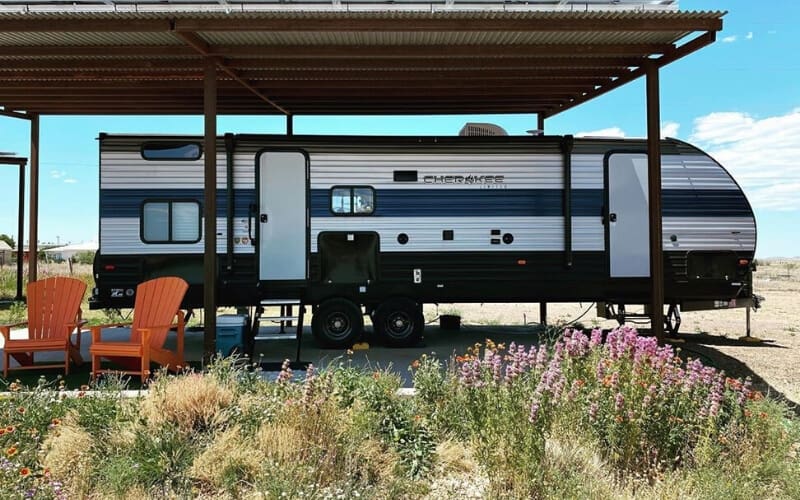

Average Height Of An RV (With 15 Examples)
- Last Updated: May 23, 2024
- 12 minutes read
When driving an RV, size is a big consideration. Many people just think about the length of the RV when determining the maneuverability of the vehicle, but height is also important.
You won’t be able to pass under low-clearance bridges, or enter some parking lots or drive-throughs with an RV that’s too tall.
So, how tall is an RV? Most RVs are about 10 to 14 feet tall, 8.5 feet wide, and between 20 to 45 feet long.
In many cases, the average height of an RV will depend on the class, Here are the breakdown of different types RVs and their average height .
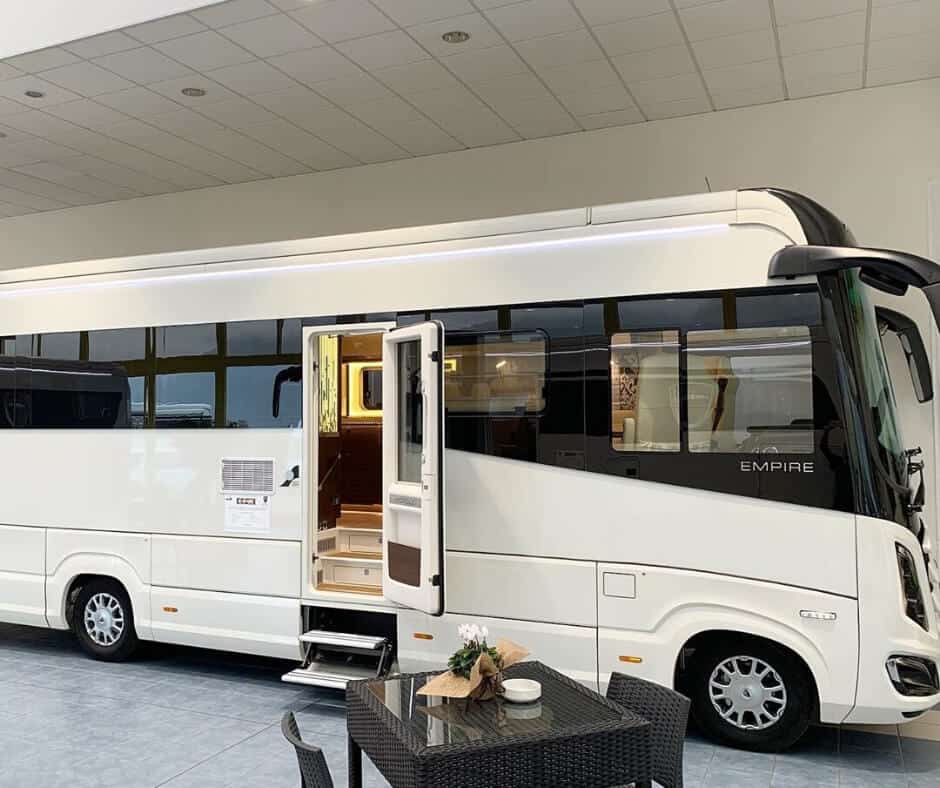
Now that you’ve seen the averages, I thought it would be helpful to provide some examples of different models for each type, and their associated height.
But first, let’s discuss the regulations for RV heights and bridge clearances across the country.
Federal and State Regulations on RV Height
Even if you have an RV that’s on the taller side, luckily, the Federal Highway Administration has set minimum clearance requirements for bridges and other structures.
Bridges over interstates must have a clearance of at least 16 feet, and the clearance must be at least 14 feet over roadways in both urban and rural areas.
Although there’s no federal maximum height regulation for recreational vehicles, states have their own laws and restrictions.
For example, in Georgia, the maximum height of any vehicle (commercial or recreational) is 13.5 feet.
So, be careful if you have a taller Class A motorhome and you plan to be traveling through Georgia or Eastern U.S. states with similar regulations.
You’ll be fine on or near the interstate, where the maximum height is 14 feet, but you might run into trouble elsewhere.
Some Western U.S. states are more lenient, with Colorado and Nebraska allowing a maximum vehicle height of 14.5 feet. Alaska is the most flexible, with a maximum of 15 feet.
How Tall Is The Average Class A Motorhome?
Class A RVs are usually the tallest types of motorhomes, with an average height of 13 feet, 6 inches. Some have a total of 14 feet in height, and may be even taller with an air conditioning unit or satellite dish on top.
Let’s talk about a couple of real examples.
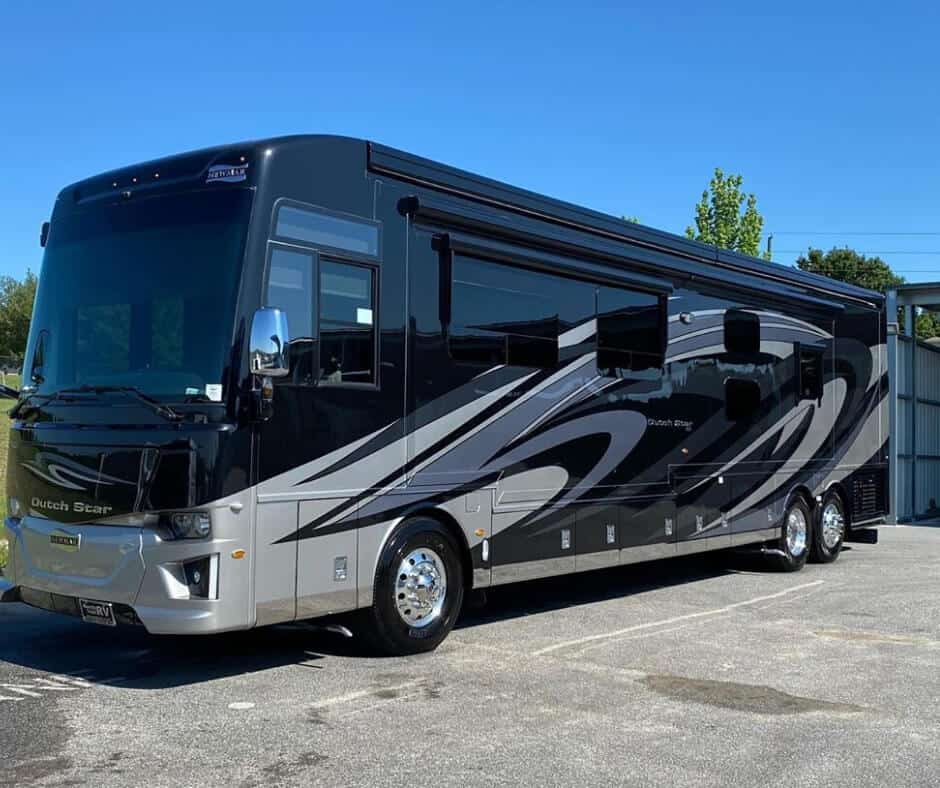
1. Entegra Coach 2020 Cornerstone – 12’ 11”
As a luxury Class A motorhome with a diesel engine, the Entegra Coach 2020 Cornerstone will have you traveling in the peak of comfort.
There are six different floorplans available, and they all have a total exterior height of 12 feet, 11 inches (including the A/C and satellite). The interior height is 84 inches, or 7 feet.
2. Fleetwood RV Flair – 12’ 4”
There are five different floorplans available for the Fleetwood RV Flair model.
This Class A motorhome has a nice interior height of 82 inches (over 6 feet), and an exterior height of 12 feet, 4 inches.
It also has the unique addition of a drop-down queen bed in the hide-a-loft over the driver’s cabin.
3. Newmar Dutch Star – 13’
With over a dozen different floorplans to choose from, the Newmar Dutch Star Class A motorhome has something for everyone.
The lengths range from 37 feet to 43 feet long, and most have an exterior height of 13 feet, although some models are 12 feet, 10 inches tall (3709, 3717, and 3736).
All Newmar Dutch Star motorhomes have an interior height of 83 inches, just under 7 feet.
How Tall Is A Class B Motorhome?
Class B motorhomes are the smallest RVs available, and usually come in at 20 feet long or less, with an average exterior height of 7-9 feet and an average interior height of 6 feet, 3 inches.
Camper vans often fall into the Class B specification for RVs, and offer a more compact and maneuverable home on wheels.
Here are some Class B RV models to give you an example of what’s available in terms of height.
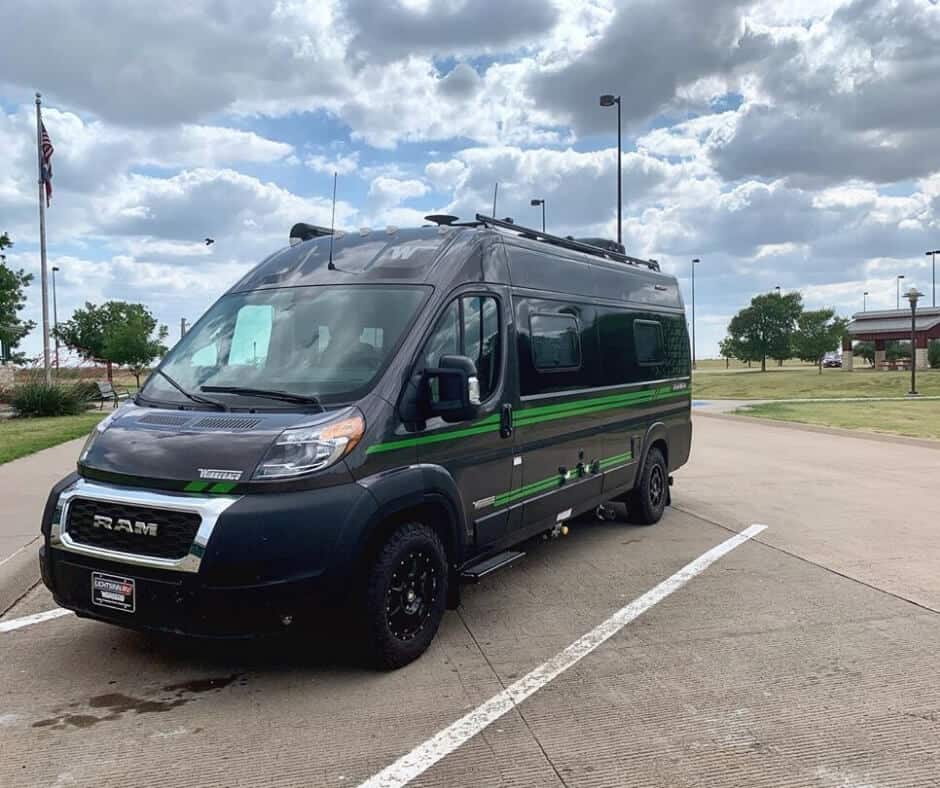
1. Pleasure-Way Ontour 2.0 – 10’
The Pleasure-Way Ontour 2.0 Class B RV is under 20 feet long and is built on a Ford Transit 2500 Van Chassis.
Including the A/C, it has an exterior height of 10 feet. Its interior height is taller than most Class B motorhomes, coming in at 6 feet, 6 inches.
Despite its small size, it has everything you need including a wet bath and a fully-equipped kitchen.
2. Regency RV National Traveler – 9’ 4” to 9’ 9”
The Regency RV National Traveler is a bit longer than the Ontour, with an exterior length of 20 feet, 11 inches.
There are three different floorplans, which range in exterior height from 9 feet, four inches to 9 feet, 9 inches (112 – 117 inches).
Two of the three layouts only sleep two, but the Explore plan sleeps four with a 50 x 65-inch Euro bunk above the convertible dining and living area.
3. Winnebago Travato – 9’ 4”
With four different floorplans, the Winnebago Travato can sleep two or three people, depending on the design you choose.
All of the models are 21 feet long, 9 feet 4 four inches tall in exterior height, and 6 feet 3 inches inside.
Each of the Winnebago Travato vans has a flex bed system, full wet bath, and fully equipped kitchens with extendable counter space.
What Is The Average Height Of A Class C Motorhome?
Class C motorhomes fall between Class A and Class B RVs in size, with varying lengths and average heights of 10 to 11 feet tall, although the three examples I’ve listed here are all a few inches over 11 feet tall.
The key difference with a Class C motorhome is the overcab loft which normally includes a secondary sleeping area.
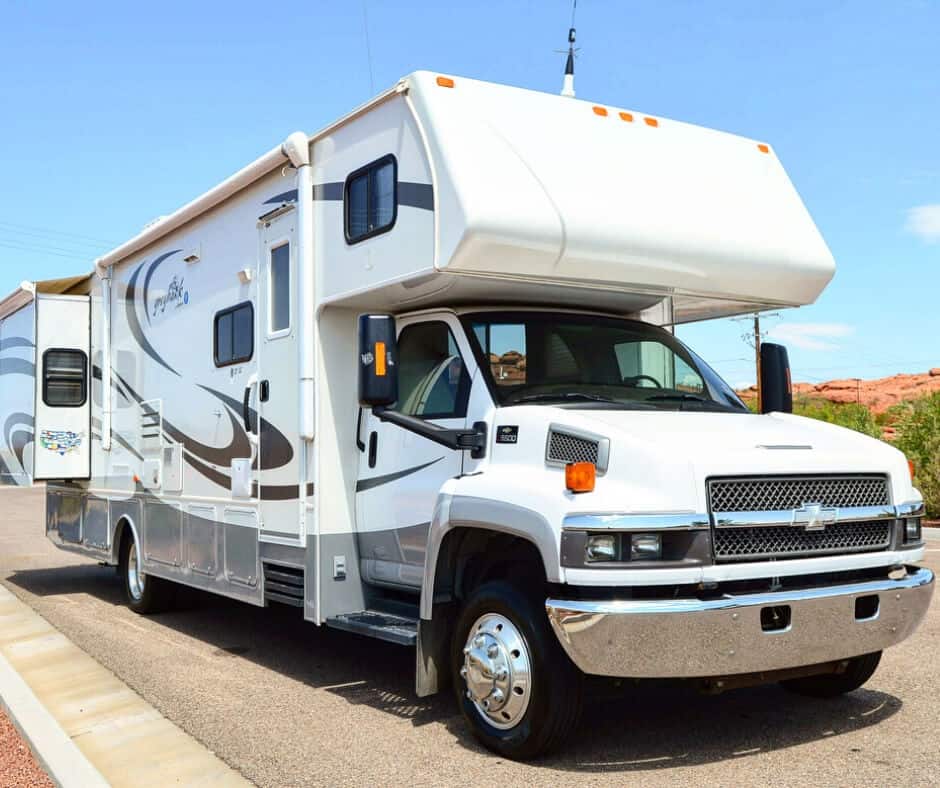
1. Forest River Forester Classic – 11’ 3”
Forest River has a couple of Class C RV brands, and their Forester Classic offers nine different floorplans to choose from.
Based on either a Ford or Chevy chassis, these models have an exterior height of 11 feet, 3 inches, and are at the taller end of Class C RVs.
The Forest River Forester Classic sleeps 6-10 people, depending on the model you choose, and the 3271S even has a bunkhouse. Some models even have a fully-equipped outdoor kitchen.
2. Jayco 2020 Greyhawk – 11’ 8”
Another Class C RV that’s a little bit taller at 11 feet, 8 inches (including the A/C) is the Jayco 2020 Greyhawk.
There are six floorplans to choose from, but all have a higher interior at 84 inches (7 feet), so they are all nicely spacious for taller individuals.
The 31F also has bunk beds to accommodate more people with dedicated sleeping space.
All of these models have lots of storage throughout, so that your personal items and adventure gear can all be stowed securely when you’re on the move.
3. Winnebago Vita – 11’ 7”
Two floorplans allow you to choose your preference for the master bed size and interior space in the Winnebago Vita, with the 24P including a queen-sized bed and a large side slide-out.
Both models have an exterior height of 11 feet, 7 inches including the air conditioning unit. Inside, the Winnebago Vita has an interior height of 7 feet, for plenty of headroom.
The Winnebago Vita offers the largest batteries available in a Class C, paired with 200-watt solar panels to keep you powered up even when you’re not hooked up in a campsite, so it’s great for boondocking or more rugged camping locations.
What Is The Average Height Of A Travel Trailer?
With so many different brands and styles of travel trailers , there is a wide range of sizes to be found. Generally, travel trailers have an average height of 10 – 12 feet tall . Teardrop and tent trailers often have a significantly lower travel height, and may even be shorter than your towing vehicle if it’s a larger SUV.
However, standard travel trailers and Airstream trailers typically follow the general average of between 10 and 12 feet in height.
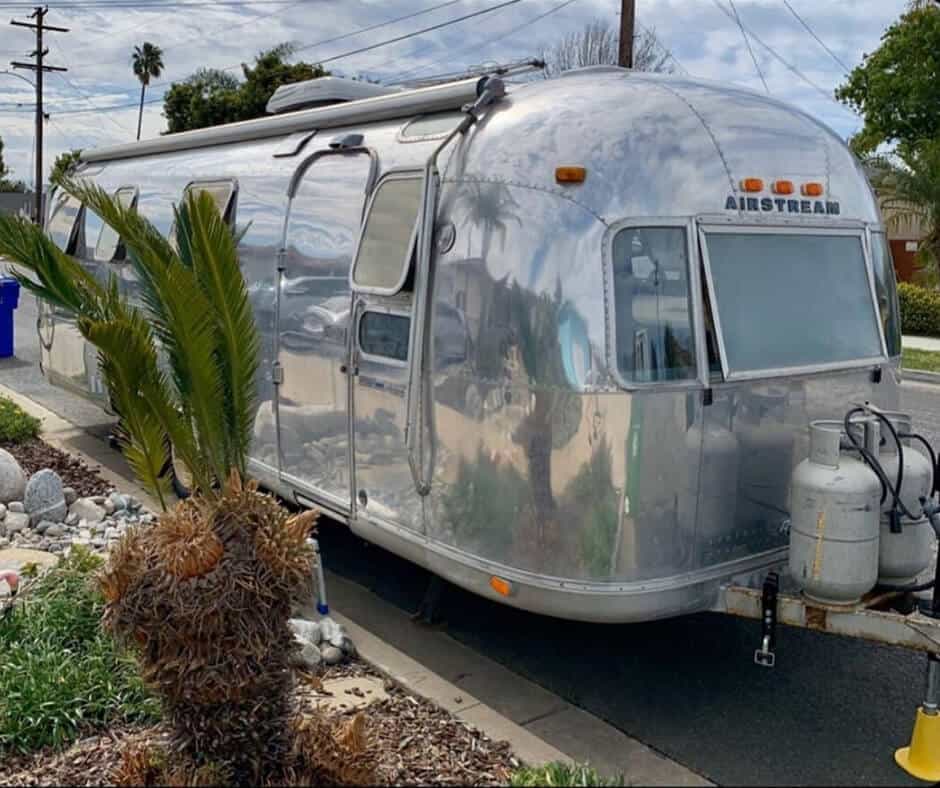
1. Airstream Classic – 9’ 9.5”
The Airstream Classic is the iconic “silver bullet” travel trailer that adventurers have enjoyed for decades.
It comes in at a slightly shorter height than most travel trailers, at 9 feet, 9.5 inches. However, it’s still comfortable inside even for taller travelers, with an interior height of 6 feet, 7.5 inches.
There are four floorplans available, depending on length and whether you want a queen bed or two twin beds in the main bedroom.
2. Forest River Cherokee – 11’ 1”
Toy haulers excluded, there are over 20 different Forest River Cherokee travel trailer floorplans available.
All of them have an exterior height of 11 feet, one inch. Choose from floorplans with a bunkroom, full second bedroom, large living area, front or rear kitchen, and more.
Many models have an outdoor kitchen, and as many as three slide-outs to expand your interior space when parked in your campsite.
3. Keystone RV Premier Ultra-Lite – 11’ – 11’ 4”
With eleven different floorplans to choose from, you’re sure to find the perfect Keystone RV Premier Ultra-Lite layout for your needs.
Most of the models are 11 feet tall, but some of the larger ones are as much as 11 feet, 4 inches. The headroom in the living area is quite nice as well, at 6 feet, 11 inches.
The majority of the floorplans can accommodate up to six people for sleeping, although some, like the 19FBPR and the 24RKPR, only have sleeping space for up to four.
What Is The Height Of An Average Fifth Wheel Camper?
Fifth wheels are some of the largest and heaviest travel trailers, and often feel like a full-sized residential home with all of the space they offer. However, they can compete with Class A motorhomes with regard to height, and average 11 to 13 feet tall.
One thing to keep in mind with fifth wheel RVs is that the front of the trailer is often raised to offer a standing-height room above your trailer hitch, which may significantly increase the highest point of your fifth wheel.
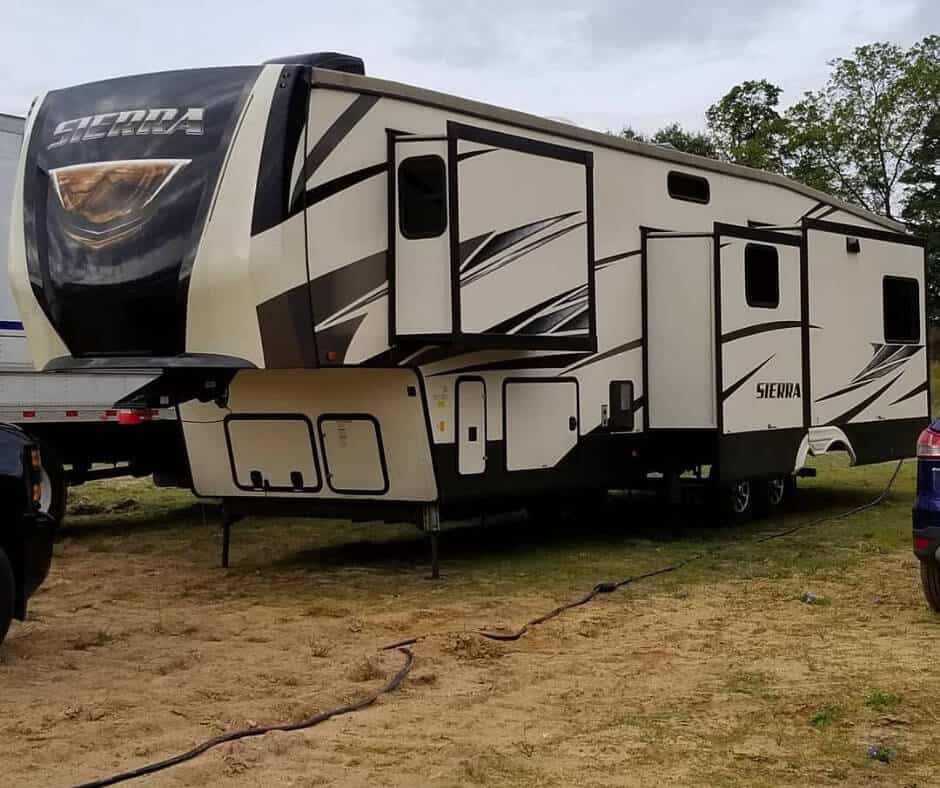
1. Forest River Sierra – 12’ 10” – 13’ 5”
With well over a dozen different floorplans featuring front or rear living and entertainment spaces, a bunkhouse or second bedroom/office, outdoor kitchens, and more, you can take your pick with Forest River’s Sierra fifth wheel models.
The exterior height of these fifth wheel RVs ranges from 12 feet, 10 inches to 13 feet, 5 inches.
The taller models are at the higher end of RVs available, but still come in at well under the 14-foot maximum in many states.
2. Grand Design RV Solitude – 13’ 5”
Select from over 15 different floorplans available with the Solitude fifth wheel from Grand Design RV.
These fifth wheels are designed for luxury and extended stays, built with high-quality, durable materials and residential-style finishes in beautiful, thoughtfully-designed layouts.
The Solitude is another fifth wheel on the taller end of trailers available, at 13 feet, 5 inches in total exterior height.
You’ll have plenty of room to stand up inside the Grand Design Solitude, with 8 feet of interior headroom.
3. Northwood Arctic Fox Grande Ronde – 13’ 5”
Spacious, residential-style living areas are a priority with the Northwood Arctic Fox Grande Ronde fifth wheel trailers.
There are six floorplans available, which range in length and interior layouts and features, although they all have an exterior height of 13 feet, 5 inches.
Although the longer models (just under 40 feet) have a lot more space, these fifth wheels from Northwood only accommodate up to four for sleeping, and are better for couples or small families.
Tips for Figuring Out the Height of Your RV and Driving Safely
You can find the actual height of the RV you’re considering in the specifications listed on the brand or manufacturer’s website.
But there are some key things to consider:
- Measure your RV’s height yourself, and don’t rely on the owner’s manual or the manufacturer’s website – it might be off.
- Don’t just measure from the roof to the ground. Find the highest point, such as the top of the A/C unit or satellite, and measure from there. You’ll want to take into account anything on the roof of your RV which could get in the way in a low-clearance situation.
- Always take measurements when your travel trailer or fifth wheel is hooked up for towing, since you’ll need to know the clearance when driving vs. parked.
- Make yourself a label or sticker that shows the clearance height you measured, so that you don’t have to rely on your memory if you come across a clearance that might be close to your limit.
- Use your GPS’ pre-programmed low-clearance points, and map your route accordingly. Your RV may already be equipped with a GPS system that takes low-clearances into account, but you might need to use other applications or routing systems, especially if you have an older RV.
- Don’t ignore clearance signs, and don’t trust them, either. Repaving can take as much as six inches off of the clearance, and the sign may not have been updated since the last repaving was done. Remember, some campgrounds have signs or arches at the entrance, so call ahead to confirm that you’ll be able to enter with your vehicle.
- When in doubt, find a different route. It’s far more worth it to spend the extra time and gas than to have an accident.Remember, you’ll be responsible for any damage you cause to bridges or other public structures, even if the posted clearance is incorrect.You wouldn’t want to ruin your road trip or your adventure vehicle with a costly (and dangerous) accident.
Summary About Average RV Heights
In general, the average height of your RV will depend on the size of the vehicle. Class A RVs and fifth wheels will tend to be larger and therefore taller, with an average height of over 13 feet tall. Meanwhile, most Class C RVs and travel trailers will be between 11 and 12 feet tall, and Class B motorhomes and camper vans will be the shortest at around 9 to 10 feet in height.
You’ll definitely find outliers, like Airstream travel trailers, which are below average at less than 10 feet tall.
And, although I didn’t cover any extremely tall Class A motorhomes or fifth wheels in the examples on this list, they are certainly out there!
Just be sure that, with all exterior fixtures such as your air conditioning unit or satellite, your RV is 14 feet tall or less, and you should be just fine to travel the roads of the country worry-free.
Always keep the tips I mentioned above in mind, however, since you might find some low-clearance bridges or structures along the way, particularly in more rural areas that are further from the interstate system.
About Author / Aaron Richardson
Aaron Richardson is an expert RVer and the co-founder of RVing Know How. Aaron, along with his wife Evelyn, has been living and traveling in their Keystone Fuzion RV since 2017. Their adventures span across the country and beyond, including memorable RVing experiences in Mexico. Aaron's passion for the outdoors and RVing shines through in his writings, where he shares a blend of travel stories, practical tips, and insights to enhance the RV lifestyle.

5 Best 12-Volt Portable RV Air Compressor to keep your RV tires inflated while off-roading
Rv converter not charging battery: here’s how to fix that.

You Might Also Like

7 Port Aransas RV Parks With Waterfront View
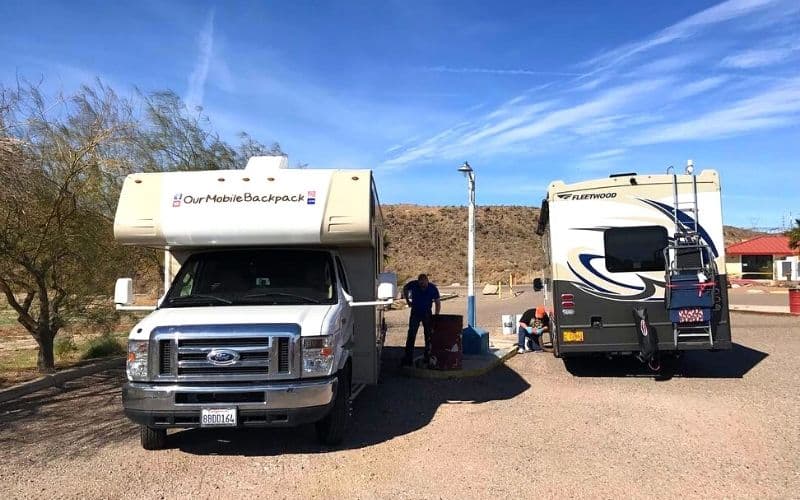
How to Find Free RV Dump Stations Anywhere in the U.S
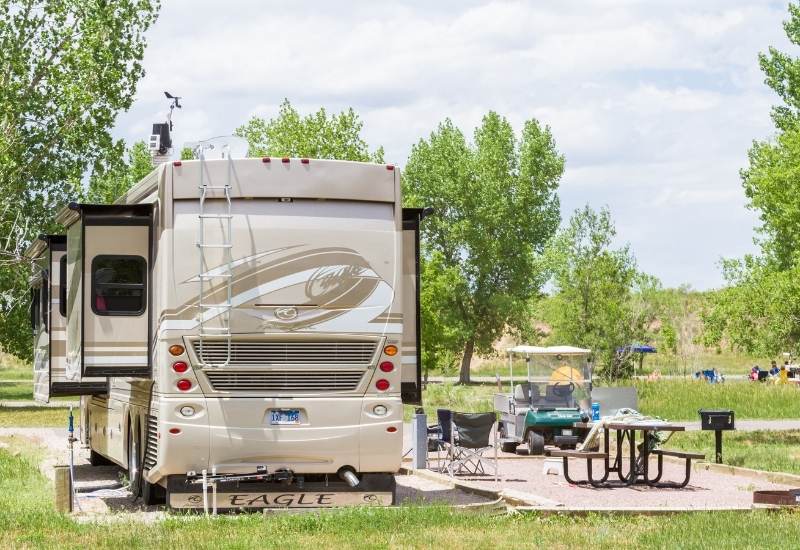
What Does “Full Hookups” Mean At An RV Park?
Start typing and press Enter to search

- Find a Location
Is There an Average Travel Trailer Height?
If you look around at all of the travel trailers on sale today, the exterior height of the trailer varies from model to model. However, most land somewhere between 10 and 11 feet high. Some travel trailers come with almost 12-foot high roofs, but that’s rare. Other travel trailers are far shorter than 10 or 11 feet. In general, the larger the unit, the higher the roof is.
A height of 10 to 11 feet allows most travel trailers able to go under bridges and overpasses with ease. With that said, you need to know the exact height of your RV and ensure that you pay attention when going under low bridges and overpasses.
On the flip side, the average garage door is about seven feet high. Some are higher, and more people are installing higher garage doors due to the fact that trucks and SUVs are getting taller. With that said, even a 10-foot tall garage door will likely not be able to accommodate your travel trailer, even if the length will fit.
It’s important to note that many travel trailers have racks, antennas, and air conditioning units placed on top of them as well. This means the height specified by the manufacturer may not be accurate for your rig. Before setting off, make sure you measure from the highest point of your travel trailer .
What About an Average Interior Height?

Travel trailers have lower ceiling heights than many other RV types. Many have six-and-a-half-foot ceilings. However, that’s not all units. RV manufacturers know that people like higher ceilings so, you should be able to find a travel trailer with a ceiling height up to or in some cases over seven feet.
Even with models with an 82-inch (six foot, ten inches) or higher ceiling, you need to be aware that the ceilings in slides won’t be as high. Some manufacturers do a good job of keeping their slides large. While others have slides with short ceiling heights. This sometimes isn’t that big of an issue due to the fact that many slides house seating, like chairs or sofas so you don’t actually stand inside them.
If you can’t find a travel trailer that has the exterior or interior height requirements you need, consider a fifth-wheel instead. There are many more fifth wheel RVs with higher ceilings and exterior heights than travel trailers.
How high are your travel trailer’s ceiling and exterior roof? Leave a comment below.
- Comment (1)
I can’t seem to find height of a 1977 Nomad trailer I’m purchasing, stationary in a trailer park, concerned about the kitchen, my husband is 6’2, it has a Hugh sunroom add on you step down in, any advice would help
Leave Your Comment Cancel Reply
Save my name, email, and website in this browser for the next time I comment.
Shop By RV Type

Your Adventure Awaits
Copyright © 2023 cwi, llc all rights reserved.
- RV Glossary |
- Privacy Policy |
- California Privacy Rights |
- Do Not Sell or Share My Personal Information |
- Targeted Advertising Opt Out |
- Terms of Use

Home » Guides » How Tall is a Travel Trailer? (And Why You Need to Know)
How Tall is a Travel Trailer? (And Why You Need to Know)

- Last Updated: May 24, 2024
Are you wondering exactly how tall a travel trailer is?
You’ve come to the right spot!
In this LearningRV.com guide, you will learn:
- How tall the average travel trailer is
- Why you need to know information like the height of your travel trailer
- And much more!

Table of Contents
How tall is a travel trailer.
A travel trailer is a great way to camp and see the nation while you are on a budget too limited for the purchase of a full RV. Of course, you’ll need a vehicle capable of towing a travel trailer, but overall it is quite easy to find a travel trailer that works for your family.
Travel trailers come in many different sizes, from small ones known as ham cans to ones that are as large as an RV. The average height of a travel trailer varies from 9 to 11 feet, and per the law, you will never find a travel trailer with a height above 12 feet.
As you can see, that is a wide average, and chances are you can find travel trailers far outside of the average when it comes to height. Read on to learn more about the average height of travel trailers and why you need to know the height of your travel trailer before you buy.
Why Do You Need to Know the Height of Your Travel Trailer?
Why it may seem strange to need to know the exact dimensions of your travel trailer , it is actually important for several different reasons.
Government Restrictions
Believe it or not, the government has restrictions on travel trailer height. These vary from state to state. Before you purchase a travel trailer, you should always check the restrictions in your state to ensure the trailer you plan to purchase isn’t too tall. These restrictions can be found on the DOT website .
Where do you plan to keep your travel trailer when you aren’t using it? If you are planning to keep it somewhere covered like a garage or covered bay, a travel trailer that is too tall will make this problematic.
Sometimes even campsites can restrict the heights of trailers due to wildlife or nature (like trees) that cover the campsite area. For most locations, you will be required to list your trailer dimensions when you book your campsite.
The number one reason you need to know the height of your travel trailer is for safety. The last thing you want to do is attempt to tow your travel trailer through an overpass that is too small. This could damage your trailer and cause injury to you or your family.
Once you know the height of your travel trailer, it is critical that you memorize it. Then, as you tow, you need to be on the lookout for signs where trucks may be unable to pass because of height. This happens frequently in mountainous areas where you need to pass through a tunnel.
The final reason you need to know the height of your travel trailer is for your own comfort. If you are an exceptionally tall person, a trailer with only 6 feet of clearance will likely be too small for you to be able to walk comfortably. Plus, you risk hitting your head as you move about the trailer.
For those lucky enough to be small, this likely doesn’t matter as much unless you have certain furnishings you want to install in your travel trailer. In this case, ensure you purchase one that is tall enough to fit all of your amenities.
Related >> How to Level a Travel Trailer

When You Should Measure Your Travel Trailer
Measuring a 12ft tall trailer is no easy feat, which may leave you wondering just when you should measure yours. The truth is, you should measure your travel trailer before you buy it.
If you are buying your trailer firsthand from a store or dealer, then, as long as you are shopping in your state, you don’t need to measure on your own. These measurements at the store are trustworthy, and an agent can help advise what size is best and legal in the state you live in.
If you are buying a travel trailer secondhand, however, you should measure the height yourself, even if you are buying from someone you trust before you buy. This is because you never know where that person bought the trailer, and while it may have been legal in another state, it might be just one inch too tall to be legal in your state. You also never know when the person last measured or if they did so accurately.
Is a Tall Travel Trailer Better?
For those who are tall people, a tall travel trailer might seem like a no-brainer because more room is better. But, be aware that tall travel trailers can often bring more stress as well.
Many bridges and tunnels are built to a minimum of ten feet in height. This means that if you get a travel trailer any taller, there is a chance that, at some point, your trailer will be too large to pass through a certain area.
So, unless you absolutely need the extra height to be physically comfortable, you’re probably better off buying a travel trailer 10’ in height or shorter.
Final Thoughts on Travel Trailer Height
No matter what type of travel trailer you are purchasing, it is absolutely essential to know its height.
So take a few minutes before you buy and check to make sure that your travel trailer is at a height that will let you experience all of the camping spots you wish to visit–and that it is legal in your state.
Learn More About RVing
Here are more resources to learn more about the RV lifestyle!

How To Level a Travel Trailer (2 Easy Ways)
Are you looking for an easy-to-follow guide on leveling your travel trailer? You’re in the
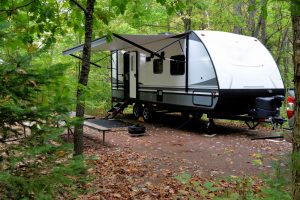
How To Make Travel Trailer More Stable
Are you someone who loves to travel, but hates the idea of having to rely

10 Simple Ways To Increase Your RV Refrigerator Efficiency
There is no reason your RV refrigerator can’t perform the same as a conventional refrigerator.

Leave a Comment Cancel reply
Recently published guides.

Buying a Generator for RV Life

RV Refrigerators: How Do They Work?

How to Repair Norcold Fridge Flap

How Tall Is A Travel Trailer? (Including State Laws)
Fortunately, most US states have regulations in place to ensure that the trailers can travel safely on modern highways. This is why the average height of a trailer trailer is 10 feet and is rare to find one that is over 11 feet in height.
Table of Contents
What Are The Average Dimensions Of A Travel Trailer?
While the average length of a travel trailer is around 25 feet (see “What Exactly Is A Travel Trailer,” below), a larger model can top out at 30 plus feet. A longer camper might be taller than the modest-sized ones, but it’s rare for the height to exceed 11 feet .
Is There A Limit To How Tall A Trailer Can Be?
Although there’s some variance in the law concerning trailer height as you move from state to state, 13 feet 6 inches is generally considered the maximum height.
If the unit is any taller than this, it might not be able to travel safely beneath overpasses or on certain highways with low clearance. When in doubt, check the laws for each state you’re planning to drive in. It will be far easier to rework your plans in advance than it will be to repair a damaged trailer because of a short bridge.
State Laws and Regulations
To make the process easier, we’ve compiled this list of US states and their maximum-height laws for travel trailers .
What Exactly Is A Travel Trailer?
Unlike traditional RVs, which consist of both a driving area (also known as a cab) and living space, a travel trailer is designed to be towed behind a vehicle.
While the classification is broad, the average height is around 11 feet. This keeps it well below the national standard for maximum truck and trailer height, which is just one of the reasons why this type of camping is appealing to so many outdoor enthusiasts.
Features & Benefits
A classic travel trailer combines the luxury of an RV with the convenience of a separate vehicle. You can drive your “home on wheels” to your designated camping zone, take the unit off the hitch, and head out for supplies or exploration unencumbered by the trailer.
This saves you the gas-guzzling hassle of towing a vehicle behind an RV.
While teardrop trailers and pop-up campers offer only the bare minimum of living space, travel trailers give you plenty of room to spread out.
Some of them are even equipped with slide-out features designed to provide extra living space without broadening the trailer’s footprint while in transit.
Sizes & Styles
It’s possible to buy a travel trailer that measures only 10 feet in length, which might be sufficient for single travelers or couples. As an added bonus, a trailer this small could probably be towed by a car or crossover vehicle.
Larger families should consider investing in one of the more generously-sized units— around 20 feet long . Take a good look at the configuration of the interior before making a purchase.
Is there enough sleeping space for everyone to relax and be comfortable at night? If you plan on “boondocking” (setting up camp independent of water and electricity hookups), re the bathroom accommodations sufficient?
These are questions that need to be answered beforehand; otherwise, you could be throwing your money away.
Warnings & Precautions
Note that travel trailers require compatible hitches in order to be transported safely. You should also make sure that your vehicle is strong enough to tow the trailer without causing damage to the transmission or engine.
If you have any questions in this regard, check the towing capacity (this could be listed on the VIN sticker or in the owner’s manual).
How Tall Is A Travel Trailer Compared To A Motorhome Or A Fifth Wheel?
Of course, all RVs are not created equal. To help you understand the differences, first let’s map out the basics.
Motorhomes fall into three separate categories: Class A, B, and C. Fifth wheels can often compete with Class A models in terms of length, but they don’t come equipped with their own driving controls. Teardrop trailers, meanwhile, are the smallest of the lot.
How tall is a travel trailer in comparison to the rest? Let’s find out.
A Word About The Differences
You might notice that the average height of a class C motorhome is significantly greater than the average for a class B. That’s because a class C is configured so that the driving space is separate from the living areas—similar to the way a pickup truck’s cab is separated from the bed.
The living space extends over the top of the cab, making it taller than the class B models, which are more like large vans outfitted with a kitchen, bathroom, and bedroom areas.
Does Taller Mean Better?
The answer to this one is dependent on several factors.
First of all, you’ll need to find a unit with a ceiling high enough to accommodate the tallest member of your party. Remember that most measurements will refer to the exterior height, which is significantly higher than the ceiling height.
This number is important because you’ll need to make sure your garage or storage unit has enough clearance (and that the unit complies with the regulations for the regions in which you’ll be traveling).
Check the specs for the interior height to determine whether everyone who travels in your RV will be able to move around it comfortably.
Fortunately, this shouldn’t be an issue for most folks, as the average ceiling height of a travel trailer is about six and a half feet. Higher ceilings are available if needed, but on average, a travel trailer will have a lower ceiling than a classic motorhome.
Another factor to take into consideration is your skill level when it comes to towing large loads. Units with higher ceilings will probably be longer and therefore more difficult to maneuver, so a travel trailer with a lower clearance level might be a better fit for drivers who are less experienced.
What Do I Need To Know About Hitch Height?
The hitch (sometimes referred to as the “trailer tongue”) should measure 18 inches off the ground when towing a travel trailer.
There may be some variation, depending on the size and configuration of your unit. If the trailer isn’t level, you’ll need to enlist the aid of a mechanic before you can safely take the rig out on the road.
Are The Signs Marking Bridge Height Really Accurate?
Plenty of drivers assume that if the sign says the bridge has 15 feet of clearance, any vehicle measuring less than 15 feet must be good to go. Unfortunately, that’s not always the case.
Interpreting Bridge Height Signs
States can differ when it comes to bridge height. Interstate bridges, for example, are supposed to be designed to allow semi-trucks–which have a height limit of 13 feet 6 inches–to pass underneath. However, not every state adheres to this policy, and many of these bridges may be lower as a result.
There is a policy stating that all federal bridges must have a clearance of at least 14 feet, but that doesn’t mean the bridge will actually have that much clearance when you’re driving beneath it. If the road was recently repaved, it could result in a couple of inches of lost clearance. This can make a big difference from year to year.
Moreover, there’s no law that says state and local bridges have to adhere to the federal policy. This is an especially worrisome issue if you plan on venturing beyond the major cities and into the wilderness–and why else did you purchase a travel trailer?
Further confusing the issue is the fact that RVs aren’t subject to federal size regulations since they aren’t commercial vehicles. This means that the state laws regarding maximum height (see the State Laws and Regulations table for more information) is all you have to rely on.
What You Can Do
What does this mean for you as the driver and owner of the travel trailer? Pay close attention whenever a clearance sign comes into view, and subtract six inches from the number listed, just to be on the safe side.
Also, remember that the clearance may vary from one part of the bridge to another. In most cases, the middle of the bridge will have the highest clearance level, but this may vary if you’re in a mountainous region.
How To Measure Your Travel Trailer
If you aren’t sure how tall your camper is, you can measure it yourself. While most dealerships will gladly provide you with this information, you might need a refresher if you purchased the unit a while ago.
Take Two Separate Measurements
You’ll want to know the base height of the camper, but it’s also a good idea to measure it again once it’s hooked up. Often, attaching the trailer to the hitch will increase the height, if only slightly.
Base Height
To measure the base height, check to make sure that the travel trailer is parked on a level surface. If one end is visibly higher than the other, your measurements won’t be accurate.
Use a tape measure to mark the distance from the highest point of the roof to the spot where the tires rest against the ground.
If necessary, you can enlist a second person to hold the end of the tape while you take the measurement.
Don’t be tempted to cut corners by measuring from the camper’s interior—that won’t give you an accurate reading, as it fails to take the roof into account.
Also, if there are any antennae, satellite dishes, vents, or even skylight features on your roof, include these in your assessment. As a rule of thumb, anything that could potentially alter the height of the roof should be taken into account.
Trailered Height
Once you’ve taken the base measurement, hook the trailer up to the vehicle you’ll be using to tow it. Make sure you know the proper hitch height before attempting to tow the trailer.
When you’re confident that the job has been done properly, measure the camper again from the highest point on the roof’s exterior to the place where the tires meet the ground.
If your travel trailer falls within the industry standard, you shouldn’t have to worry about excessive height. However, when it comes to outdoor adventures, there’s no such thing as too much preparation.
Best of luck, and happy camping!
Check out our article on: How Much Do Travel Trailers Weigh? (Camper Weight Chart)
Please keep in mind that we may receive commissions when you click our links and make purchases. However, this does not impact our reviews and comparisons. We try our best to keep things fair and balanced, in order to help you make the best choice for you.
As an Amazon Associate, I earn from qualifying purchases.


Travels with Ted
How Tall is an RV? A Complete Guide to RV Heights
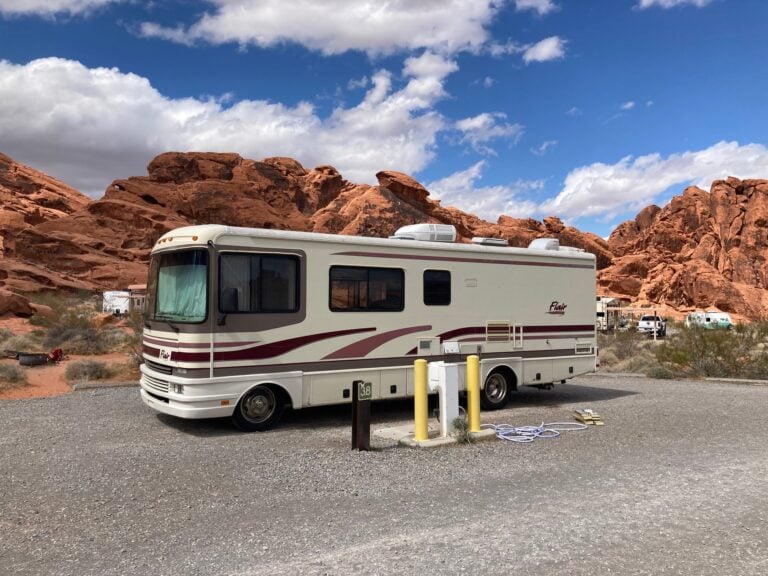
This post may contain affiliate links. See our affiliate disclaimer here.
How tall is an RV? There are a wide range of RVs on the market, and therefore there are a wide range of RV heights. If you are looking for average exterior heights, skip ahead to our summary of average RV heights .
If you are already an RV owner, it is critical to manually measure your RV to confirm its exact height. Never rely on the manufacturer’s stated exterior height as the actual measurement may vary because of appliances and hitches. See below to learn the correct way to measure your RV’s height.
- 1.1 How Tall is the average Class A RV?
- 1.2 How Tall is the average Class C RV?
- 1.3 How Tall is the average Class B RV?
- 1.4 How Tall is the average Fifth Wheel RV?
- 1.5 How Tall is the average Travel Trailer RV?
- 1.6 How Tall is the average Toy Hauler RV?
- 1.7 How Tall is the average Pop-Up Camper?
- 2.1 Why is it important to measure RV height?
- 2.2 How to Measure RV Height
- 3.1 Legal Maximum RV Height
- 3.2 How to Avoid Low Clearance Routes
- 4.1 Fuel Stations
- 4.2 Covered Storage
- 4.3 ATMs and Fast Food Restaurants
- 5 RV Interior Height
- 6.1 Average RV Length
- 6.2 Average RV Width
What is the Average Height of an RV?
The average height of RVs is between 10 feet and 13.5 feet. RV height varies by the type of RV. Class B RVs have the shortest average height of around 9 feet. Fifth wheels and Class A RVs are generally the tallest, maxing out at the legal limit of 13 feet, 6 inches tall.
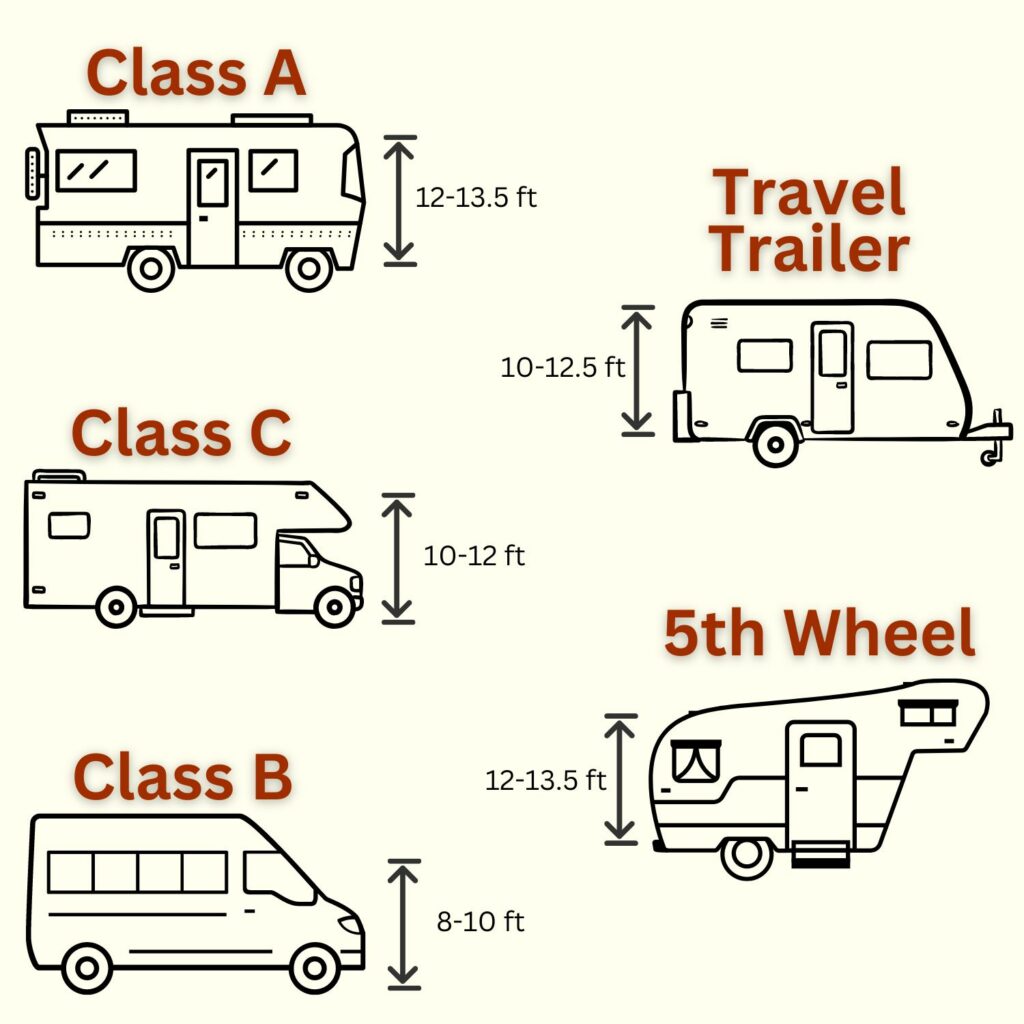
Below are descriptions of the average heights of each type of common recreational vehicle. The average heights listed below are based on measurements provided by RV manufacturers.
However, it is important to always take your own RV measurements to make sure your driving decisions are based on the actual RV height. For more details on different types of recreational vehicles, see our buyer’s guide to RV types .
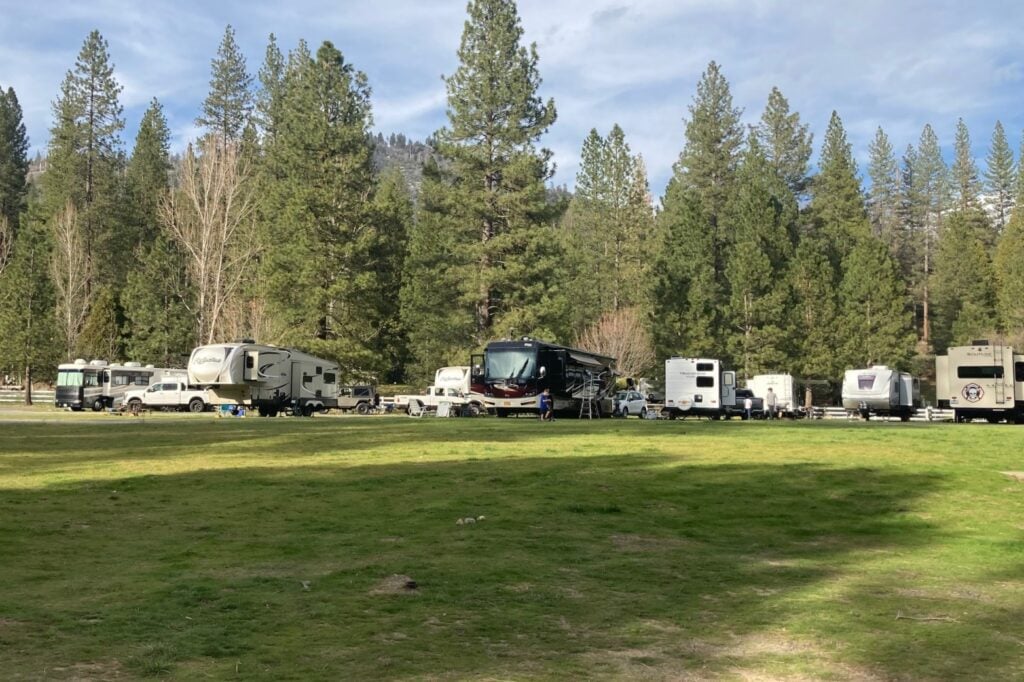
How Tall is the average Class A RV?
Most Class A RVs (or motorhomes) are between 12 feet and 13 feet 6 inches. For example, all of the current Winnebago Class A motorhome models are between 12 feet and 13 feet 3 inches.
Almost all Class A RVs will be less than 13 feet 6 inches, so they can safely pass under most bridges which the federal government recommends be at least 14 feet high.
How Tall is the average Class C RV?
Class C RVs are typically have an exterior height between 10 and 12 feet. For example all of the current Winnebago Class C models are between 10 feet 6 inches and 11 feet 7 inches tall. Class C motorhomes are generally shorter than Class A models.
How Tall is the average Class B RV?
Class B RVs (or camper vans) are the shortest type of motorhome. A typical Class B motorhome is between 8 feet and 10 feet tall.
For example, all of the current Winnebago Class B models are between 9 and 10 feet tall. Class B motorhomes are a great option for travelers who plan to travel back roads with potential low clearance obstacles.
How Tall is the average Fifth Wheel RV?
Modern fifth wheel RVs are generally between 12 feet and 13 feet 6 inches tall. For example, looking at all of the current year Keystone Fifth Wheels, their shortest fifth wheel is 12 feet tall while the tallest is 13 feet 6 inches.
Almost all fifth wheels will be 13 feet 6 inches or shorter, so they can safely pass under most bridges. Fifth wheels may be taller at the front section or nose, so the average heights listed are for the highest point of the RV.
How Tall is the average Travel Trailer RV?
Travel trailers are generally a bit shorter than fifth wheel RVs. The average travel trailer measures between 10 and 12 and a half feet tall.
For example, all of Keystone’s travel trailers on the market are between 10 feet 2 inches and 12 feet 4 inches tall.
How Tall is the average Toy Hauler RV?
Toy Hauler RVs feature a rear garage with a large door that also functions as a ramp. Because toy haulers are available in both fifth wheel and travel trailer styles, they come in a variety of heights from 10 feet all the way up to 13 feet 6 inches.
For example, all of the Keystone toy haulers currently on the market are between 10 feet 2 inches and 13 feet 6 inches tall.
How Tall is the average Pop-Up Camper?
Pop-up or fold-out campers have a solid base, with soft sides that expand to create additional space. Since pop-up campers are folded down while traveling, they are shorter during driving mode then when they are expanded for use.
Most pop-up campers are between four and five feet tall when closed. However, high wall models, such as the Forest River Rockwood Tent, are typically 6 to 7 feet high.
How to Measure Exterior RV Height
Why is it important to measure rv height.
All RV manufacturers provide their RV’s heights on their websites and in owner’s manuals. However, the published exterior height may not be an accurate representation of the RV’s clearance height while traveling.
First of all, some companies do not include the air conditioner or other rooftop appliances in the published measurements. In addition to the AC unit, solar panels, satellite dishes and roof racks many increase the RV’s height.
For fifth wheels and travel trailers, the RV may be slightly taller when hitched to the tow vehicle.
How to Measure RV Height
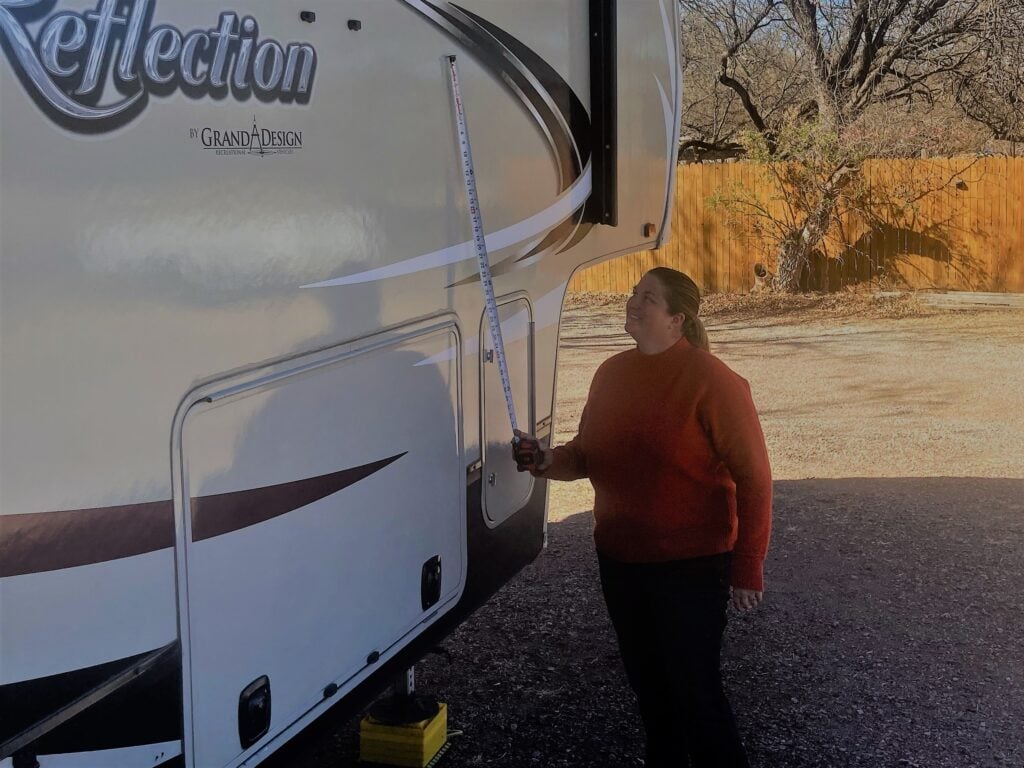
- Put RV in Travel Mode: For travel trailers and fifth wheels, hitch the RV to the tow vehicle exactly as you would on a travel day. For motorhomes, retract any jacks. All RVs should be on level ground for accurate measurements.
- Get on the Roof: Have someone who is comfortable accessing and walking on the RV roof, climb on top of the RV. There should be another person on the ground to assist with the measurement.
- Measure Height: Extend a tape measure or measuring tape between the person on the roof to the person on the ground. The RV height should be measured from the ground to the top of the highest point on the roof. Keep in mind, the highest point on the roof is usually the air conditioner and not the roof itself.
- Remeasure Height: Repeat the process of measuring the RV height from the other side of the RV. It is important to take the measurement twice to account for any differences created by unlevel ground.
RV Travel and Height Considerations
Legal maximum rv height.
The maximum allowable vehicle height varies by state. Most states have a maximum allowable height between 13 feet 6 inches and 14 feet. With a cap at 15 feet, Alaska is the only state with a maximum height above 14 feet.
Since most RV travelers will cross state lines, it is not advisable to purchase an RV over 13 feet 6 inches. The federal government also recommends that bridges on public roads have a clearance of at least 14 feet.
Even with the added height of the air conditioner, most RVs under 13 feet 6 inches will be able to clear standard height overpasses.
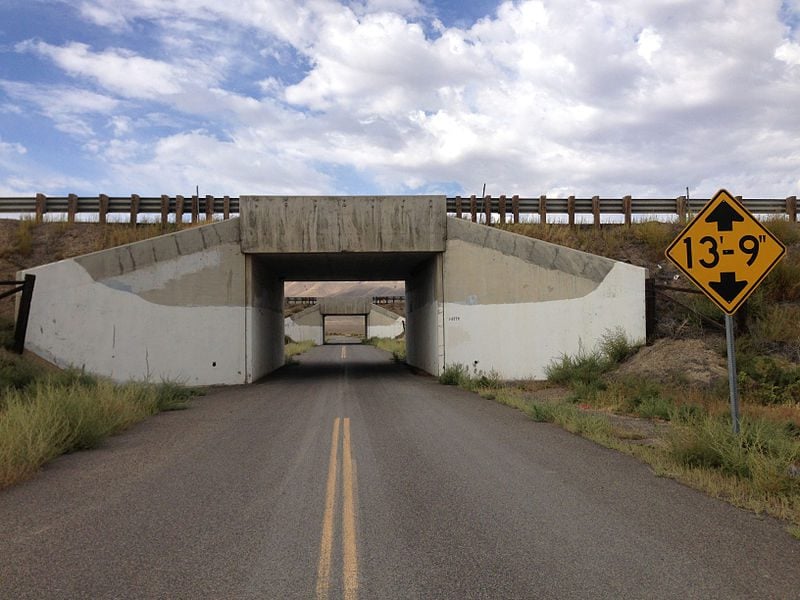
How to Avoid Low Clearance Routes
Although, the recommended minimum bridge height is 14 feet there are several roads in America with lower clearances. There are a few different ways for RV owners to check for and avoid low clearance bridges and overpasses.
- Buy an RV GPS : GPS navigation systems designed specifically for RVs and trucks can help drivers navigate around low clearance routes. The RV LIFE Pro GPS accounts for your RV’s size and weight when selecting a route and has warnings for low bridges. The RV LIFE Pro GPS is a smartphone app, so you don’t have to worry about updating the GPS software.
- Use a Road Atlas : For drivers who prefer an old-fashioned approach, a paper road atlas is also a great route planning tool. The Rand McNally Deluxe Motor Carriers’ Road Atlas includes truck routes and low clearance locations.
Regardless of what planning tool you use, pay attention to road signs and posted bridge heights. If you are unsure if your RV can safely pass under a bridge, pull over and find a different route. It is always better to be safe than sorry.
Also keep in mind that repaving can reduce the clearance height of bridges and overpasses by a few inches. Only drive under a bridge if your RV is at least a few inches shorter than the posted clearance height.
We once came upon an 11 foot clearance bridge after taking a detour off the interstate in Georgia to avoid traffic. Backing up down the narrow road was not our favorite RV memory, but it was better than taking out our roof and air conditioners.
However, it would have been even easier if we had pulled over and checked our atlas before proceeding with the detour. Lesson learned!
When RV Height Matters
In addition to passing under bridges, there are other situations where RVers should pay attention to their RV height.
Fuel Stations
Most gas stations have covers over the pumps to keep people and equipment dry and shaded. However, not all of these fuel station canopies were built with RVs in mind. Always read the clearance sign before trying to park at a regular gas station.
To be safe, RV travelers can use truck lanes or RV-specific lanes (available at Flying J gas stations) that have higher canopies or no cover at all.

Covered Storage
Storing an RV in an enclosed space is always a good idea. RVs stored inside will be protected from the natural elements, such as weather and rodents. A standard garage door is only 7 feet tall, so most RVs cannot be stored in a residential garage.
Instead, RV owners who want to store their RV in a covered and enclosed space will need to find a specialty storage facility or make use of a pole barn or other oversized garage.
ATMs and Fast Food Restaurants
Many drive-up ATMs and fast food drive-thru lanes also have canopies. While most owners of larger RVs know to avoid these situations, some drivers of Class Cs and other small RVs may try to access these roadside amenities.
Always check the clearance height before using an ATM or drive-thru. To be extra safe, it is better to park and order inside or use a walk-up ATM.
RV Interior Height
Interior ceiling height is another key consideration when purchasing an RV. Tall people may not be able to stand up straight in all RVs. Typically, Class A motorhomes have the highest interior ceiling height.
Most Class As have interior ceilings that are about 7 feet high, so they are tall enough for almost everyone to stand up straight.
The rear portions of fifth wheel RVs also have very high ceilings (most are 8 feet), but the ceiling height is much lower in the front end or nose of fifth wheels.
The ceiling height in travel trailers varies greatly between models. If you are looking for a travel travel with sufficient headroom for a tall camper, consider the Dutchman Aspen Trail . The Aspen Trail features 82 inches (6 feet 10 inches) of interior ceiling height.
Other RV Measurements
When evaluating the size of your RV, there is more to measure than just the RV’s height. Be sure to measure your RV’s length and width as well.
Average RV Length
The length of RVs varies even more than the exterior height. The exterior length of RVs ranges from tiny 12 foot long travel trailers to 45 foot long Class A motorhomes.
It is important to know the length of your RV, as many campgrounds (especially in national parks) have length restrictions.
While many private RV parks can accommodate all RVs, national parks and state parks often have campsites only allow RVs 35 feet long or less. Check out our full guide to RV size restrictions for more information.
Length also matters when driving. Many winding mountain roads will have maximum length requirements or recommendations. Always check maximum length recommendations when driving in the mountains or visiting national parks.
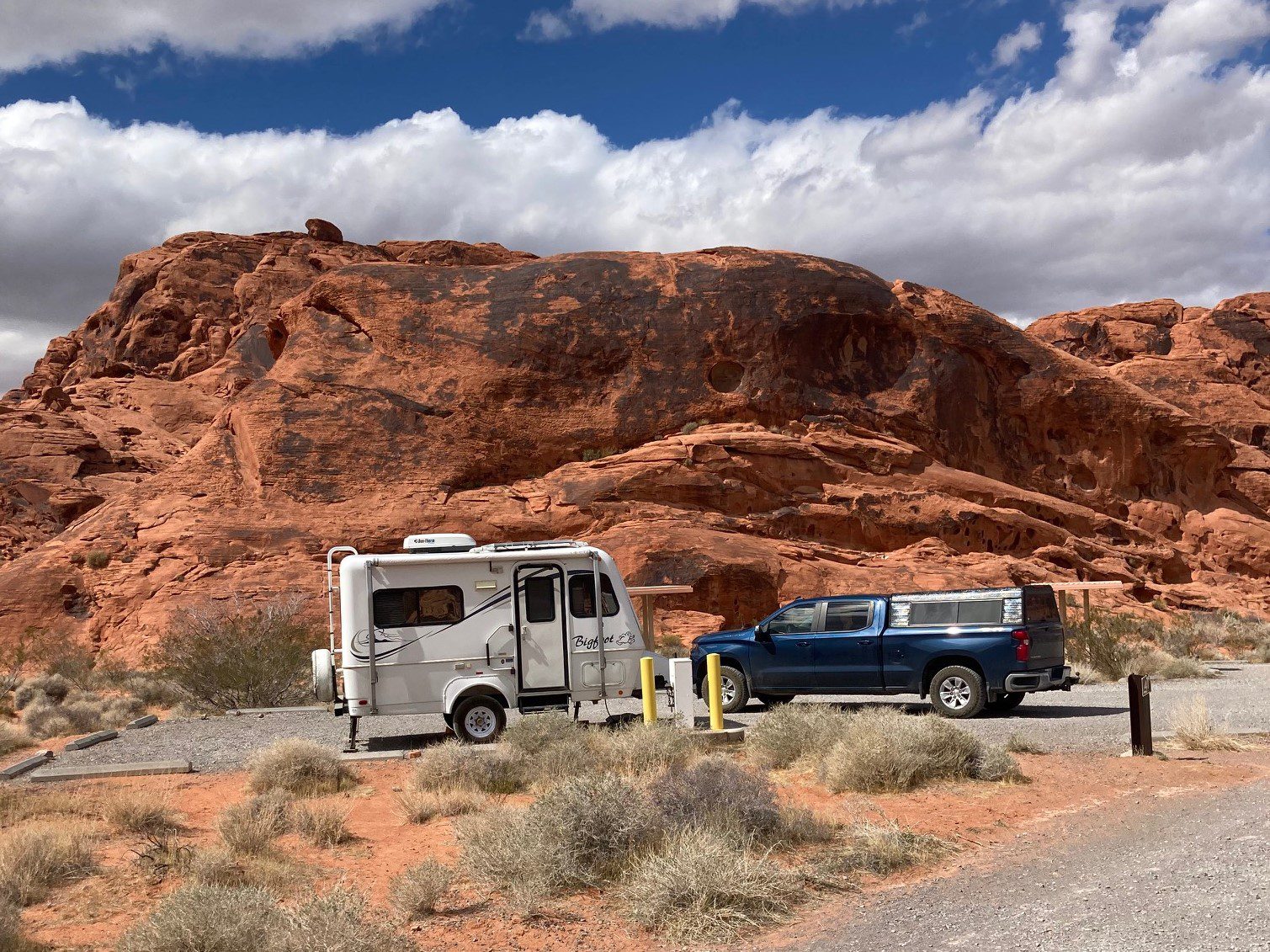
Average RV Width
There is less variation in average width as all RVs need to be able to travel within a standard single lane. In the United States, the Interstate Highway standards for the Interstate Highway System use a 12 foot standard lane width.
However, lanes on lower classification roads may be narrower. Most RVs are between 8 and 10 feet wide, so they can easily travel on interstates and most other roads.
However, all RV owners should know the actual width of their RV, so they can confidently know when the road is too narrow. Interior RV width is expanded in many RVs with the use of slide outs that are closed while driving.
When it comes to RV dimensions, always measure twice and plan ahead. Plan your route based on your RV clearance height, and never proceed if you are unsure if there is enough clearance. Turning around may not be fun, but it is better than risking your safety and your RV’s roof!
If you are new to RVing, check out our RV travel tips for beginners and our complete list of must have RV accessories . These guides will help you avoid typical rookie mistakes.
For more seasoned RVers, what is the worst obstacle you have encountered while driving? Have you run into low bridge clearances or other difficult routes? Share your story with us in the comments section below.

Christina Pate is a seasoned full-time RVer who, along with her husband Justin, has journeyed across the US, Canada, and Mexico. Drawing from her extensive travels, RV repairs and RV renovations, she founded Travels with Ted to guide and inspire fellow RV enthusiasts. Christina is also the co-author of The Owner’s Guide to RV Maintenance and the creator of My RV Log Book .
- Skip to main content
- Skip to secondary menu
- Skip to primary sidebar
- Skip to footer

Jeffsetter Travel
Travel Consultants and Travel Tips
How To Choose The Ideal Travel Trailer Size (With Size Chart)
May 26, 2023 by Stephanie Lane

All of our reviews are based on exhaustive research, industry experience and whenever possible, hands-on testing. When you make a purchase using one of our chosen links we’ll get a small percentage of the proceeds. This supports the site and keeps Jeffsetter running. You can read more here .
If you are in the market for a travel trailer and don’t know where to start, then you’ve come to the right place. A travel trailer is a great option if you are interested in having added comfort and amenities while you camp. It can be really hard to figure out what to buy though because there are so many options on the market.
The term travel trailer seems to encompass so many different things. They come in different styles and sizes, it’s hard to narrow down what is going to be ideal for you.
So, how do you choose the ideal travel trailer Size for you?
The ideal travel trailer size for you will depend on your unique travel situation. Generally, a travel trailer should be under 27 feet in length in order to access more parks and campgrounds. That being said they can come as small as 8 feet long to over 40 feet long and any size in between.
This article will explore all the different sizes available, why size matters and should be taken into your consideration, and how to pick the perfect travel trailer for you.
What Is A Travel Trailer?
Travel trailers are the most common type of RV found on the road. They are also known as bumper pulls and are hitched to your vehicle and towed to campgrounds or parks. They offer sleeping accommodations and usually have at least some type of kitchen. Some people might even choose to live in their travel trailer full-time !
The trailer itself is usually equipped with a living space and amenities. These amenities will differ depending on the exact model you have but usually include sleeping quarters and kitchen space. The larger the model, the more amenities it will likely have. They are great options if you enjoy camping or travel and do not want to have to pay for accommodations.
Travel trailers come in many different shapes and sizes, each with its own set of amenities and qualifications. Because there are so many options on the market, it can be hard to narrow them down to find what’s best for you and your needs. We will help make sense of all the different options out there and give you a method to figure out which one is ideal for your situation.
Why Does The Size Of My Travel Trailer Matter?
You might wonder why the size of your travel trailer even matters – you just want the one with the most amenities anyways, right?
Not necessarily. There are a few factors to consider when it comes to the size of the travel trailer that will work best for you. The most amenities might mean the largest and you may not have the space to store that or the capabilities to tow it .
If you tend to go the opposite way and want the most simple one on the market, you may end up stepping on the toes of your partner or your children which won’t lead to an ideal vacation for anyone.
The size travel trailer you pick matters for a lot of reasons, let’s explore some of them together.
Reason 1: Towing Capacity
You need to ensure that the vehicle you drive has the towing capacity necessary to actually move the trailer from point A to point B. The weight and length of your travel trailer will affect how it moves behind the tow vehicle.
In addition to making sure that it’s physically possible to tow, you should make sure that you are comfortable towing it. If you’ve never towed anything behind your vehicle before, it will take a bit of getting used to and maybe even some practice. The larger the trailer, the more adjustments you will need to make to how you normally drive .
Reason 2: Storage
Ensuring that you have the space to properly store your travel trailer is a must. It’s not a small investment to make, and maintenance of your travel trailer is of the utmost importance to get the most bang for your buck over time.
Measure your storage space before making the commitment to a new trailer.
Reason 3: Park Access
Plenty of RV parks and campgrounds will have size restrictions and won’t allow you to stay there if your travel trailer is too large. This can become a hassle while traveling and make it difficult for you to find a place to stay.
Before you purchase a travel trailer, do a bit of research about the places you want to stay and visit. That way you can find the campsites in those areas and see what sizes they do and don’t allow.
If you want to avoid drama on a road trip, I recommend double-checking these specifications every time you go on a trip so that you don’t end up with nowhere to park your travel trailer for the night.
Reason 4: Road Safety
We’ve all passed signs that notate the maximum height allowed when driving underneath a bridge, overpass, or inside of a garage. Making sure that you are familiar with the size of your travel trailer is necessary to keep from damaging it or the overpass if you don’t fit underneath when trying to pass through. Not only is that an embarrassing situation, but it can also be a costly one as well.
Don’t forget that weight limits might also apply to your travel trailer depending on the situation!
Reason 5: National Parks
If you are purchasing a travel trailer with the intent of seeing the National Parks, then you should keep the length at or under 25 feet . Most National Parks have a limit to what they allow in their parks which is between 25 and 30 feet in total length.
You will also be likely navigating through roads that are unpaved, narrow, and hard to maneuver through. If the National Parks are on your bucket list, then I would make sure to keep all of this in mind before making your decision.
What Are The Different Travel Trailer Sizes Available?
There are plenty of travel trailers on the market and all of them are designed to suit different campers needs. There are micro trailers for the ultimate minimalist and luxury fifth-wheelers for the large family on the road . Each one is going to offer different amenities and has pros or cons depending on what you’re looking for.
Travel Trailer Size Chart
Below is a chart detailing the basic different sizes of travel trailers and how many people can sleep in them. There are ones on the market that are smaller than the chart shows, so we will also explain the different sizes on the market.
Large Travel Trailers
Large travel trailers are going to be at least 26 feet in length, up to about 40 feet long.
These trailers are typically designed with long-term camping in mind. If you are in need of a temporary home while camping, this is the best option because it gives you the most space to move around and live comfortably. This is also a good option if you’re traveling as a family because there are more options for sleeping accommodations.
Large travel trailers can typically only be towed by trucks that have a high towing capacity because of their size.
Mid-Size Travel Trailers
Mid-size travel trailers are going to run between 21 and 25 feet long. They are smaller than a full-size trailer, but not as tiny as their small and micro counterparts.
These offer a good amount of space for sleeping and moving around. This can suit a smaller family or a couple, but make sure you don’t mind being in tight quarters together before getting on the road!
These trailers can usually be towed by a larger vehicle like a van or a truck.
Small Travel Trailers
Small travel trailers are between 13 and 20 feet in length . They are going to offer some space for sleeping, a small kitchenette, and possibly a small area for dining, but it depends on the configuration you are looking at.
These travel trailers can definitely work for a couple but might feel a bit cramped if you add anyone else into the mix.
They can be towed by trucks and even some cars, but you double-check the specifications just in case.
Micro Travel Trailers
Another option on the market for the solo traveler or the ultimate minimalist is the micro or mini travel trailer. These are going to be the smallest options on the market and are usually between 10 and 13 feet long.
These can be used for cargo, recreation, or accommodation depending on the style. Some have a small kitchenette or outdoor kitchen, bunk beds, and other basic amenities. What amenities your micro travel trailer has really depends on the model you are looking at.
These can be towed by smaller vehicles like SUVs and cars, which can make them a good option if all you own is a car and not something heavier-duty designed to pull a larger trailer around.
What Is The Average Length Of A Travel Trailer?
The average length of a travel trailer is somewhere between 20 and 28 feet long. This makes sense based on everything we’ve stated about travel trailers so far.
The average size of a travel trailer offers maneuverability and makes it easier to travel since a trailer that size will be accepted at National Parks, RV parks, and campgrounds, while still giving enough space and amenities to feel comfortable and maybe even luxurious inside .
The most popular size of a travel trailer is 23 to 27 feet long, which is right in line with the average.
What Is The Ideal Length Of A Travel Trailer?
There isn’t an exact ideal length of a travel trailer, because the ideal really depends on the person traveling with it.
I would hesitate to say that there is a “best” or “ideal” size of travel trailer that you should be looking for but there are plenty of ways to figure out what your ideal is.
How Long Is Too Long?
The average and most popular length for a travel trailer is there for a reason.
Personally, I think a travel trailer that is longer than 27 feet can limit your overall travel experience. Longer than that, and you won’t get into a lot of U.S. State Parks and it can be difficult to plan trips because of this. It can also become a strain on your vehicle to tow something much longer than that.
Are There Length Restrictions?
There are length restrictions in some states in the U.S. These are usually found on the DOT (Department of Transportation) website for that particular state. Keep in mind that these measurements do not include the towing vehicle.
- Maximum length of 53 feet.
- Maximum length of 45 feet.
- Maximum length of 40 feet.
How Do You Measure A Travel Trailer?
Measuring a travel trailer isn’t rocket science, but you want to make sure that it’s done correctly. We’ve already gone over a few reasons why it’s important to know what size your trailer is such as making sure it will fit into storage and not hitting overpasses while driving underneath them.
Make sure to measure your travel trailer while it’s hooked up to the tow vehicle for more accurate numbers.
To accurately measure the height of your travel trailer it needs to be parked on a flat surface and you will need to have a tape measure long enough to reach the highest point. You will want to measure to the highest point from the ground. Make sure that your tape measure is straight and perpendicular to the ground for an accurate result.
To measure the width of your travel trailer, make sure all extensions are retracted and accessories are in their normal travel-ready positions. Look for the widest point of the trailer and measure across. The maximum width for a travel trailer is 8 feet 6 inches, having a trailer larger than that can result in tickets, fines, and penalties.
To measure the length of your travel trailer it should be parked on a level parking spot. Identify the front and rearmost points of your travel trailer and use a tape measure to measure the distance between the two. Keep your measuring tool as straight as possible to get the most accurate numbers possible.
The video below showcases a few tips and tricks to measure your travel trailer.
Is The Hitch Included In the Dimensions?
Not usually! If the hitch is included in the dimensions, it will likely be noted or specified for you. If it’s not specified then you can assume the hitch is not included in the dimensions of your travel trailer.
What Is The Maximum Height Of A Travel Trailer?
In the United States, there is a specified maximum height limit for any travel trailer. That height is 13 feet and 6 inches or 162 inches.
What Are The Most Popular Travel Trailers?
When you start looking into which travel trailer will be best for you, you will come across a handful of popular ones in your research. Popular things do tend to be popular for a reason, especially in respect to a product like an RV or travel trailer where buyers tend to do extensive research before making their purchases. Here we explore some of those popular options and what the pros and cons might be for each.
Teardrop Trailers
These trailers got their name due to their distinctive teardrop shape and are easily recognizable on the road. They tend to be popular because of their design, which is both minimal and stylish. These models usually have all the basic amenities you want while being on the smaller side. They tend to be 8 to 10 feet in length, which also makes them very easy to tow and maneuver.
- A great option for people who want that true camping experience
- Affordable because they are easy to maintain and have low insurance costs
- Lightweight so they are easy to tow around
- Very minimal living and floor space (not a great option for more than 2 people)
- Not designed with extreme weather in mind, so not useable all year round depending on where you live
A-Frame Trailers
A-frame trailers fold up flat, similar to pop-up trailers. When these trailers are set up they have a triangular shape, hence the name, A-frame. They have decent height due to their shape, but are still smaller in length coming in anywhere between 12 and 18 feet long depending on the exact model.
- It’s easy and quick to set them up
- They are lightweight , so they can be easy to tow and maneuver
- They are well equipped for all different weather, even colder temperatures
- They can be too tall for some places due to their height
- They aren’t designed to accommodate a large number of people
- They have limited options for customization
Standard Travel Trailers
A standard travel trailer is probably the image that pops into your mind when you read “travel trailer.” These are towed behind a vehicle and offer living space and accommodations inside.
They can be anywhere from 10 to 35 feet in length and can weigh anywhere from 2,000 pounds to 10,000 pounds. This means they are truly customizable to your needs. They are a very popular choice because of this.
- A wide range of options for amenities; full-sized kitchens, bedrooms, and bathrooms depending on the size you are looking for.
- Will offer enough storage and space for both convenience and comfort
- It will require a heavy-duty tow vehicle to tow due to weight restrictions
- Depending on the size you might have limitations on where you can park and stay
Fifth-Wheel Trailers
As the name suggests, a fifth-wheel trailer is designed to be towed by a fifth-wheel hitch. It is different from a standard travel trailer because it attaches to the bed of the tow vehicle and not just the rear hitch.
These tend to be on the larger side, coming in at lengths ranging from 22 feet to 45 feet. They tend to be the most luxurious options on the market with the largest number of amenities. They will usually have air conditioning, slide-outs for even more space, and generators.
- A luxurious way to travel with lots of amenities and features
- A large amount of space for many people to be comfortably
- Can only be towed by a sturdy pick-up truck or another heavy-duty towing vehicle
- The size makes it hard to maneuver
- The size can also affect where you are able to take your trailer and stay
Toy Hauler Trailers
These can also be called sport utility trailers. They are designed to have a built-in cargo area meant to haul “toys” like motorcycles, jet skis, or other large outdoor equipment.
In addition to this cargo area, they will also have a living space, though the size will be smaller because of the cargo area. Toy hauler trailers will usually come in between 20 and 40 feet long.
- They offer versatility and are a great option if outdoor recreation is your thing
- They also offer customization for your needs and amenities
- Their larger size can make them more difficult to tow and you need a larger tow vehicle
- The living space is smaller due to the cargo space taking up a large chunk of it
So, What Size Travel Trailer Should I Get?
Hopefully, after everything you’ve read, you have a pretty clear idea of what travel trailer is going to be the best for you to buy. There is a lot of information out there, and it can be hard to sift through all of it.
At the end of the day, the “best” travel trailer for you is going to be the one that will suit your travel needs. To make sure that you go with the right option, make sure to consider each point I’ve outlined below.
Length Of Travel
How long do you want to travel for?
Typically, the longer you intend to be on the road, the bigger the space you’ll want. You don’t have to go all out and get the largest trailer on the market, but make sure you get a trailer that is actually going to be comfortable for you and whoever you are traveling with to live and sleep in.
Storage Space
There are two questions to ask when thinking about storage space.
How much do you want to bring?
If you are not a light packer, then don’t get a trailer that doesn’t have enough space for all of your belongings.
How much space do you have to store your travel trailer?
If you have a large lot of land, an extra large garage, or a long driveway, you might not need to consider the space your travel trailer will take up when not in use. Most people do need to take that into consideration because you don’t want your trailer to be hanging into the street or unprotected during the off-season.
It Can Get Crowded
How many people are you traveling with?
It might be even more important to ask yourself how much you like the people you’re traveling with because regardless of the size of the trailer you get, it’s going to be smaller than a house and may feel cramped from time to time.
If you are traveling alone or with your partner, you do have more options and can go a lot smaller which has its benefits.
Vehicle Tow Capacity
Can your vehicle tow the travel trailer?
Unless you want to buy a new vehicle at the same time as you purchase a new travel trailer, you should make sure that your vehicle has enough power to tow the trailer you’re interested in. Many travel trailers require heavy-duty vehicles to tow them, so be careful if you have a sedan.
Parking Plans
Where do you want to take your travel trailer?
As we mentioned earlier on in this article, a lot of state, and national parks have limits on the length of trailers they allow inside. This can also go for run-of-the-mill RV parks and campgrounds. If you want to visit these places, you don’t want to get a travel trailer longer than 27 feet .
Mobility
How well can you maneuver the travel trailer?
Some of this depends on skill and some on where you plan on driving. If you are going to be on dirt and unpaved roads that are narrow with lots of twists and turns, a larger trailer is going to be inherently more difficult to maneuver around.
What Can You Afford?
This is an important question to consider before making any large purchase. Be realistic about your budget and understand that the larger the trailer, the more expensive it will be. Also keep in mind that if the trailer, even a smaller one, is highly customized or has a lot of amenities packed into it, the cost will be higher.
There are plenty of travel trailers on the market and the perfect one for you will be determined by what your travel needs are.
Sizes will vary, but each one will offer some amenities and give you the opportunity to get out into the great wide world for some adventure. The only rule of thumb I recommend going by is keeping your travel trailer under 27 feet long so that you have access to more parks and campsites. Otherwise, there are tons of different styles and types to pick from and each can be customized to suit your exact needs.
Important Links
- Advertising Policy and Affiliate Disclaimer
- Privacy Policy
- Contact Jeffsetter Travel Blog
- Ask Jeffsetter a Question
Recent Posts
- A Ritz-Carlton Hotel is Coming to Oahu
- Reminder: Earn 2x HawaiianMiles with Foodland!
- Alaska Air Visa Signature 2024 Review
- Alaska Air Offers Maui CARE Flights
- Hot Meals Return to Alaska Air Main Cabin!

Average Travel Trailer Heights
By: Author Couch Potato Camping
Posted on Published: July 25, 2022 - Last updated: December 18, 2022
Categories Camping Gear
Do RV heights include the rooftop Air Conditioner? What is the average exterior height of a travel trailer?
These are some of the questions we receive from new RVers all of the time. They are important and valid questions because the exterior height of your RV will be important to know for many reasons.
First, if you plan to store your RV either in your garage or a covered storage facility, you will need to know your RV’s total height. This is the measurement from a flat road surface to the highest point on your RV.
Second, when you start driving your RV, you will need to know the maximum height of your travel trailer for many reasons, including:
- Low road, highway, or railroad bridges
- Roads with low hanging tree limbs
- Campgrounds with low overhead entry signs
- Gas station roofs over the pumps
- Some entrances to Walmart’s and shopping centers
- Car wash stalls – for cleaning your RV at a self-wash location

The average exterior height range of travel trailers is between 9′ – 13′ tall with the average interior height ranging between 7′ – 8′ in height.
But you still need to know the exact measurement for your own rig.
Typically, the RV manufacturer’s exterior height – as listed on your RV’s specifications – does include the rooftop air conditioning unit.
However, it is in your best interest and good practice to personally validate your travel trailer’s actual exterior height since the rooftop air conditioner may not be the highest point on your trailer.
How to Measure Your RV Height
While it is great to use your travel trailer’s or RV manufacturer’s provided exterior height measurement, we suggest you measure your RV’s exterior height yourself for the most exact measurements.
Measuring Your Travel Trailer Height
You will need a tall ladder , a measuring tape, and a carpenters level (preferably 3 – 4 feet long). We suggest having two people for this effort.
One person will be on the ladder with the level holding the tape measure at the top of the RV and a second person at the bottom will hold the tape measure on the flat, hard surface.
Be sure to pull the tape measure taught for an accurate reading.
Park your travel trailer or RV on a flat hard surface (concrete or asphalt). With one person on a ladder, place the carpenters level on the highest point of your RV. Extend the level straight out perpendicular to the length of the trailer.
While keeping the level straight, the person on the ladder can then drop the tape measure down to the second person standing on the ground. The person on the ground can gently pull the tape measure taught to reduce any slack in the tape, then confirm the height measurement.
Take multiple measurements, 2 or 3 times at least, to confirm the height of your RV. This will ensure your measurements are the same or similar each time for a more accurate height.
If in doubt, always use the biggest measurement. It’s better to be safe than sorry when trying to pass under an overhang or bridge.
✳️ Looking for a Travel Trailer Under 2,500 Pounds? Check Out Our List !
Note Your Travel Trailer Height
Once you have confirmed the maximum exterior height of your RV, we suggest writing down this number and placing it in the cab of your tow vehicle in a location that is easily viewable or can be referenced visually from the driver’s and passenger’s seat.
As you know, when you’re driving down the road at highway or even city street speeds and you see a caution sign for a low bridge or overpass, you want to be able to reference your RV or travel trailer’s height quickly, without hesitation.
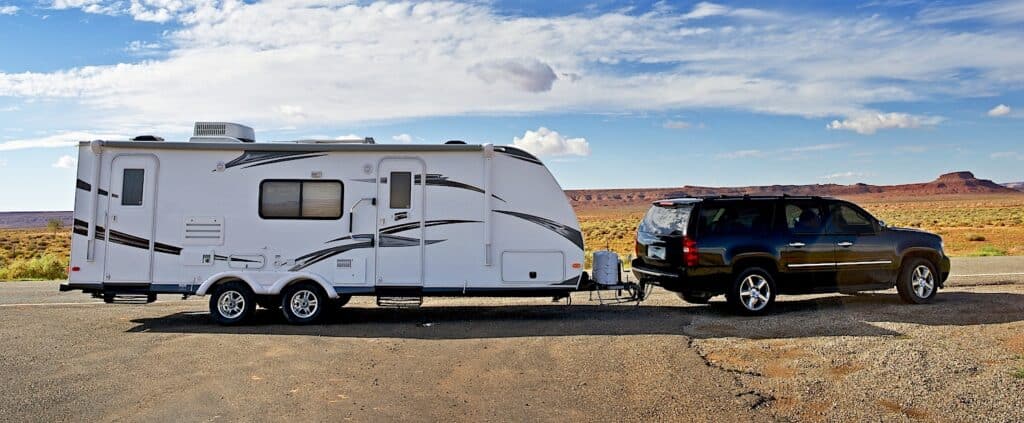
Travel Trailer Exterior Heights
For reference, here are the manufacturer’s travel trailer exterior heights of some of the more popular and well-known RV’s.
Knowing your travel trailer height is just one of the important things you need to do for safe travels. Be sure to see our other helpful guides:
- Make Sure to Have the Right Tire Pressure When Towing a Trailer
- Using a Water Flow Meter on Your RV
- Best RV Leveling Blocks
How Tall is an Average RV? (A Guide to Measuring Your RV and Avoiding Low Clearances)

About the Author
Tom Davidock
If you have a Recreational Vehicle (RV) or looking to purchase one, you may have wondered how tall an RV is. If you’re an RV owner, this is an important number you will want to know. Likewise, it may also be a specification you need to consider when shopping for an RV. RVs come in all different sizes , which include the RV’s height. Knowing the size of your RV, including height, weight, overall length, and width, will help you plan your trips and when on the road.
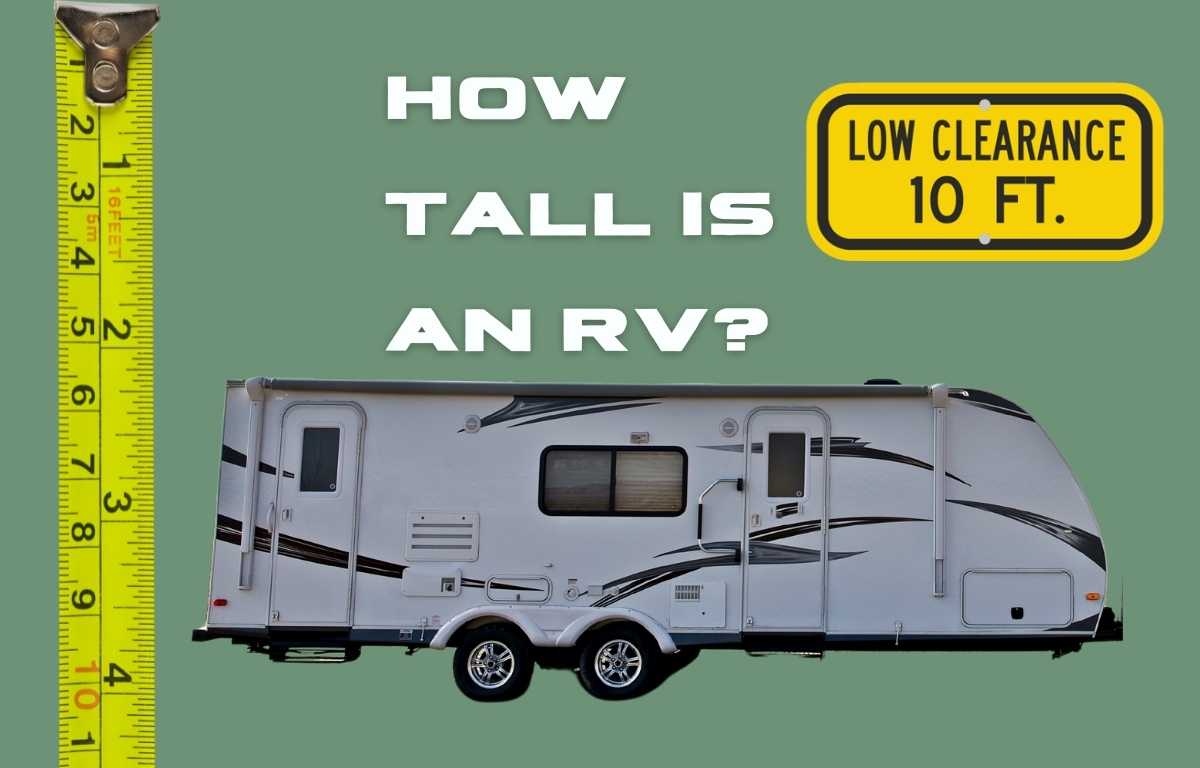
There are several reasons RV owners want to know the height of their RV, with the key reason being to ensure you don’t hit something while traveling. Luckily, most RVs are well within the specifications of most obstacles you’ll encounter on the road. However, the low clearance obstacles still exist, and you don’t want to wonder if you’ll clear them or, even worse, knock off your air conditioner while maneuvering through a tight spot. Knowing your RV height is one of the most important things you can do to prevent damage to your roof.
Average height of an RV
The average RV height largely depends on the type of RV. However, even similar style RVs can have vastly different heights. The only way to truly know the height of your RV is to measure it. This number is also usually available in the owner’s manual or the manufacturer’s website, but it’s always smart to double-check and write down the number.
RV types typically fall within a certain height range. A Class A RV or Fifth Wheel will have the largest height for most RVs. These can be as tall as 13’6”. Conversely, a Class B Campervan van measures at the opposite end of the spectrum, with a height of as little as 9 feet.

Class A RVs
Class A motorhomes are one of the tallest RVs, measuring between 12 feet and 13 feet 6 inches . The increased height is due to the ceiling height and chassis height. Since some motorhomes may have airbags that will lower the RV when parked, it’s important o measure your RV when fully raised and ready for travel.
Class C RVs
Class C motorhomes, which are smaller in stature than Class A Motorhome, will typically be a little shorter. The average height of a Class C RV is between 10 feet and 12 feet .
Class B RVs
Class B motorhomes, or campervans , are the shortest of the drivable RVs. They range in height between 8 feet to 10 feet . However, Class B enthusiasts love to attach items to their roof, such as racks, recreational equipment, antennas, etc. So, before you rely on the manufactures height spec, it’s best to take a close look at your setup and measure. A class B RV can easily approach the height of a large RV if you install large items on top, like bikes .
Fifth Wheels are known for its high ceilings and ample living space. As a result, they tend to have the tallest heights of the towable RVs. A 5th wheel will be between 12 and 13 feet 6 inches tall.
Travel Trailers
Travel trailers are usually shorter than their Fifth Wheel counterparts. The average height of a travel trailer is between 10 feet and 12 feet tall. However, this can change from model to model, and a large park model with a loft and high ceilings can be taller than this. Also, as manufacturers try to squeeze out every inch of space in an RV, new models with unique designs can have higher ceilings and an overall taller body.
Toy Haulers
Toy Haulers typically have the biggest range of RV heights. This is partly due to construction and intended goals of hauling large and small equipment. They are usually built with more rugged materials to accommodate the increased weight, which can account for the high roofs. You’ll often find a taller interior height in them. A Toy Hauler will be between 10 and 13 feet 6 inches tall.
Popup Campers
The shortest RV is the popup camper, which has an average exterior height of between 6 feet and 7 feet . While this low height may not impact any traveling height restrictions, it may be a consideration for a homeowner considering a location to park it when not traveling.
Air Conditioners
The height of the RV needs to be measured from the tallest point on the top of your RV. This is typically the AC Unit, but it can also be another point if you’ve installed other items like kayaks, satellite dishes, roof racks, etc. Air conditioners come in all different shapes and sizes. While a slim model may minimize the overall height of your RV, a standard air conditioner can easily add up to 2 feet of height to your RV.
Additionally, many RVs have slightly sloped roofs, which means that the height in the center may be a little taller than the edges near the exterior walls. Since an air conditioner is typically installed in the center of the roof, you can’t simply measure from the ground to the edge of the roof and then add the height of the air conditioner. We’ll cover measuring your RV height below but keep this in mind when taking your measurement.
Transportation Height Requirements
Luckily, even a very large RV won’t have any issues traveling on larger highways or interstates. This, in part, is due to federal regulations that govern vehicle height. The United States Federal Highway Administration has set guidelines for the minimum clearances for interstate bridges and other structures along roadways (signs, EZ pass stations, etc.). This requirement states that all clearances must have a minimum height of 16 feet, which is well within the range of RVs. This is even more important for bigger RVs and commercial vehicles, which can sometimes push the height limits.
Many state laws will also regulate the maximum height of vehicles on the road, with some states’ own restrictions limiting height limits to 13 and a half feet. If your RV is over this height, which will be uncommon, you’ll want to double-check regulations of the different states you’re traveling through before heading out on your trip. Thankfully, the industry-standard will typically keep them under even the tightest height restrictions.

When you get off major highways, however, this requirement fades away. Especially in older communities, bridges may be well below this 16-foot standard. There are some bridges on secondary roads that are notoriously for low clearances. Simply google can “opener bridges,” and you can watch the tops of tractor trailers and RVs getting torn off by people failing to read signs. Pay close attention to these signs, especially if it’s not an interstate bridge.
If you’re traveling on secondary roads, it’s smart to check your route before leaving for your trip. You don’t want to be backing up a large trailer on a busy road because you can’t clear a structure. It happens all the time- don’t let it be you.
Why do you need to know the height of your RV?
Knowing the height of your RV is not just a fun trivia fact to discuss around the campfire; it’s essential to know this number when traveling on the road, parking your RV, or maneuvering in an area with low-hanging trees branches. It’s also a good idea to keep a tape measure in your vehicle to take measurements and make sure you have plenty of room when there aren’t any signs posted.
Bridge heights
All bridges on public roadways are required to post the clearance heights. A clearance sign should indicate this height as you approach the bridge and then on the bridge itself. Also, some RV GPS units and navigation apps may provide information on bridge clearances you can use when planning so you can find a different route if necessary. These apps and devices may also provide additional information on vehicle gross vehicle weight rating limits, grades, tight turns, etc.

Low bridges can be a dangerous situation for your RV. These are fairly common in rural areas, especially in older communities. Even if you approach a bridge and determine that you can’t fit under it, you may still need to reverse down a busy street to turn around (ask me how I know).
Low clearances (fast food restaurants, ATMs, covered parking)
Just as bridges pose an obstacle to travelers, structures in parking lots, covered parking areas and garages, etc., can pose height challenges to RV travelers. Since some structures aren’t regulated, signs displaying clearances may not always be available. This is why it’s good to have a tape measure handy to measure any obstacles in question. Additionally, check your campground for any restrictions. Some National Parks and State Parks with older campgrounds may have height restrictions for RVs (in addition to the length of RVs). This is even more important if you know that you have a tall RV.
Parking your RV at home

Another need for some RVers is to plan for storing your RV or parking it at home. You may need to park your RV in your yard around trees and ensure you have enough clearance. Additionally, while you won’t be able to park most RVs inside in a standard garage door, if you have a pole barn, covered parking, or similar storage space, you will want to know the height. It may also be important if you’re building a storage structure to ensure that you add the right-sized RV garage door, which can often be a little smaller than the structural opening. Owners of camper vans may be able to fit their vehicle inside a garage, but the added height of the air conditioner or solar panels may make the clearances questionable. Always measure and reference your RV height before you attempt to clear a structure or enter a tight storage area.
Tress and Low Hanging Branches
The other area where you’ll want to break out the tape measure is at campsites or when boondocking when low-hanging tree branches can potentially hit the top of the roof. Even in established campsites, tree branches can sag and an area once okay for clearance may be too constrained for some RVs. If in question, measure. Not doing this can be a costly mistake that can put a damper on your camping trip.
How to measure your RV height
While you can easily find the height of an RV on the manufacturer’s website or in your RV’s documentation, it is always a smart idea to take your own measurement and write this number down. I suggest posting inside your tow vehicle or the cockpit of the RV. Measuring your RV is important because there is no standard way that RV manufacturers present this information. Some RVs may list only the height of the frame structure and not the air conditioner. Additionally, the height of the RV can also be affected by the tow vehicle, which is common with a fifth wheel.
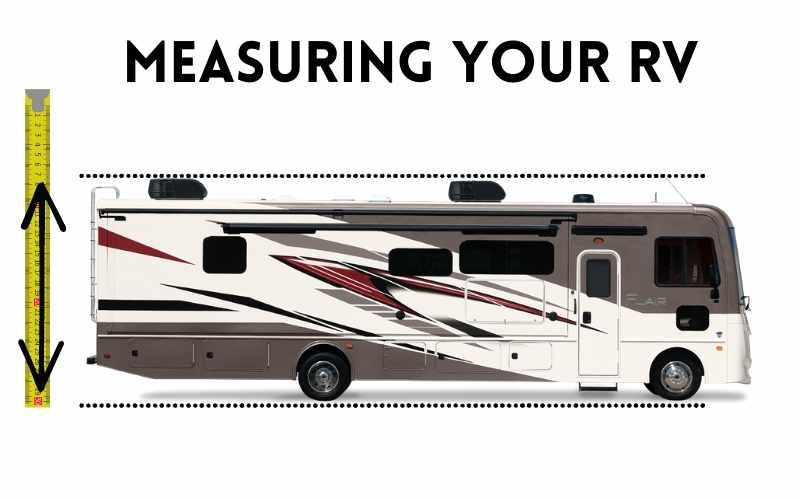
Luckily, measuring your RV height isn’t difficult, and with two people, it can be accomplished in a matter of minutes. To measure your RV, simply follow these simple steps:
STEP 1 : Prepare your RV for travel :
This includes retracting all supports or jacks, closing slides, inflating airbags, and connecting you RV to your pickup truck or tow vehicle. Next, move your RV to level ground. A flat parking lot is a great place to do this. Avoid measuring it at the campsite unless you’re on a level pad.
STEP 2: Access the Roof
The best way to measure your RV height is to have two people (a great task for family members). One person will need to access the roof while the second person is ready on the ground. The person on the ground will extend a tape measure to the person on the roof. Once in hand, the person on the roof will want to extend the tape measure to the highest point on the RV. Since this is usually the air conditioner in the middle of the roof, it may be helpful to use a 2×4 or long pole to create a reference point above the roof’s edge to measure from.
Once the person on the ground records the measurement, write it down. Next, measure it again by starting all over. A few measurements will make sure you have an accurate measurement. If there are two points on the RV that appear to be at equal heights, measure at both locations. This may be the case where an RV has two air conditioners.
STEP 3: Measure
Step4: post the measurement :.
Once you are comfortable with it and write it down, don’t forget to post it somewhere you can easily access it when traveling. Don’t store it in the RV cabinet or buried in the glove box since you may be scrambling to find it when approaching a low bridge. Knowing that you have enough space to clear an obstacle will save you tense moments of panic as you’re backing up traffic on a busy street.
Conclusion:
The height of your RV is one of the key things you want to know, especially when traveling. Taking the measurement is easy, so let this be one of the first things you do when you get your RV. While RV height is important for traveling, it’s also helpful to know when parking your RV, maneuvering through a campsite or when boondocking, or when on private commercial properties.
Keep this information handy when traveling because you won’t know when you’ll need to access it. It’s also a good idea to note it on your phone since you’ll most likely have it available if you can’t find where you wrote it down. You may never need to reference this number, but if you don’t measure your RV, you will likely find yourself holding your breath as you try to squeak under it.

Leave a Reply Cancel reply

How to Measure a Travel Trailer: 5 Examples
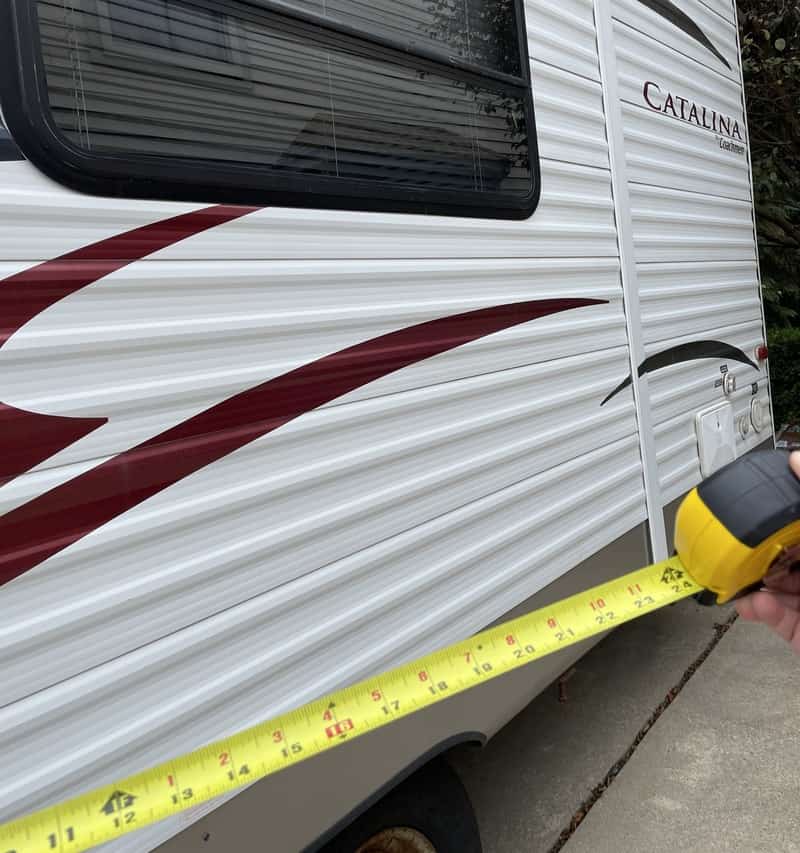
Sharing is caring!
A crucial step in new RV ownership is measuring your travel trailer. The exact size of your camper is crucial information you must know to camp confidently. You’ll reference your travel trailer measurements when booking a campsite, planning your route, or preparing to store your rig.
Luckily, measuring your travel trailer isn’t rocket science. We’ll walk you through how to measure your travel trailer so you’ll have the most accurate stats for your camper.
4 Ways on How Do You Measure a Travel Trailer?
Measuring a travel trailer is easy. All you’ll need is a tape measure and another person to help. You can measure anything you like, but at a minimum, you should know these measurements:
1. Interior Length
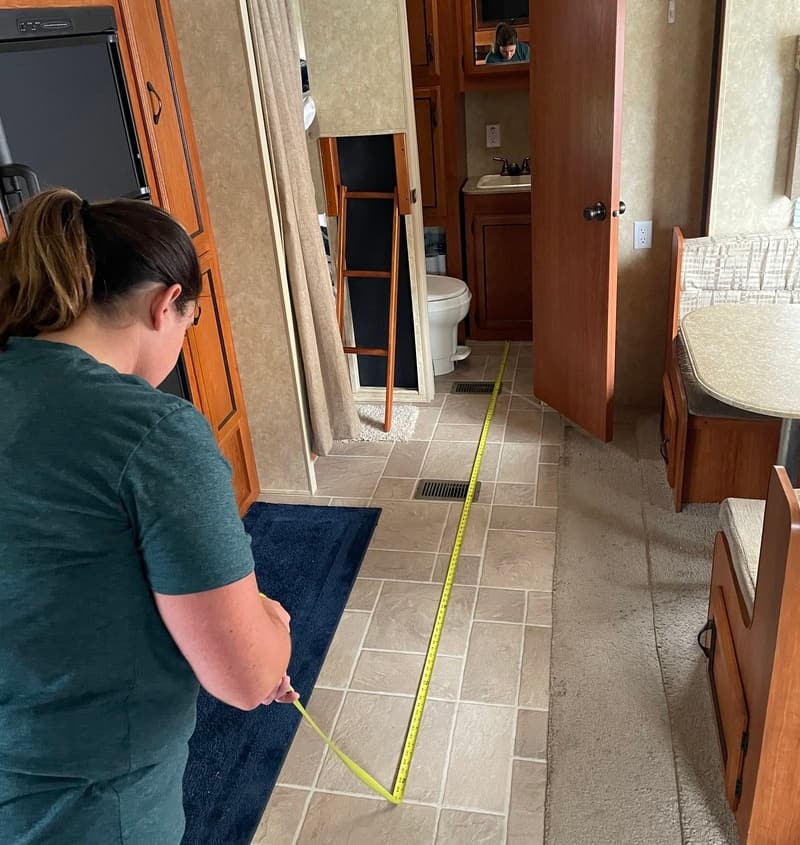
You’ll want to measure the interior length of your travel trailer. This measurement simply refers to the living space within the camper. To get this stat, measure inside the travel trailer from the front wall to the back wall. Ensure you include the depth of the cabinetry or furniture against the walls.
2. Interior Height
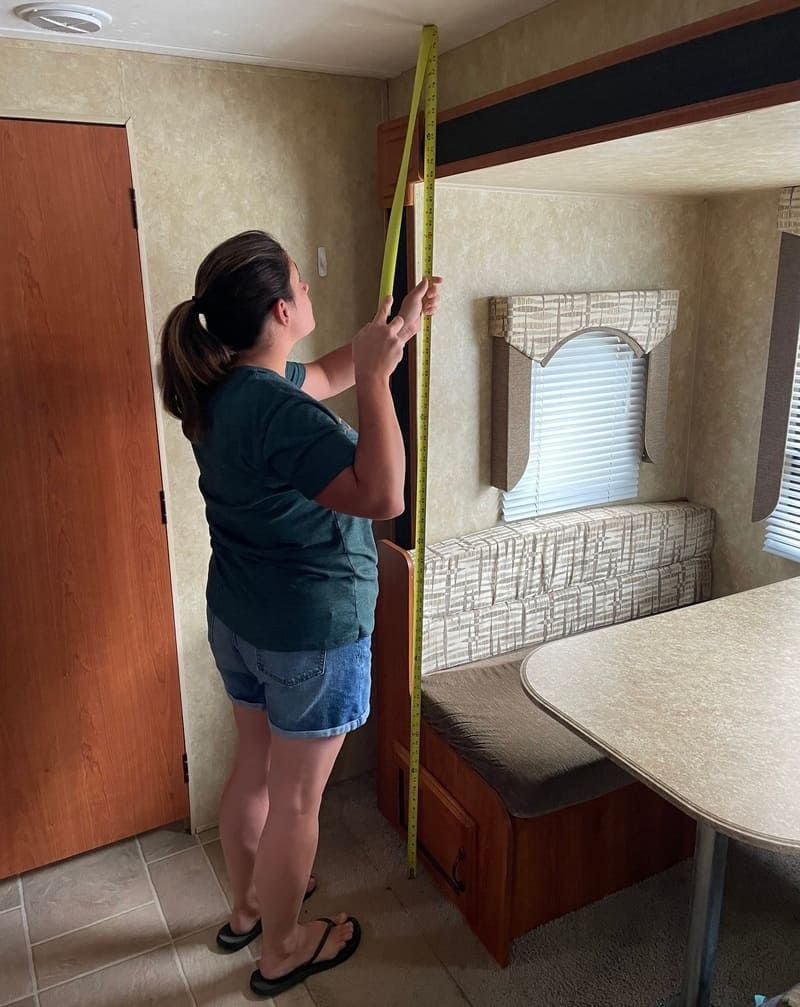
Like interior length, the term interior height is used to refer to the living space inside the camper. In other words, how much room do you have to stand up? This one requires measuring the floor to the ceiling inside the travel trailer. It’s best to measure on the main floor.
If your camper has a skylight in the shower, you may want to measure the interior height when standing under the skylight and when standing anywhere else in the camper. Get the floor-to-ceiling measurement and the floor-to-skylight measurement.
3. Exterior Length
You’ll also need to know the true exterior length of your travel trailer. There’s no industry standard regarding how to measure exterior length. Some manufacturers will include the hitch in the overall length, and others won’t include the triangular tongue.
When measuring the exterior length of your travel trailer, you’ll want to measure from the back bumper to the tip of the tongue. Be sure to include any length you may have added with after-market attachments like bike racks or RV rear cargo carriers. Knowing the true length of your camper will help determine where you can park.
4. Exterior Height
Exterior height is another important measurement you need to know. Always consider the overall height of your travel trailer when planning your route. Don’t guess when driving under a bridge or through a tunnel. Knowing exactly how tall your RV is can prevent disastrous accidents.
To measure the exterior height, simply measure from where the tire rests on the ground to the top of your RV’s rooftop air conditioner. Don’t forget you’ll probably need a ladder and someone to help you measure in order to get an accurate measurement of exterior height.
Why Do You Need to Know the Length and Height of Your RV?
It’s important to know the length and height of your RV for many reasons. You’ll want to measure your travel trailer before embarking on a trip so you can avoid low bridges and tunnels. RV Life Trip Wizard can help. Once you’ve measured your travel trailer, simply input the measurements into the app, and RV Trip Wizard will direct you along a safe route.
It’s also important to consider your driving abilities and travel trailer length. The longer your RV, the more difficulty you’ll have making tight turns. Keep this in mind when planning your route and choosing a campsite.
Experienced RV drivers may not struggle to maneuver around trees and park with precision. But if you’re new to towing, we recommend choosing a campsite intended for larger RVs. This typically gives you a little more backing in wiggle room.
Speaking of parking your RV, you’ll also need to know the length and height of your RV when securing an RV storage facility for your camper. Whether you have a camper that fits in a garage or a larger RV, you’ll need to know the measurements when planning for off-season storage.
Do You Need to Know the Width of a Travel Trailer?
Yes, knowing the width of your travel trailer can be very helpful. You’ll want to know the width of your coach when traveling down the road, camping, and storing.
How to Measure the Width
Similar to length and height measurements, you’ll want to measure your camper’s interior and exterior width.
Don’t forget that measuring the width of an RV can be complicated around the slideouts. If your camper has any slideouts, you’ll want to take width measurements when they’re open and closed.
Interior width measurements are easy, as you simply measure from one side wall to the other. For exterior width measurements, you may need to crawl under the camper to stretch the tape measure.
If you don’t want to do that, a safer trick is to use a yardstick and sidewalk chalk. Mark on the ground where the edges of the camper are, and then measure between the marks.
How to Measure Travel Trailers By Type
Travel trailer .
Average Measurement Ranges For Travel Trailers
Measure a travel trailer by taking interior and exterior measurements for length, width, and height. Don’t forget to measure the width when the slideouts are collapsed and expanded. It’s also important to include the hitch in your exterior length measurement.
Camper Vans
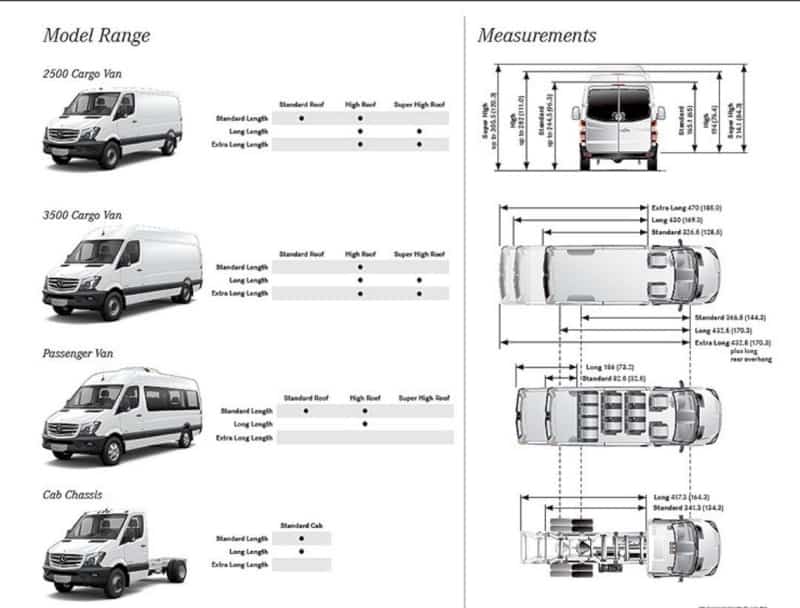
Average Measurement Ranges For Camper Vans and B Plus Motorhomes
Camper vans are simple to measure. Measure the dimensions of the van itself. Any additional RV equipment, like an air conditioner or equipment racks, must be included. You must measure the additional width and height if you have a B plus motorhome.
Fifth Wheel Trailers
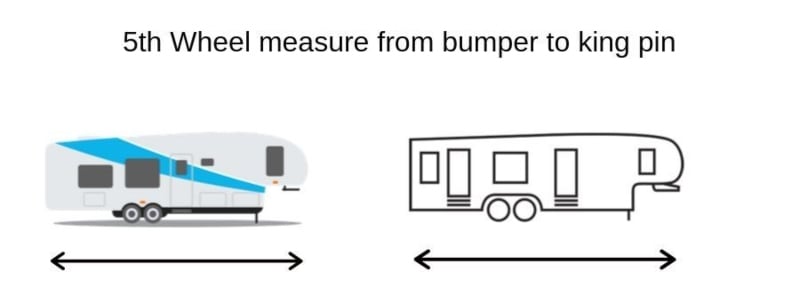
Average Measurement Ranges For Fifth Wheels
Typically fifth wheels are measured from the back bumper to the center of the kingpin. You’ll want to know your fifth wheel’s interior and exterior heights, widths, and lengths. These measurements are taken in the same way you would measure a travel trailer.
Average Measurement Ranges For Motorhomes
Motorhomes are measured like travel trailers. Interior measurements are taken from interior sidewall to sidewall and floor to ceiling. The only differences are that Class A motorhomes are measured from bumper to bumper.
Class C RVs are measured from bumper to bumper, but the cabover loft dimensions may have to be measured separately and added to the main coach space afterward.
Pop-Up Campers
Average Measurement Ranges For Pop-Up Campers
Pop-up campers may seem more difficult to measure, but measuring these travel trailers in their separate forms is a simple process.
Measure the length, width, and height as you would a travel trailer. Just perform these measurements twice; once while the pop-up is collapsed in travel mode and again when it’s fully set up in camping mode.
Teardrop Campers
Average Measurement Ranges For Teardrop Campers
Measuring a teardrop camper is just like measuring larger travel trailers. Measure the camper’s interior and exterior length, width, and height. Since the roof is usually sloped, measuring the height at the highest point is helpful. It’s also a good idea to measure with both open and closed back hatch.
Truck Camper
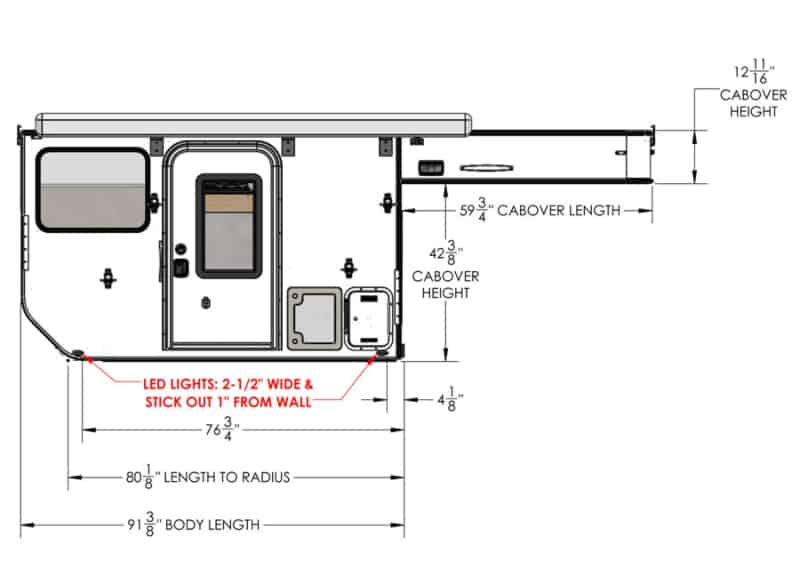
Average Measurement Ranges For Truck Campers
Measuring truck campers can be tricky. When you’re dealing with a cabover bed, the overall length will include the bed over the driver’s cab. Your first priority should be the floor length. If you have a typical cargo bed on your pickup truck, you’ll want to ensure the camper’s lower part will fit.
Slide-in truck campers, those made for typical truck beds, may have unique sizes but will fit within the 3 major lengths of pickup truck cargo bed lengths:
- Short Bed: 5.5 feet
- Standard Bed: 6.5 feet
- Long Bed: 8 feet
The average width of a pickup truck bed ranges from 49- 65 inches, depending on the brand and series. Your individual truck’s owner’s manual should have specific measurements.
Otherwise, when measuring for truck camper dimensions in your truck’s cargo bed, ensure you get the space between the height and length of the wheel wells.
FAQs About How to Measure a Travel Trailer
Does Length of Travel Trailer Include Hitch?
Travel trailer length specs don’t always include the hitch. But knowing the length of your travel trailer, including the hitch, is very important. You’ll want to find out the total length, hitch included, even if it means measuring your travel trailer yourself.
What Is the Average Length of a Travel Trailer?
There are a ton of travel trailers on the market, offered in a variety of lengths. Most travel trailers measure anywhere between 12 feet and 35 feet. The most common travel trailers tend to come in 20 ft. or 30 ft. lengths.
What Is the Average Height of a Travel Trailer?
The height of travel trailers can also vary. However, most travel trailers have a height that measures somewhere between 10ft and 11ft (exterior).
What Is the Average Width of a Travel Trailer?
Like length and height, the width of travel trailers also varies. Most are about 8 ft. wide. Extra wide models measure 8.5 ft, and compact models measure between 6 ft. and 7 ft. wide. Slideouts typically add 2 ft. – 3 ft. to the open width of the travel trailer.
Do You Need to Measure the Length of the Camper’s Tongue?
Yes, you need to know the length of the camper’s tongue. More specifically, you need to know the length of your camper, including its tongue. The overall length is important when determining where you can park your camper.
Yes, you also need to know the width of a travel trailer. This is important when planning your travel route, as narrow roads can be difficult to navigate with a wide trailer.
Additionally, you need to know how wide the camper becomes when extending slide-outs. You don’t want to encroach on neighboring campsites.
How Do Campgrounds Measure Trailer Length?
Campgrounds can vary in how they measure the length of an RV. For instance, most include the tongue length, and others do not. It’s a good idea to take several measurements of your camper and store them someplace accessible for easy reference. Always check a campground’s website for its specific policies.
What Is the Best Travel Trailer Length?
There is no best travel trailer length. Some people prefer shorter travel trailers that are lighter and easier to tow and store. Others may have large families, and so the extra space of a 35 ft. travel trailer with a bunkhouse is what meets their needs.
What Is the Maximum Travel Trailer Length for National Parks?
Yellowstone National Park and several others can accommodate a 40ft. RV. Almost all national parks can accommodate RVs up to 19 ft. The average national park campground length is 27-30 feet. The Great American Outdoors Act (GAOA) passed in 2020 devotes funding until 2025 to the national park campgrounds to modernize many of the campgrounds, including lengthening the campsites.
5 Common Travel Trailers and Their Lengths, Heights, Widths
1. forest river r-pod rp180 .
- UVW: 2,950 lbs.
- Tongue WT: 332 lbs.
- GVWR: 3,832 lbs.
- Ext. Height: 9.7 ft.
- Ext. Length: 20 ft.
- Ext. Width: 8 ft.
Small travel trailers like the Forest River R-Pod have simple dimensions. The only thing you need to keep in mind is the width. If the coach has a slideout, get the road mode measurement and the camp mode width with the slide expanded.
2. Airstream Flying Cloud 25FB
- UVW: 5,600 lbs.
- Tongue WT: 875 lbs.
- GVWR: 7,300 lbs.
- Ext. Height: 9.9 ft.
- Ext. Length: 25.11 ft.
- Ext. Width: 8.55 ft.
Mid-length RVs without slideouts have straightforward measurements. When measuring an Airstream, like the Flying Cloud, you need to measure at the apex of the sidewall curve. That’s the widest point of the coach. It’ll be about half way up from the chassis. The same is true for the length since the front and back caps are also curved.
3. Lance 2465
- UVW: 6,830 lbs.
- Tongue WT: 930 lbs.
- GVWR: 8,900 lbs.
- Ext. Height: 10.7 ft.
- Ext. Length: 29.10 ft.
- Ext. Width: 8.03 ft.
Like the small travel trailers, ensure you get the collapsed and expanded slideout width. The hitch length on any travel trailer is around 3 feet, but every RV manufacturer encroaches on the triangular tongue differently. You don’t have to be too exact, but measure it from the ball receiver to where it meets the living space.
4. Jayco Jay Feather 30QB
- UVW: 7,295 lbs.
- Tongue WT: 835 lbs.
- GVWR: 8,500 lbs.
- Ext. Height: 10.8 ft.
- Ext. Length: 36.11 ft.
Mid to full-length travel trailers may have two slideouts on the road side. When you measure the width, focus on the wider slide for the most accurate travel trailer width measurement.
5. Keystone Montana 3231CK
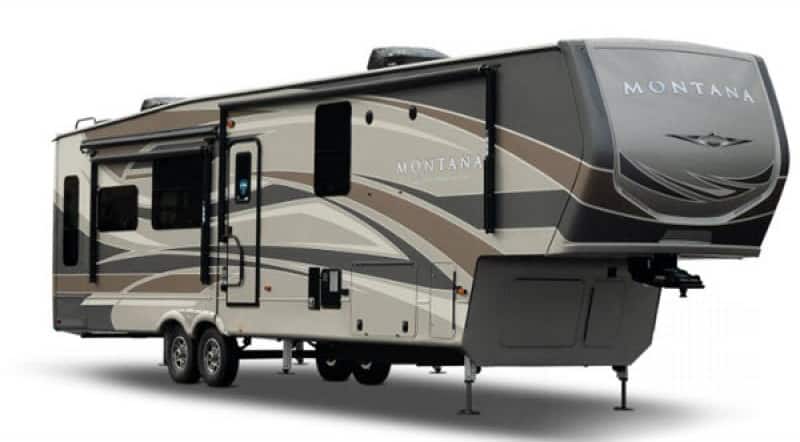
- UVW: 12,770 lbs.
- Hitch WT: 2,680 lbs.
- GVWR: 16,680 lbs.
- Ext. Height: 13.4 ft.
- Ext. Length: 37.5 ft.
- Ext. Width: 8.6 ft.
Most travel trailers and fifth wheels have crown sloping roofs. This may make one of the roof air conditioners higher than the other. When measuring the height, make sure you’re measuring from the bottom of the tires to the highest A/C.
Final Thoughts on How to Measure a Travel Trailer
As a responsible RV owner, it’s important to know the true measurements of your travel trailer. Although the manufacturer specs may not provide all the necessary information, measuring your travel trailer is easy.
Simply grab a tape measure and a friend to help, and you’ll have all the data you need in no time. Take both interior and exterior measurements. Don’t forget to include bike racks or any other after-market attachments you may have added. It’s important to measure slide outs too. Don’t forget to include the air conditioner in your height measurement.
Measuring your travel trailer is easy, but don’t overlook this step. You’ll appreciate having the exact dimensions of your RV when it comes time to plan your route or book a campsite.
Related Reading:
– 10 Travel Trailers With High Ceilings Perfect For Tall People – Best Apps For Leveling Your Camper Trailer – 25 Best Travel Trailers Under 20 Feet
About the Author:
Laura Tyrell is a part-time RVer and full-time mom of three. Long-time campers and RVers before children, Laura, and her husband have fallen even more in love with the RV lifestyle since becoming parents to a child with food allergies.
Having her own kitchen on wheels makes her RV trips amazing. Laura is passionate about finding ways to make traveling with young children fun, easy, and attainable.

Recent Posts
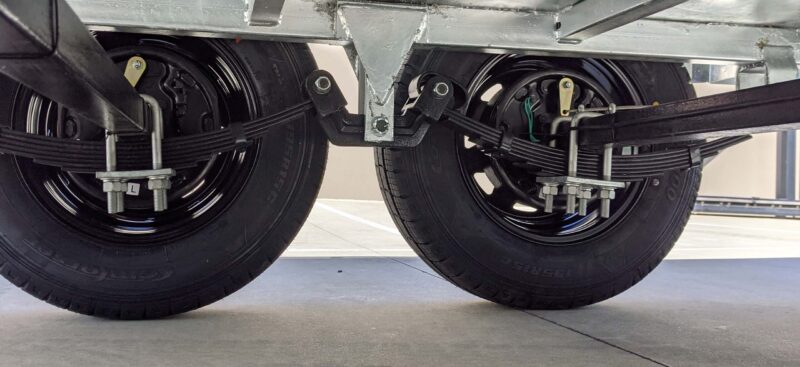
How Long Should Travel Trailer Brakes Last?
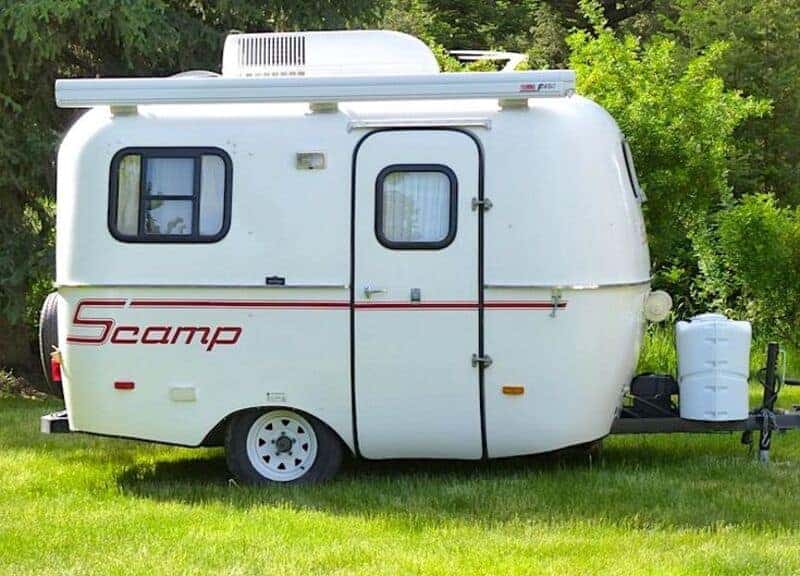
10 Best Travel Trailers Under 2000 lbs For 2024
Written by Johnathan R. Smith • March 29, 2020 • 3:57 am • Guides
What is the Average RV Length, Width & Height

The average RV dimensions will vary depending on the class of RV. View the chart below to view the most common RV dimensions.
Are You Trying to Determine the Ideal RV Length?
When you poll the internet, you will be told that the ideal length is whatever works for you. While that may be true, it’s an unsatisfying answer. If you get beyond those responses, you find that most consider 32 to 33 feet to be the ideal.
You can see evidence of this in the average lengths of the largest RV classes on the market: Class As and 5th Wheels. There are quite a few owners that start with a small trailer , upgrade to a super-large unit, and then downgrade to a 32 footer.
Why Do RV So Many Owners Prefer 32-Feet Long RVs?

National Park RV Length Limitations
The 40+ monster motorhomes are amazing, but a lot of national parks do not have the capability of hosting them. If you have a small trailer, you can fit in almost anywhere.
A 32-footer won’t have this problem for the most part. It can comfortably fit into 81 percent of the national parks.
This chart shows the percentage of national parks that are capable of hosting the listed RV lengths.
Please note that there are often other RV parks near the national parks. A lot of them can provide accommodations for the larger RVs. We do not have exact data for those parks, so you will need to perform additional research for exact numbers.
The Longer the RV the More Dangerous and Inaccessible the Road
When you drive an RV around 40 feet long, small gusts of winds can leave you white-knuckling the steering wheel. The RVs with an average length will still deal with this, but it will be a more subdued experience.
There are also several national parks with roads that are too narrow, dangerous, or otherwise inaccessible to a longer RV. One example is the Sequoia National Park with a maximum length of 22 feet. The road is simply too dangerous for anything longer than that.
Long RVs Require Special Licensing
Around 36-feet in length, the Gross Vehicle Weight Ratings of RVs start to meet and exceed the 26,000 pounds mark. States often require drivers of vehicles that meet or exceed this weight to have a commercial driver’s license. Depending on the state, the 26,000 pounds can be the combined weight of the RV and its TOAD.
Oftentimes, longer RVs have significant towing capacities. If you plan on towing a substantial weight, you might need the commercial driver’s license. The exact details vary widely from state-to-state, so you will want to look up your local ordinances for the specific details.
While getting a license is by no means a deal-breaker, it is an added annoyance that limits who can and cannot drive the RV. It can cause issues if you need another driver in a pinch and nobody has the required commercial driver’s license.
Why Is The Average RV Height 10 Feet or Less?

Nearly everybody loves the tall and arched ceilings of some of the larger units. If that’s true, why aren’t more RVs manufactured with the average 11-foot ceilings that trailers use? Better yet, why not make them extra tall like some of the 12-foot models?
One reason, which we already discussed, is the wind. Longer and tall units will catch more of the wind and the less stable it will be. While you probably aren’t going to flip over, the countersteering will be a pain. It’s not something that you will want to deal with every time you travel the open plains.
Low Clearance Bridges, Tunnels, Etc.
The main reason is that you start running into clearance issues. If you are not careful, you will quite literally run into them. For the most part, this won’t be an issue. Cities often build these types of low-clearance structures at about 11 to 13 feet, and they like to stick closer to 13 feet. Here is a PDF that lists most of the United States’ low-clearance structures. It was put together by coach-net, and it is really useful.
While you can fit through most of these low-clearance obstructions, it’s nice to have the extra foot of clearance. It can get pretty tense when it comes down to inches of clearance. The average of 10 feet is definitely better.
RV GPS Systems Are Important For the Bigger Than Average RVs
If you prefer a taller than average unit, you might want to consider picking up a GPS unit. Many of the modern RVs come with integrated GPS systems. If you are purchasing an older one, you might not be so lucky. RV GPS systems are different from a GPS system for a regular car. RVs and semi-truck drivers use navigation systems that allow the owner to input the specification of their vehicle.
If the vehicle cannot drive through a road or a low a low-clearance structure is going to get in the way, the GPS will pick an alternative route to get around it. This is invaluable for preventing an unwanted shave from the roof of your RV .
Why Is The Average RV Width 8 1/2 Feet?

Wide RVs in Narrow Lanes
This is rather obvious, so we won’t expound on it too much. Street sizes vary from location to location. They are designed with cars primarily in mind, and cars have a very narrow 6.5 feet body. Inner-city lanes, on average, are typically 10 to 12 feet wide, and highway roads are roughly 12-feet wide.
These numbers can fluctuate, and wider RVs have a difficult time dealing with the narrower roads. A 9-feet wide RV just doesn’t leave a lot of wiggle room on a 10-feet wide lane. In reality, you have even less space when you add the width of the mirrors into the mix.
State Permits For Wide Vehicles
Keeping RVs at an average of 8 ½ has limited paperwork and the associated costs for RV owners. Depending upon the state, wide-bodied RVs might require a special permit. Here are some examples that we’ve come across, but there are definitely some more to find. Check your local DMV for more information.
- Arizona, Kentucky, Maryland, West Virginia
- Florida, Georgia, Illinois, Louisiana, Michigan, Washington D.C., and more
How Do You Measure An RV?
For the most part, this is a pretty straightforward task, so I won’t complicate it. When measuring an RV, you don’t measure all of the components installed onto the body. Mirrors, ladders, and sometimes AC units aren’t included. The AC units are measured for knowing your clearance rather than the height of the RV. Some manufacturers list it and some don’t.
When measuring the length of the RV, you measure from the side of the unit. Without bending the measuring tape, hold each end from one bumper to the other bumper. If there is an attached ladder, do not include it in the measurement.
When measuring the height, you aren’t measuring the body. You are measuring from the edge of the roof to the ground.
You are measuring the body. The mirrors are not included in this measurement
Trailer Owners
If you are measuring a trailer, you don’t include the measurement of the tongue.
Conclusion On RV Lengths, Widths & Heights
For some people, a 40-feet long Class A monster is the only way to go. For others, they prefer something on the smaller side. Finding the average RV length, width, and height is a great way to begin the search. However, you shouldn’t hesitate to go outside if an RV has your attention. We’re all unique, and that’s reflected in our choices. Choose what fits you.

About the Author / Johnathan R. Smith
Comments are closed.
- Affiliate Disclosure
- Privacy Policy

- More Networks

This post may contain affiliate links or mention our own products, please check out our disclosure policy .
How are travel trailers measured?
Published on October 14th, 2018 by Ray & Tammy Roman This post was updated on December 28th, 2022
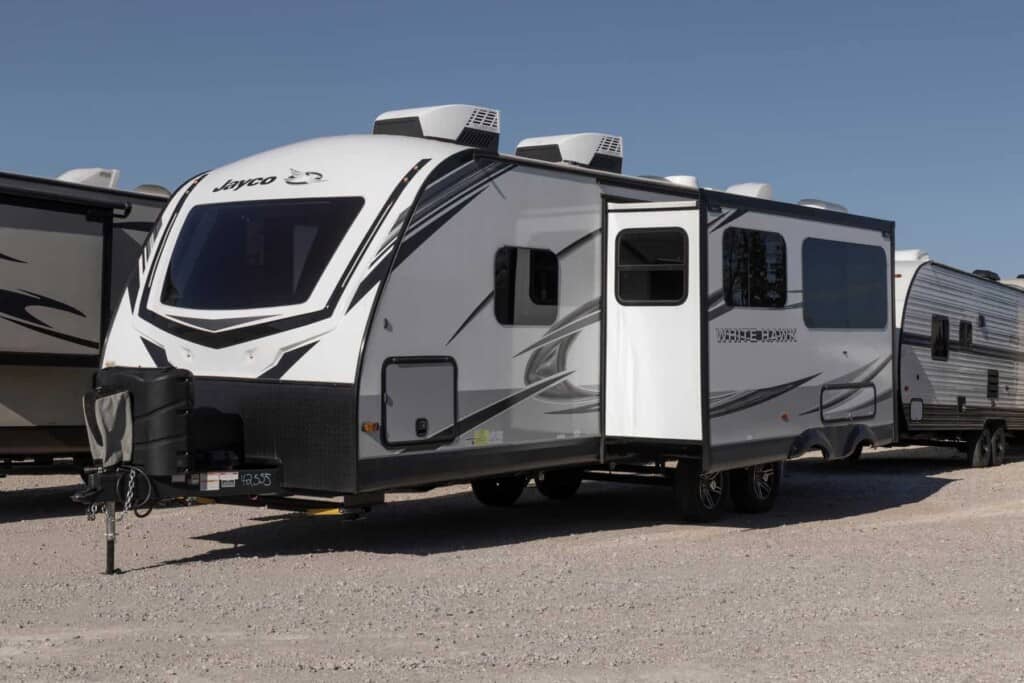
Why You Need to Know Travel Trailer Measurements
Knowing how travel trailers are measured is helpful whether you’re looking to buy or rent an RV. Can that trailer fit into a campsite you want to book? Will it squeeze into your RV storage area? To find out, you need to review how your travel trailer length, width, and height is measured by the RV manufacturer, dealer, or private party RV seller.
How Long is a Travel Trailer?
To understand the measurement specifications of a travel trailer you first need to know how travel trailer length is measured.
- Some measure travel trailer length by starting at the ball mount and going all the way to the back bumper.
- But other times, only the inside living space is measured. For example, according to the RVIA, the advertised travel trailer length should only include the usable “floor plan” length. In other words, the tongue or rear bumper should not be included in the final measurement. So keep in mind that a trailer described as 20 feet in length might be 23-24 feet overall when you factor in bumper and tongue length too.
When talking to an RV salesperson or private party RV seller, it’s important for you to ask how their travel trailer brands are measured.
DON’T MISS OUT ON RV LIVING UPDATES
Sign up for the newsletter today.
Please enter a valid email address.
An error occurred. Please try again later.

Thank you for subscribing to the RV Living newsletter, keep your eye on your inbox for updates.
- Does the length only include the usable living area inside?
- Or did they measure the travel trailer’s overall length, including tongue and bumper?
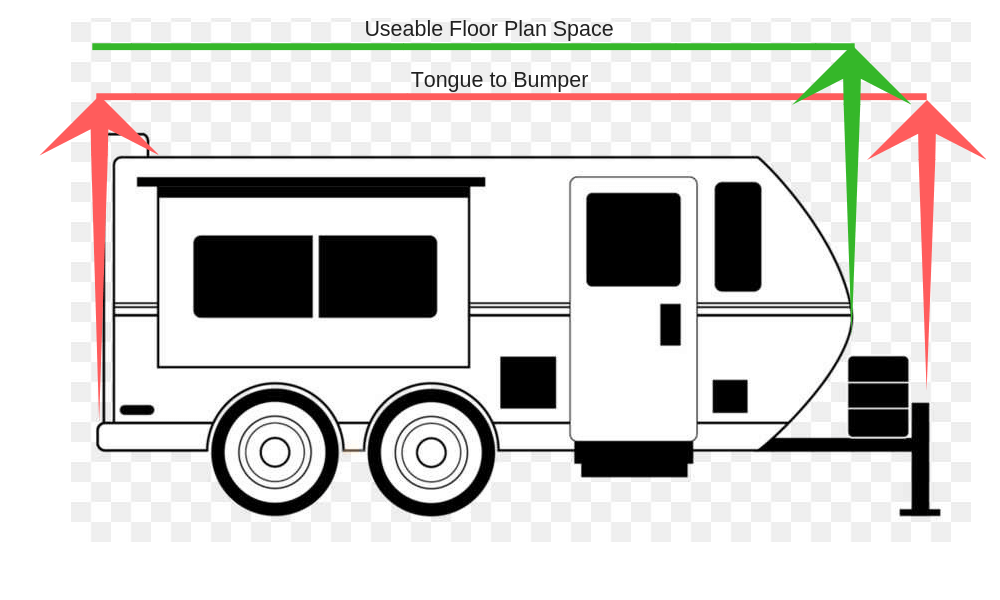
How Wide is a Travel Trailer
The width measurement for travel trailers varies greatly, depending on the model and make of each RV. However, most travel trailers do not exceed 8-feet 6-inches in order to comply with the majority of state highway laws.
How Tall is a Travel Trailer?
Travel trailer manufacturers build RVs to be no more than 13-feet, 6-inches tall. This RV height complies with the typical height of highway overpasses in the USA. But it’s still important to know your travel trailer height. This number can mean the difference between a low bridge collision and getting to your campsite safely.
Just like travel trailer width, the average height of travel trailers differs greatly depending on the model. However, most are usually 11 feet tall.
Keep in mind that the roof-mounted A/C unit adds another foot or so. Since manufacturers may or may not include the A/C unit in their travel trailer height measurements, the best way to measure travel trailer height is to do it yourself with a surveyor’s tape measure. Stand on the roof and have a friend on the ground to catch the end. Now you have your measurement.
What About Campsite Measurements?
Want to book a campsite for your travel trailer? When the campground gives you the parking area length, they are providing the length of usable space available from trailer tongue to rear bumper. Do not exceed it or you may be asked to move or leave if the campground is fully booked.
What is the Best Trailer length at US national parks?
The best trailer length at national parks differs by location. Most US national park campgrounds were built before the 1980s. The majority of campsites do not accommodate modern RVs built since that era. Your best bet for national park RV camping is to choose an RV smaller than 30-feet long. One of the best resources to find campsite measurements at national parks is the Best RV Length for National Parks by Camper Report, and The Essential RVing Guide to National Parks by National Parks Traveler.
If you enjoyed this post Please Share:
Related posts:.

What is the Life Expectancy of a Travel Trailer?
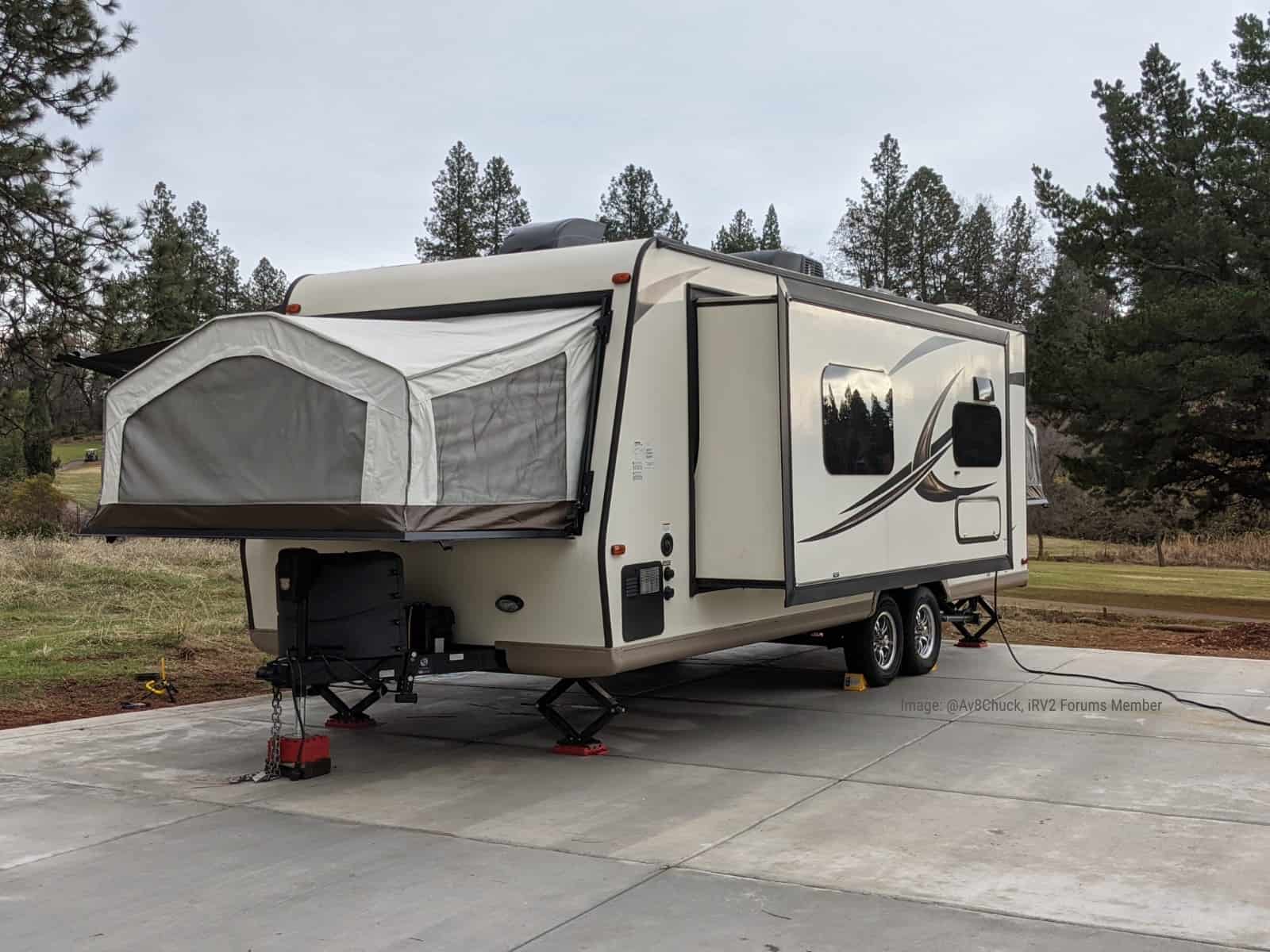
Expandable Travel Trailers: Why Hybrid Travel Trailers a Great Choice

The Basics of Camper Trailer Brake Controllers: Necessary for Safety and Fun
About the author:.


- You are here:
- Home »
- Blog »
- » How Tall and Wide Is an RV? Complete Camper Dimensions Guide
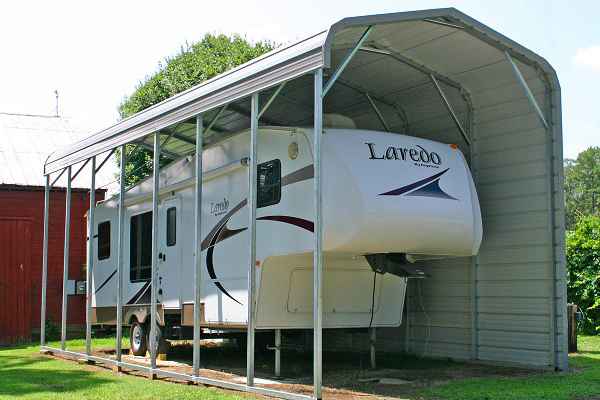
How Tall and Wide Is an RV? Complete Camper Dimensions Guide
- November 22, 2018 /
- RVing 101 /
- By R. Geraldi /
One of the most important things that we look for in an RV is the dimensions. When we first plan to buy an RV, we are concerned about whether we’ll be able to park it back home. Not to mention that many national parks have certain restrictions when it comes to the length. Dimensions also tell us about the level of comfort that we can expect from a certain vehicle. We can all agree that comfort can be very important during the long trips across the country.
For someone who hasn’t owned an RV before, the dimensions might be frightening. And basically, they are. RVs are big, and that's a fact. You’ll need a big enough garage to fit one, since leaving it outside exposed to different weather conditions all the time may take a toll on the vehicle itself.
We don’t want to scare you off of buying one, but you have to understand that owning an RV can sometimes be a hassle. Aside from national parks, many states also have restrictions when it comes to both the width, height, and length. Basically, all those restrictions exist because of the infrastructure. So parking your 45 ft long RV might get you a ticket in some areas. Always make sure to check the laws and regulations both of the state that you live in and the ones that you’re planning to visit.
In the following paragraphs, we’ll discuss the dimensions of different class motorhomes, and we’ll give you average numbers, so that you know what to expect before deciding to buy an RV. In the end, we’ll look more closely into certain popular motorhomes out there and see their length and some of the other characteristics.
How Wide Is an RV?
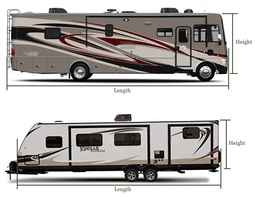
RVs are some of the largest vehicles that we encounter on the road. Many of us usually think that the length of an RV might pose a problem. Thus we forget to think about the width which can be even more important. The average width depends on the class of the RV that you are planning to buy, as it is with other dimensions.
If you want to invest in a class A motorhome, you must be aware that in some places that might not be a good idea. We all know that sometimes RVs is a synonym for comfort and luxury. But, the average width of a motorhome is usually somewhere around 8.5 ft . With that width, you’ll be OK driving on the interstates, but you may run into trouble if you steer off towards the state-controlled roads.
Some states have the maximum width limit of 8 ft. In Arizona, Maryland, West Virginia, and Kentucky you will need a special oversized load permit if your vehicle is 8.5 ft wide or more. You can also add to that list states like Florida, Georgia, D.C., Illinois, Louisiana, Michigan, and others.
So before you plan your trip, always make sure to check the regulations and get the needed permits. It’s not just about not getting a ticket, most roads aren’t designed to handle the vehicles that have large dimensions. Especially when it comes to motorhomes.
How Tall Is a Travel Trailer?
When it comes to the height, one can expect that, on average, a travel trailer is 11 ft high. That shouldn’t come as a surprise since they are usually towed by powerful SUVs. There is one thing that you should mind when it comes to the height. Namely, the maximum allowed height for vehicles on the interstates and highways is 13.6 ft. That basically means that the cap can only be much lower on the state-controlled roads. Even though we all like a good amount of space in our vehicles, you should be careful not to overdo it. The regulations are there for a reason. None of us want to damage the vehicle by hitting into the bottom of an overpass or something else entirely.
Travel Trailer Width
The average width of a travel trailer is quite similar to the width of other motorhomes and RVs. As with them, you’ll also need to check for the regulations in certain states, though you’ll probably be safe while driving on the interstates.
Travel trailers come in all shapes and sizes, but on average a travel trailer is around 8 ft wide.
Class A Motorhome Length and Height
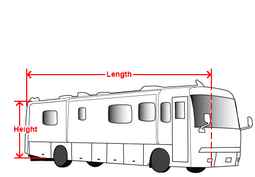
Class A motorhomes are the largest and usually the most luxurious motorhomes available on the market. If you’re planning to buy a class A motorhome, you will need a large storage space. You’ll need to take into consideration the size of your garage. Having a large RV means that you will need some extra space on top of its length. In total, we’re talking about 45 ft or more.
When it comes to the length of class A motorhomes, you can expect it will vary from 20 ft to 40 ft or even more. But, when it comes to the average, you can expect them to be around 30 ft long .
Now, we should also pay a special attention to height. Why? Well simply because large motorhomes tend to be restricted in many states. We already know that the maximum allowed height for vehicles on the highways is around 13 ft. Although there are RVs that are that high, they are usually 10 ft high on average .
Class B Motorhome Lenght and Height
What’s interesting about class B motorhomes is that they are smaller both from class A and class C. That means that if you invest in a class B motorhome, you’ll probably get a vehicle that will fit into all standards and regulations. As a plus, you’ll need less space for storage. So if you don’t plan to bring many passengers with you, or you don’t need a large sleeping capacity, going for a class B motorhome might be a secure and a proper way to go.
Class B motorhomes are both shorter and have a lower height than others. Though, the average width is still around 8 ft, as it is for all RVs. The average height of a class B motorhome is around 8 ft. The average length is around 20 ft.
Class C RV Length and Height
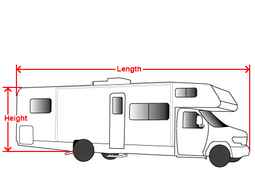
Class C motorhomes are the average of average. They stand between class A and class B in almost everything. If you want to compensate on the price, but not on the actual size of your RV than class C is the way to go. That doesn’t straightforwardly mean that you will also have to compensate for comfort and luxury. You will get a decently sized motorhome for a price that is much lower than that of a class A vehicle.
What’s worth noting about class C is that you will have a wide variety of length to choose from. So basically, you’ll be able to get a class C motorhome that is as short as 20 ft or as long as 33 ft. And as we stated before, an average class A is around 33 ft long. Though, the average length of a class C RV would be somewhere around 27 ft. However, if they are shorter, be aware that they might compensate that by adding to the overall width. So some of them can be even 9 ft wide, and that can pose a problem on many roads. When it comes to the height, you won’t see much of a difference either. They are usually 10 ft high.
How to Measure an RV?
Measuring the overall dimensions of an RV is a simple process. You will basically need the height, the width, and the length. O ne of the most important things to know about taking the measurements of an RV is that it should be done from bumper to bumpe r. Though you’ll probably want to separately measure the ones that are sticking out and that might pose a problem on the road.
Knowing the measurements of an RV is very important, mainly because most of the roads are not able to support their size. Additionally, you’ll probably have to deal with many regulations that restrict the size of RVs.
Since the overall width cap for a motorhome has been raised from 8 ft to 8.5 ft, many manufacturers also started making bigger RVs according to the new regulations. What can’t be stressed enough is that you are allowed to drive an RV that is 8.5 ft wide only on interstates . But, each state has its own set of regulations that might differ from the aforementioned one.
So be very careful when you’re choosing an RV, because length and comfort don’t mean anything if you’re not able to actually use your vehicle across the state.
Motorhome Dimensions
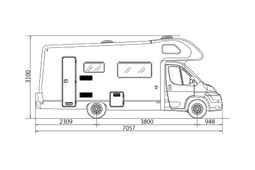
We’ve talked about average numbers, and we’ve seen what we can expect when it comes to the height, width, and length of motorhomes. We’ve also touched upon certain regulations and restrictions that you might experience while on the road. Finally, we’d like to give you an insight into what the situation really looks like. We chose the most popular models of RVs in the past years and decided to compare their dimensions . Among the following paragraphs, you’ll be able to see for yourself whether one of these models will be able to fit into your garage.
Though it doesn’t look roomy at first glance, Jayco Swan has a decent amount of comfort to offer. Though it’s practically a trailer camper, it will offer you more than you can expect. Its travel length is 5,365 m, but once you unpack it, it has more than 6 meters in total.
Jayco Eagle
Another model from Jayco that is always worth considering is the famous Eagle. The newest variation of the Eagle promises a lot of comfort. In it, you will actually feel like you are living in a small apartment. Height is a bit larger and goes up to 12.98 ft, but still within’ the common regulations. As for the length, the Eagle also falls into the average category with 36.92 ft.
Jayco Hawk or Jayco White Hawk is a very popular model among the motorhome enthusiasts. And it’s popular for a reason too. It offers a fair amount of space and many useful amenities. It is a bit smaller than the Eagle. It is 28.17 ft long and 10.9 ft high. One of the most attractive things when it comes to the White Hawk is the price. We found it to be a lot cheaper than the Eagle.
Jayco Flamingo
Flamingo is another awesome camper trailer from Jayco. When spread, you will get as much as 13.78 ft in length.
Forest River Flagstaff
Now, Forest River Flagstaff is something special. It’s not just about the size or the overall quality of the model. There is also something in the carefully arranged floorplan that draws us to it. As for the dimensions, the Flagstaff is 31.92 ft long, 8 ft wide, and 13 ft high.
Winnebago Revel
There isn’t much left to say about Winnebago. They are a famous manufacturer and their model Revel is quite popular among the campers too. It is 19.5 ft long, 9.10 ft high and 7.1 ft wide.
Winnebago Minnie
Winnebago Minnie has many versions but for the sake of presenting you the smallest one, we chose to look into the 2200SS. Its exterior length comes at 26.9 ft. It’s 10.6 ft high and 8 ft wide.
Related Posts
Does CarMax Buy RVs? (CarMax RV Trade-In Guide)
300 Lbs Over Payload: What Happens If I Exceed My Payload?
Thor Vegas Problems (Windshield, Battery, Fridge, Swivel Chair)
Leave a Comment:

Don't leave without reading this article
16 Real Benefits Of Summer Camp For Kids And Adults
RV Camping Travel Trailers ( Average Lengths, Heights And Weights )
Share this post:.

The term travel trailer can be used to describe many types of pull behind RVs with one commonality among them, the use of a hitch. Travel trailers can include pop-up campers, lightweight RVs, fifth wheels, and toy haulers.
The average length, weight, and height of travel trailers can vary. Although they typically fall somewhere around twenty feet in length and eight feet of width. It is important to know the specifications of your exact travel trailer.
Before you decide to buy a travel trailer, you should consider what type of trailer would best suit your needs. A travel trailer can be considered anything from a small pop-up camper, to an iconic AirStream, and even a luxury fifth-wheel.
Ok, so what is the average weight, height, length and widths of camping travel trailers.
The overall average dry weights for travel trailers are between 1,000 to 13,000 pounds, 8 feet tall, 10 to 28 feet long and 6- 7 feet wide.
- The average pop-up travel trailer weighs 1,000 to 3,000 pounds, is 8 feet high when open, 10 feet long and 6 feet wide.
- The average light-weight travel trailer weighs 3,000 to 6,000 pouds , is 8 feet high, 20 feet long and 7-8 feet wide.
- The average standard travel trailer weighs 7,000 to 11,000 pounds, is 8 feet high, 24 feet long and 7-8 feet wide.
- The average fifth-wheel travel trailer weighs 12,000 to 13,000 pounds, is 8 feet tall, 28 to 30 feet long and 8 feet wide.

These are just average weights, heights, lengths and widths. Travel trailers come in a large selection of models and sizes. All weights listed are dry weights. Dry weight is the weight of a travel trailer without any gear, water or propane.
Clickable Table Of Contents
Types of Travel Trailers
Travel trailers are identifiable by their reliance on a truck (or in rare cases a car) to tow them. Unlike RVs or campers, they do not have a method of moving on their own and have a hitch for towing purposes.
Travel trailers can be relatively small or quite large. One of the longest travel trailers, the Dutchmen Aspen Trail travel trailer, is 39 feet in length. It can sleep up to ten people. Pop-up campers or expanding camping trailers are usually some of the smallest.
Travel trailers typically range anywhere from ten feet to forty feet and from 1,100 pounds to 12,000 pounds. The smallest pop-up campers can be pulled by a car outfitted with the proper hitch attachment, the largest fifth-wheels require an open bed or flatbed truck with a massive amount of towing capability.
Pop-up campers Average Lengths, Heights And Weights
Pop-up campers, also known as expanding or folding travel trailers, are typically the smallest in weight, height, and length. These travel trailers fold down and become compact for easy transportation and hauling.
The weight range is 700 to 4000 pounds and the height from eight feet to sixteen feet. They can be as slim as four feet in height when folded down for towing.
The upper portion and roof of the camper are what collapse. They can either be built from sturdy tent-like materials or hard composite walls. The sides typically expand upwards and outwards and may have various different compartments.
Some people enjoy pop-up campers because of the tent-like sides. It can provide the feeling of sleeping in a tent or in the great outdoors without having to sleep on the ground.
As pop-up campers are so maneuverable and weigh considerably less than other travel trailers, they can sometimes be pulled by a crossover or car instead of a truck or SUV. No matter the type of vehicle towing the camper, it must be equipped with a ball hitch receiver.
Pop-up campers are best for those who enjoy camping but do so infrequently. They function as an upgrade from a traditional tent but do not have much room for storage or luxury accommodations and amenities.
They may not even include a bathroom or a kitchen. Additionally, you will have to haul this rest of your supplies in your vehicle as it will not fit in the pop-up camper. After numerous trips and lengthy exposure to the elements, the canvas material and joints may begin to show signs of wear.
Overall, pop-up campers are small and light travel trailers that don’t need a large vehicle to be hauled. They are perfect for those who like to get into the great outdoors occasionally and don’t want to rough it in a tent.
The Jayco Series Sport Camping trailer is a pop-up camper, but it offers some great amenities. It has a sink with faucet, an indoor/outdoor stainless steel stove, and a curtained bath and an outside shower with a plumbed water heater. It offers a taste of home in a compact size.
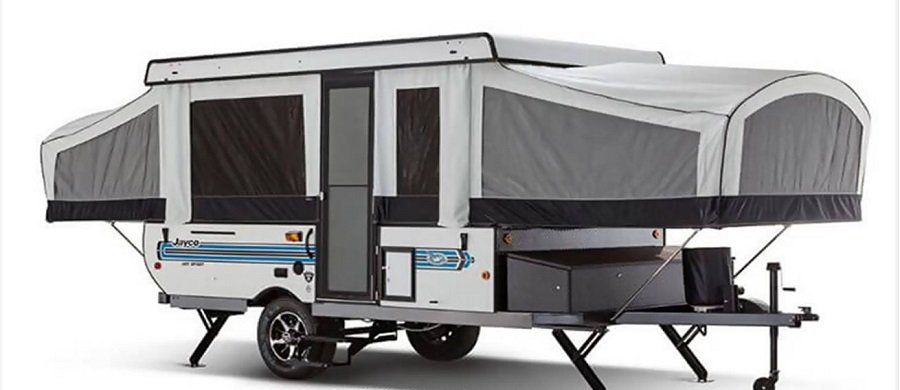
www.jayco.com
Be sure to check out this article if you are interested in pop-up campers. How Much Does A Pop-Up Camper Cost? ( New and Used Prices )
Lightweight Travel Trailers Average Lengths, Heights And Weights
Lightweight RVs are a step up from pop-up campers and are usually what people are referring to when they use the term travel trailer. They are essentially portable homes in a container built on top of a traditional trailer frame.
The average weight of these trailers is 1,000 – 2,000 pounds, height 8 feet and width 7 feet.
Lightweight RVs come in many different sizes and styles with a wide range of amenities. They can be teardrop-shaped trailers, fiberglass trailers that resemble standard campers or RVs, and even the classic AirStream.
Typically, they have an area for sleeping, a kitchen, and a bathroom. They may have their own water supplies, a living room/lounge area, and extendable or pop-up sections for extra room.
Like pop-up campers, lightweight RVs use a ball hitch to attach to the towing vehicle. Though some RVs may be small and light, most require a larger vehicle to tow them, such as a truck, SUV or van.
They do not collapse and their height and length can make them difficult to maneuver. It is important to keep the trailer level and properly weighted when driving and setting up at your campsite. Driving in reverse may be nearly impossible.
Nevertheless, lightweight RVs are an affordable option for those who do not travel enough to justify purchasing a full-size RV, but enjoy a home-on-wheels for regular excursions. They can be equipped with many different amenities to keep you comfortable when on the road.
The Forest River R-Pod Travel Trailer is truly a lightweight trailer, weighing under 3000 pounds. However, it has the ability to sleep four and can be tailored to suit your needs with nine different floor plans. This is a small but durable trailer with great amenities.

https://forestriverinc.com/rvs/travel-trailers/r-pod?RegionSelected=1
Fifth Wheels Average Lengths, Heights And Weights
Fifth wheel travel trailers are typically some of the largest coming in at twenty-two to forty feet and seven thousand to twenty thousand pounds. They have plenty of living space and storage, but it comes at a cost.
Fifth-wheel trailers have a gooseneck attachment to connect to the vehicle doing the towing. The vehicle which you are hitching the trailer to must have a coupling attachment.
This type of connector does have advantages. It more evenly distributes the weight of the trailer, placing most of it between the cab and the rear axle of the vehicle instead of on the rear suspension. This offers an optimal distribution of weight, better dynamics, and an increased turning radius.
However, to haul a fifth wheel you do need an open or flatbed truck. And one with enough weight and power to haul a sizeable load. Therefore, fifth wheels work best for those who already have a truck or feel comfortable investing in one as they plan to frequently haul their travel trailer.
The gooseneck attachment has benefits in terms of trailer cabin space as well. The fifth wheel typically extends over the bed of the truck, usually to make room for an additional or roomier sleeping compartment.
Fifth wheels can include a greater amount of accommodations and amenities including bathrooms, kitchens, small refrigerators, dining tables, and multiple sleeping units.
If you are a frequent camper and expect your home away from home to include all of your day to day luxuries, then a fifth wheel may be the ideal travel trailer for you.
The Mobile Suites 44 Santa Fe is a luxury fifth wheel complete with a kitchen featuring an island and a large pantry, a living room with an L-shaped sofa and dual recliners, a bathroom with dual-sink vanity, and space to sleep four in private bedrooms replete with king-size beds.
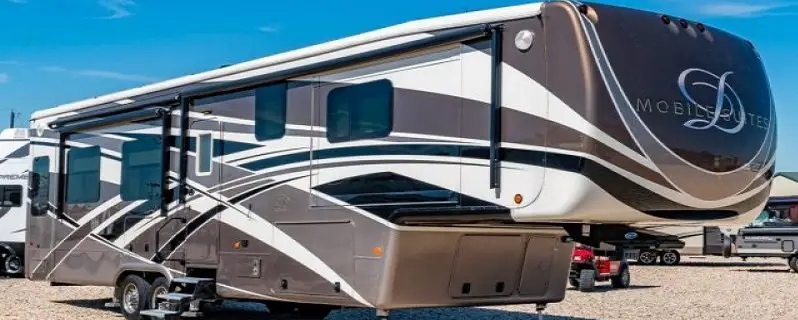
http://www.drvsuites.com/mobile-suites-luxury-fifth-wheels/
Toy Haulers Average Lengths, Heights And Weights
Toy haulers are very similar to fifth wheels with the addition of extra storage space for hauling gear and equipment. In most cases, they are divided into two spaces, the forward compartment for living and the rear compartment for storing toys and gear.
They may have a ball hitch attachment or a gooseneck connector. These trailers are often eighteen to forty feet in length and three thousand to ten thousand pounds. Many also come with retractable awnings, increasing the size of the campers footprint when fully extended.
In many cases, toy haulers can accommodate snowmobiles, ATV’s, and dirt bikes as well as other belongings and sports items such as kayaks. Foldable (but heavy duty) doors can be used as a ramp to load your belongings. Toy haulers are a home and garage all in one.
Having your garage space attached to your living space does have one main drawback, your living space becomes much less spacious. Although the trailer will be the size of a traditional fifth wheel your living accommodations may be limited.
For some, the benefits outweigh the costs. If you are an outdoor enthusiast and adrenaline junkie then there is nothing better than being able to haul all of your toys and have a space to turn in for the night in one complete unit.
The LANCE CAMPER Lance TH 2612 is a great example of a toy hauler. It has twelve feet of cargo space in addition to its living space complete with kitchen, bathroom, A/C, a microwave, and designer interiors. Furthermore, it has its own water tank, generator, fuel tank, central vacuum, side and rear awnings, and a roof rack. This toy hauler is the best of both worlds for those who enjoy being active.

https://www.lancecamper.com/
Advantages and Disadvantages of Each Type of Travel Trailer Due To Size
Pop Up Trailer
- Budget-friendly
- Lightweight and maneuverable
- Can be hauled by a vehicle other than a truck
- Easy to set up
- Closely resembles a tent and the atmosphere of sleeping outside
- Lack of certain accommodations (kitchen, bathroom, etc)
- Little protection from elements, not much insulation or climate control
- Overtime fabric paneling and joints may need replacing
Lightweight Travel Trailer
- Better climate control than a popup
- Can be equipped with a bathroom, kitchen, and more
- Come in many sizes, weights, and shapes
- Little to no setup required
- Will likely need a truck or SUV to haul
- Can be difficult to maneuver and may not fit into all campsites or spaces
- Takes practice and skill to tow and maneuver
Fifth Wheel Trailer
- Gooseneck connector is often better for the trailer and tow vehicle
- Provide ample space, accommodations, and amenities
- Has storage space
- Requires a large truck with an open bed or flatbed
- Large in weight, length, and height
- Living space and garage space all in one
- Has ramp for loading toys (dirtbikes, ATV’s, etc)
- Lots of storage
- The living area is limited due to shared space with garage/storage
- Living space is in close proximity to toy storage which can lead to fumes or leaks
- Loading the back with numerous vehicles and toys may throw off trailer balance and towing capabilities
Each type of travel trailer has its positives and negatives. The type you choose really depends on what accommodations you prefer, how frequently you plan on using the trailer, and how comfortable you are towing a trailer specifically in regards to its weight, length, and height.
Why You Must Know Your Size Specs
When you are hauling a travel trailer, those bridge weight limits and overhead height signs suddenly apply to you. You must know the specifications of your rig in order to keep you and others safe.
Until you know your trailer height like the back of your hand, you should write it down and keep it visible in your vehicle whenever you are hauling. Knowing the height of your trailer is a necessity for bridges, signs, and even the drive-through at fast-food restaurants.
Your travel trailers weight is important as well. Certain bridges and overpasses have weight limits. Additionally, you will need to double-check your vehicles and tires towing capacity.
The length of your travel trailer is another beneficial number to know. You will want to know the length when it comes to fitting into spaces and lots. Keep in mind, the length given in the owner’s manual does not include any attachments or bikes that you may add to the trailer.
The final number to know is the axle length or the distance between your tires. This will help with turning radius and fitting into marked spaces. Additionally, if it changes it could help identify issues such as a bent axle.
Why Choose a Travel Trailer Over an Motorhome?
There are many different types of travel trailers with different hauling requirements, sizes, and accommodations. This makes them suitable for nearly every type of person. No matter what specifications you are looking for or what type of camper you are, thanks to the variety you will likely be able to find a suitable travel trailer.
The costs of a travel trailer is often less than that of a motorhome or camper. This makes travel trailers great for those who are making their first foray in RV life. The cost of service will be drastically less than the fees associated with maintaining an RV or camper thanks to the lack of a motor.
Travel trailers offer enhanced mobility. Due to the fact that they are attached to your vehicle by a hitch, once you get to your destination you can detach them and have the freedom to use your vehicle for excursions.
The size of travel trailers often makes them more conducive to narrow roadways or areas with height and weight restrictions. They can be easier to maneuver and haul than a large RV.
Overall, travel trailers make a great choice for those who are new to RVing or who do not plan on using them frequently. They are simple to haul and maneuver, offer freedom to unhitch and leave them, are less costly in terms of price and service fees than motorhomes, and are available in a wide variety of sizes and types.
Still, there are a few drawbacks that must be mentioned. Some may find it easier to drive and maneuver an RV or camper because the living space trailer is attached to the motor. Meaning, it takes practice and skill to learn how to tow and park your trailer as it is separate from your vehicle and connected only by a hitch.
In addition, by being a separate unit you will not have control over the temperature of your trailer until you arrive and set up. You could find yourself in a very hot and humid or very chilly climate once you arrive at your destination until your trailer has a chance to regulate the temperature.
Finally, you must take care to protect your trailer from theft. It is important to take steps so that no one can drive off with your trailer when you are away from the campsite.
A Travel Trailer Available for Every Type of Camper
Travel trailers are a great way to get out and explore the great outdoors without having to leave all of your belongings, amenities, and even luxuries at home. The cost of ownership and maintenance won’t put too big of a dent in your budget. It shouldn’t be hard to find the perfect travel trailer for your family as they come in many sizes and shapes to suit various needs.
More Articles You Will Love
Average Length Weight Height Of Motorhome ( Class A and C examples )
Here Is Why Tent Trailers Might Be Worth It For You.
How much to rent an RV? ( Day, week and monthly rates )
RV Storage Average Cost ( Motor-home and Travel Trailer in U.S. )
Rickie Arms
Hi, I'm Rickie Arms, owner of Glampingorcamping.com. I am so invested in writing the best and most informative articles for you that I went out and bought a travel trailer just so I could write about it for you. I spend just about all of my off time both camping and glamping so I can share everything I have learned and will learn with you. I have spent my whole life camping and over the last 10 years, I have spent a large amount of time checking out glamping experiences with my wife and kids as well. Thank you for coming by and we hope to see you back here getting great information in the future. Rick Arms-
Recent Posts
Taking Your Dog Camping – 14 common questions answered
People love their dogs and dogs love their people so it is only natural that you would want to take your dog on your next camping trip. With this in mind, we asked our readers to let us know what...
Camping While Pregnant - Your Essential Questions Answered
You’ve got a baby bump, but you’ve also got an itch for the great outdoors. Fear not, for you can do it all. After all, Sacagawea got her and her baby over the Rockies the day after he was born....

What Is the Average Height of an RV? (Including 16 examples)
- October 16, 2020
- Motorhomes/RVs
Before you sign on the dotted line, you’re going to want to know the height of your RV. After all, having adequate room to get around the vehicle without bumping your head or your body shouldn’t just be a luxury, but something that’s mandatory. You may wonder then, what is the average height of an RV? How tall should you expect your rig to be? We’ve done extensive research to provide you the answer.
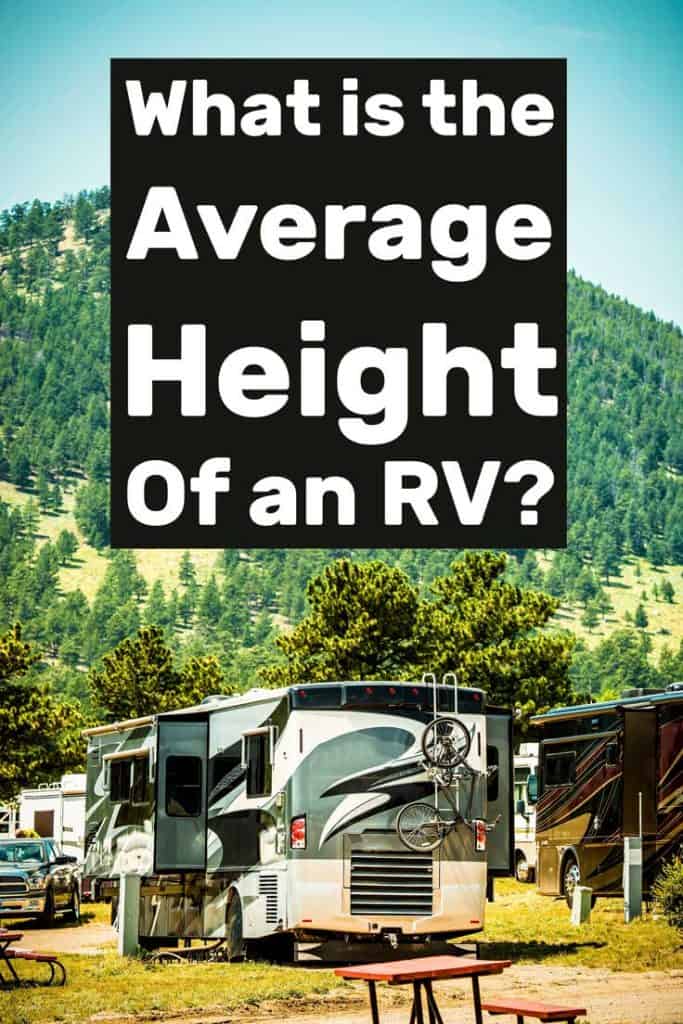
- 13 to 14 feet for Class A motorhomes
- 7 to 9 feet for Class B motorhomes
- 10 to 11 feet for Class C motorhomes
- 10 to 12 feet for travel trailers
- 11 to 13 feet for fifth-wheels
Now, those are just averages, meaning you could see height variations from one RV to another. That’s why, in this article, we’ll provide examples to several models of each motorhome type (and a few trailers to boot) so you can have some real-world examples to go off of.
Height Examples of Class A Motorhomes
Of the three motorhome types, Class As have the most heft. Their sheer bulk means they outsize Class Bs and Class Cs every time. On average, a Class A RV might stand at 14 feet. That’s quite a deal taller than a Class B and even up to three or four inches more than the average height of a Class C motorhome.
Here are some height examples for Class A motorhomes.
Winnebago Forza — 11+ feet
The 2019 diesel luxury Class A Winnebago Forza has an exterior height of 11 feet, 11 inches. Inside the vehicle, the interior height is six feet, eight inches across all floorplans.
Forest River Inc. Berkshire XL — 12 and a half feet
The huge Berkshire XL from Forest River Inc. stands at 12 feet, five inches. This is a mighty vehicle, too, as its Gross Vehicle Weight Rating or GVWR varies from 36,400 pounds to 38,230 pounds.
Newmar Dutch Star — 12 to 13 feet
The Newmar Dutch Star has a dozen floorplans to select from. Some have a height of 12 feet, 10 inches while others stretch to 13 feet exactly. The interior height for all floorplans is six feet, nine inches.
Height Examples of Class B Motorhomes
While Class A motorhomes are tallest, a Class B RV is one of the shortest, squattest, and smallest vehicles around. Even some trailers, like travel trailers and fifth-wheels, have more height than an average Class B. Let’s cover some height examples now.
Winnebago Travato — 9+ feet
Another 2019 Winnebago, the Travato Class B motorhome has a height of nine feet, four inches. You get less room inside, with an interior height of six feet, three inches regardless of the four floorplans you choose from.
Roadtrek Zion SRT — 9 and a half feet
Roadtrek produces only Class B RVs and camper vans. Their Zion SRT model has a height of nine feet, five inches when you add the roof air conditioner to it. More than likely, you’d have to subtract a few inches if you removed the air conditioner to get a true height measurement. The interior standing height measures six feet, two inches.
Thor Gemini RUV — 10 to 11 feet
Thor Motor Coach produces some massive RVs, and the Gemini RUV borrows some of that size even as a Class B. For instance, depending on the floorplan, the height of this vehicle starts at 10 feet, eight inches. The biggest model in the Gemini RUV family measures 11 feet tall. This does include an air conditioner, so again, you’d take away some inches for a truer measurement.
Inside this Class B, the interior height’s six feet, six inches.
Height Examples of Class C Motorhomes
Then there's the midweight RV, the Class C motorhome. These do have the height advantage on Class Bs and can sometimes stack up decently against the tallness of Class A motorhomes.
Let’s take a look at some heights of Class C RVs now.
Thor Four Winds — 11+ feet
The trendy Four Winds Class C RV from Thor Motor Coach has an exterior height of 11 feet with the air conditioner included. Some floorplans stand at 11 feet, two inches, again factoring in the AC unit. The Four Winds has an interior height of seven feet across all models.
Winnebago Navion — 11+ feet
Another Class C, the 2019 Winnebago Navion ascends to just 11 feet, one inch. The manufacturer says the chassis can play a role in overall height, but the vehicle’s at least 11 feet tall for all floorplans. As for the interior height, it’s six feet, eight inches.
Forest River Inc. Sunseeker — 11 feet, 3 inches
Continuing the trend of 11-footers, the Forest River Inc. Sunseeker measures 11 feet, three inches tall. You won’t find many longer Class C motorhomes than this model, but it’s not nearly as tall as you’d expect.
Height Examples of Travel Trailers
Moving on from RVs to trailers now, let’s talk a bit about travel trailers. They’re comparable in height to Class C RVs, making them a dependable mid-length vehicle that should fit in many a state park and campground.
We’ll now go over some examples of travel trailer heights.
Keystone RV Company Cougar Half-Ton — 11+ feet
We included the hefty Cougar Half-Ton from Keystone RV Company to show you that even with a large body, most travel trailers don’t have a ton of height. With five Cougar Half-Ton models, the heights vary. The smallest trailers are 11 feet, one inch, some mid-sized ones measure 11 feet, four inches, and the biggest sit proudly at 11 feet, eight inches.
Starcraft RV Mossy Oak — 10 and a half feet to 11+ feet
The Starcraft RV Mossy Oak travel trailer has several floorplans to choose from. These run the gamut from small, moderately-sized accommodations to lengthy trailers with all the fixings. On the smaller end, the trailer heights start at 10 feet, four inches. The bigger floorplans have a height of 11 feet, two inches. Do keep in mind the air conditioner’s included with these measurements.
KZ RV Escape Mini — 8+ feet
Opposite the Cougar Half-Ton is the KZ RV Escape Mini . We like this one since it’s a good example of a smaller travel trailer’s height. The Escape Mini isn’t very tall, only eight feet, eight inches. That’s before you add an air conditioner, by the way. Inside the trailer, the interior height measures six feet, eight inches.
Height Examples of Fifth-Wheel Trailers
Finally, there are fifth-wheel travel trailers. Known for their large front hitch, fifth-wheels are comparable in size to some Class A RVs. They might not look that tall, but looks can be deceiving. You’ll get more headroom in a fifth-wheel than most Class B and C motorhomes.
Read more: What Exactly is a Fifth-Wheel?
Without further ado, here are some fifth-wheel trailer height examples.
Keystone RV Company Montana — 13 feet, 4 inches
Getting started with another pick from Keystone RV Company, their Montana fifth-wheel is seriously tall at 13 feet, four inches for every floorplan. These ginormous trailers exceed 35 feet in length, so they’re pretty big all across the board.
Northwood Arctic Fox — 13 feet, 3 inches
No matter how oversized your Northwood Arctic Fox gets (and the 35-5Z floorplan stretches to about 39 feet), all the models have the same height: 13 feet, three inches. This isn’t anything to sleep on. Besides plenty of roominess, Northwood’s trailers have some of the most luxurious features you’ll find in a fifth-wheel.
Winnebago Minnie Plus — 11 feet, 11 inches
It is possible for some fifth-wheels to clock in at under 13 feet. Take, for example, the Winnebago Minnie Plus . There’s a mini version of this as well. Of the two, the Minnie Plus is bigger. The exterior height for all floorplans measures 11 feet, 11 inches. Okay, so that’s just shy of 12 feet, meaning the Minnie Plus isn’t that much shorter than most other fifth-wheels. It has an interior height of seven feet, one inch to seven feet, 11 inches.
In Conclusion
The average height of an RV depends on the size of the vehicle. Class As, the biggest of the bunch, often have the most height at over 13 feet. Class Bs will rarely clear the 10-foot mark, although some are 11 feet and up. Most Class C RVs sit squarely in the 11-foot camp as well.
Travel trailers have a height akin to a Class C, about 11 feet, although some smaller models can skate by at under nine feet. Even though you might not think so, most fifth-wheel trailers are so tall they’re about the same height as some Class A RVs.
Now that you’ve seen the heights of these RVs and trailers, you can choose one that fits your lifestyle and comfort needs. Good luck!
Related posts:
- RVs with a Loft (Including 7 examples)
- What Is a Bunkhouse Travel Trailer? (Including 12 Real-Life Examples)
- RVs with Porch or Patio [Including 5 Examples]
- How Much Do Motorhomes Weigh on average?
Leave a Reply Cancel Reply
Your email address will not be published. Required fields are marked *
Name *
Email *
Add Comment *
Post Comment
- Skip to primary navigation
- Skip to main content
- Skip to primary sidebar
Camper Trailer Report
Travel Trailers and RVs
What is The Average Travel Trailer Height?
By Mark on January 28, 2021
What is the average travel trailer height?
The width of a travel trailer may vary but their usual height is 13 feet . But just because it is supposed to be 13 feet does not mean it is, mainly because of the a/cs on top. You need to measure it and confirm if this is the height.
Most people never consider the height added by equipment, a/c, and other safety equipment. Then you either get fined or you hit a small bridge. This is an important issue because different states have different regulations on the max height of vehicles. This is because of clearance problems for most low bridges, small tunnels, etc. have included a list of the regulated height for vehicles and arranged them by state. The list is at the end of the article.
What is the ideal height of an RV?
The short answer is under 9 feet. The reason is that you will often be using your RV to enter business establishments. Whether it be a drive-through at Wendys or a bank. Most of these businesses have an armbar built over the entrance and it is at 9 feet. Anything above 9 feet will give you a hard time entering parking garages, car washes also most drive-throughs will also be inaccessible for you. So do not exceed 9 feet.
>> You may also like: 45 RV Accessory Must-Haves for Your Travel Trailer <<
What about the height of the hitch? (commonly referred to a trailer tongue)
The hitch’s height should be 18 inches. Most trailers will be level at this height and ride smoothly, but just in case you may want to measure what height your trailer is sitting and compare it to the height of the hitch. If it is not level then visit a mechanic to fix it.
Video Overview: RV Travel Trailer towing. Taller truck shorter Hitch
How tall can an RV be? Regulated Height per state.
- Alabama-height 13 feet 6 inches.
- Alaska- height 15 feet.
- Arizona- height 13 feet 6 inches
- Arkansas height 13 feet 6 inches.
- California- height 13 feet 6 inches.
- Colorado- height 14 feet 6 inches.
- Connecticut-: height 13 feet 6 inches
- Delaware- height 13 feet 6 inches.
- District of Columbia- height 13 feet 6 inches.
- Florida- height 13 feet 6 inches.
- Georgia- height 13 feet 6 inches.
- Hawaii- height 14 feet.
- Idaho- height 14 feet.
- Illinois- height 13 feet 6 inches.
- Indiana- height 13 feet 6 inches
- Iowa- height 13 feet 6 inches.
- Kanasa- height 14 feet.
- Kentucky- height 13 feet 6 inches
- Louisiana- height 13 feet 6 inches.
- Maine- height 13 feet 6 inches.
- Maryland- height 13 feet 6 inches.
- Massachusetts- height 13 feet 6 inches.
- Michigan- height 13 feet 6 inches.
- Minnesota- height 13 feet 6 inches
- Mississippi- height 13 feet 6 inches
- Missouri- height 13 feet 6 inches
- Montana- height 14 feet
- Nebraska- height 14 feet 6 inches.
- Nevada- height 14 feet.
- New Hampshire- height 13 feet 6 inches
- New Jersey- height 13 feet 6 inches.
- New Mexico- height 14 feet.
- New York- height 13 feet 6 inches.
- North Carolina- height 13 feet 6 inches
- North Dakota- height 14 feet.
- Ohio- height 13 feet 6 inches.
- Oklahoma- height 13 feet 6 inches.
- Oregon- height 14 feet.
- Pennsylvania- height 13 feet 6 inches.
- Rhode Island- height 13 feet 6 inches.
- South Carolina- height 13 feet 6 inches
- South Dakota- height 14 feet.
- Tennessee- height 13 feet 6 inches.
- Texas- height 14 feet.
- Utah- height 14 feet.
- Vermont- height 13 feet 6 inches.
- Virginia- height 13 feet 6 inches.
- Washington- height 14 feet.
- West Virginia- height 13 feet 6 inches.
- Wisconsin- height 13 feet 6 inches
- Wyoming- height 14 feet.
- Puerto Rico- height 13 feet, 6 inches.
You may also like: First Time Travel Trailer Owner Tips, Beginner’s Guide. <<
Related Questions:
How tall is a travel trailer with ac.
Tall travel trailer with AC tends to have a height equal to class C have ranged around 11 feet. Size tends to vary depending on a class. Class A RVs and those with fifth wheels tend to be huger and taller, their height ranging over 13 feet. Most class C RVs are between 11-12feet, and class B tends to be the smallest, with measurements of around 9-10 feet.
How Tall Can Your Trailer be?
Stale laws for different places differ; many states have exceptions concerning height limits depending on the type of roads they can allow for either short or tall trailers. There is a standard that a camper trailer cannot exceed 13.6 feet. There are travel trailers with 12-foot high roofs, but they are rare; others are way shorter than 10-11 feet.
What is the Best Length for a Travel Trailer?
Depending on the RV class, there exists different lengths and style for each category. Researchers discovered that travel trailers range between 20-40, but 30 feet is the average length to fit into a campground. The most standard motorhome length for the trailers’ different classes is Class A 33 feet, class B 20 feet, and class C 28 feet.
You may also like: 25 Best National Parks in the USA <<
How To Build RV Carport:
Does RV Height include an AC Unit?
Knowing the details about your RVs height is crucial because driving a too elevated RV can be dangerous and illegal. Different state laws advocate for different RV heights depending on their roads in terms of bridges and overpasses. Exterior RV height determines how tall it is and does not include anything mounted on top of the RV. Most states, e.g., Georgia, advocate for a maximum height of 13.5 feet.RV height is exclusive of the air conditioner, or any other additions mounted.
What Travel Trailer has the Highest Ceiling?
Various states have varying state laws concerning travel trailers’ heights though 13.5 is generally considered the average maximum size. Travel trailers have a maximum average height of 11 feet. The interior height of a travel trailer is equal to the measurement from the floor to the ceiling.
It’s an important consideration, especially if you are tall, you want to ensure you can stand comfortably in the trailer without strain. Regardless of class, the average interior height of the trailer should be 6.5 feet. Higher ceilings are available if need be. The travel trailer with the highest roof is the Sandpiper Destination Trailer, which has an interior headroom as much as that of a traditional home. The internal height is a whopping 7’10” tall!
> You may also like: How To Prepare Your Truck for Towing: 9 Important Tips <<
Related Posts:

Sharing is caring!

Average Weight Of A Travel Trailer (With 35 Examples)
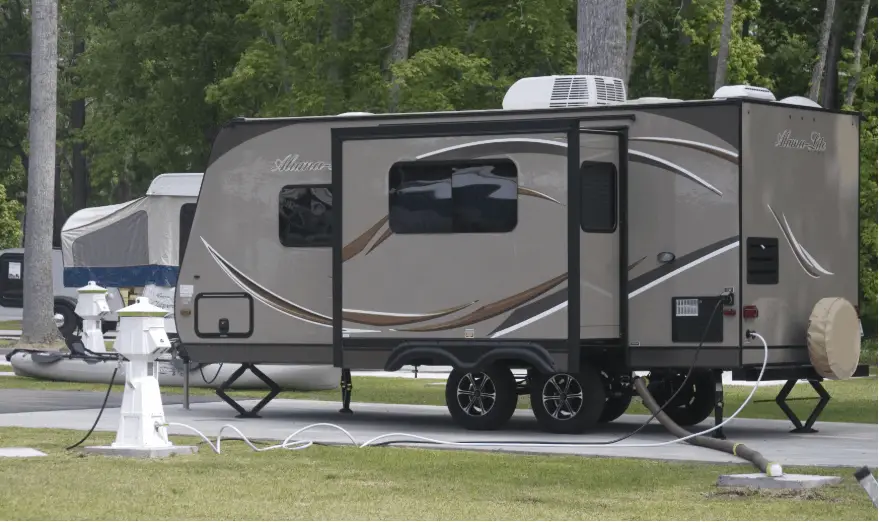
- BEGINNERS GUIDE
G. Yoganand
Travel trailer weight is a significant parameter if you are about to buy either a new or used one. So, how much do travel trailers weigh normally? This is an important thing to know if you want to know all options for your car or truck.
The weight of trailer camper is generally mentioned by the manufacturer, but they also mention many other ratings which should not be overlooked.
A trailer weight is not only the weight it carries when build, but will also include all other things you pack in.
Their weight depends on length, and many other factors. Lets see some examples and draw conclusion on the weights of travel trailers or campers.
How much do travel trailer weigh on an average
Many people buy travel trailer due to their cost and size. A travel trailer is very popular option in rv’s. One question that many people often have is how much do the travel trailers weigh.
Travel trailer weight varies widely and on an average it is between 1000 lbs to 8800 lbs.
Most of the popular travel trailer have lengths between 15 feet to 35 feet.
Comparing several travel trailers and their wights below is the average weight of travel trailer for different lengths.
The weight of travel trailer depends on the size or length. When understating the weight parameters in pounds there are multiple thing that you should understand rather then just going by the weight called out by the dealer in manual.
In this post, we will see average weight of travel trailers and various other terminologies related to travel trailer weight.
Understanding the weigh of a travel trailer is important because you are supposed to pull it using a car or suv.
A car will have certain limit and if your trailer exceeds that limit then that could be a problem. Towing a trailer initially can be tough but following the tips that i gave in my previous article can make it super easy, do check it out.
When you head out for camping, you end up packing lots of things and with a full gas tank plus a full water tank, will mean lots of weight. Thus, it becomes more important that you have fair idea of where the weight is heading. Apart from understanding the dry weight of travel trailer, get a fair idea of other weights related to it.
In case, you want to know how to find dry weight , do check linked detailed guide.
A hitch should also be good enough to handle the overall weight. Also, with a rv, you are supposed to follow certain rules related to weight. Once you cross certain weight limit even the drivers license requirement change in some states.
Read : 17 Tips to reduce RV Weight
One thing many people try to check is if they can find smaller travel trailer that have less weight. A smaller less weight travel trailer lets you pull it easily.
We will also see how travel trailer weight varies by length. Once you have that idea, it can be helpful to determine the approximate weight based on length.
Travel trailer weight variation on the basis of length
Main reason why people want to know about the weight of their travel trailer is to determine if their car or truck can tow the trailer or not. A travel trailer has length that ranges from 17 feet to 40 feet.
More the length, more is the weight of travel trailer. A 15-18 feet travel trailer will obviously weigh less than a 30 feet one. That is to say, we can almost say that weight of the travel trailer is proportional to its length. This however, may not be always be correct as with new models, construction type material the weight is varies.
New year models released and built are less heavy and thus, we can also say weight is inversely proportional to year make of the travel trailer. On an average a 16 feet length travel trailer will have a unloaded weight of around 2200 lbs to around 3400 lbs. A 30 feet travel trailer can weigh around 7000 lbs to 7800 lbs.
This may however, be not true for all makes and brands, it will always vary. But, on an average you will find the numbers to be very close. A 20 feet travel trailer can be as heavy as 2700 lbs to 2900 lbs. With advances in the way travel trailers are manufactured, you will also find a 15 feet travel trailer weighing just above 1500 lbs unloaded or even an 13 feet long travel trailer weighing below 1200 pounds.
Travel trailer are smaller rv’s, they sleep 2-3 people at times and can also be lengthy about 40 feet long. A travel trailer weight also depends on the floor plan, kind of dinner built in, position of the bath, kitchen positioning, entry exit doors, window positioning, bed style (this things require changes, adjustments then lead to weight variations).
How much do small travel trailers weigh
Lets see some examples of travel trailers along with their weight and length. This should give a fair idea of relation between length and weight of a travel trailer. These are some of the smaller travel trailer that are popular under the weight of 4000 pounds.
- Forest River Flagstaff E-Pro 12RK – 11 feet long and weighs around 1150 lbs
- ALiner Ascape camp travel trailer – 13 feet long and weighs around 1495 lbs
- Forest River Flagstaff E-Pro 14FK – 14 feet long and weighs around 2010 lbs
- ALiner Ascape plus travel trailer – 13 feet long and weighs around 1150 lbs
- KZ Sportsmen Classic 130RB travel trailer – 15 feet long and weighs around 2126 lbs
- ALiner Ascape MT travel trailer – 13 feet long and weighs around 1170 lbs
- ALiner Ascape ST travel trailer – 13 feet long and weighs around 1575 lbs
- Forest River Flagstaff E-Pro 16BH – 18 feet long and weighs around 2870 lbs
- KZ Sportsmen Classic 150BH travel trailer – 17 feet long and weighs around 2260 lbs
- Forest River Flagstaff E-Pro 17PR – 20 feet long and weighs around 3160 lbs
- KZ Sportsmen Classic 151RB travel trailer – 18 feet long and weighs around 2530 lbs
- Forest River Flagstaff E-Pro 17RK – 20 feet long and weighs around 2930 lbs
- KZ Sportsmen Classic 180BH travel trailer – 20 feet long and weighs around 2620 lbs
- Forest River Flagstaff E-Pro 19FBS – 20 feet long and weighs around 2960 lbs
- Jayco Hummingbird 16FD travel trailer – 18 feet long and weighs around 2535 lbs
- KZ Sportsmen Classic 160QB travel trailer – 22 feet long and weighs around 2740 lbs
- Jayco Hummingbird 16MRB travel trailer – 19 feet long and weighs around 2780 lbs
- Forest River Flagstaff E-Pro 19FD – 20 feet long and weighs around 2825 lbs
- Jayco Hummingbird 17BH travel trailer – 19 feet long and weighs around 3015 lbs
We can determine a fair idea of weight based on travel trailer length. But that may not be always true. A length cannot be the ultimate decider to figure out the exact weight of a travel trailer, as seen from examples a 20 feet long travel trailer (of not only different make, but even same brand) weighs differently. Thus, it also depends on the floor plan, amenities and many other things packaged in the trailer.
How much do longer travel trailers Weigh
As we already saw a longer travel trailer will weigh much more and it is almost proportional to its length. A 40 feet travel trailer will have enough weight to make you think if the car you have, is good enough to pull it or not.
Even a 25 feet or 30 feet long travel trailer is much heavier and you need to be sure about the capacity of your pulling car. Lets see some of the examples to understand better and draw some conclusion on length-weight relation for heavier travel trailers.
Examples here in are also some of the best travel trailers you could buy in the range of 28 feet and 30 feet with weights under 5000 pounds and so on. While some are quoted just to see how the best and average travel trailers weigh in different segments of lengths.
- Keystone RV Passport 175BH Express travel trailer – 22 feet long and weighs around 3250 lbs
- Keystone RV Passport 195RB Express travel trailer – 23 feet long and weighs around 3805 lbs
- Forest River RV Flagstaff Classic Super Lite 831CLBSS travel trailer – 35 feet long and weighs around 8105 lbs
- Forest River RV Flagstaff Classic Super Lite 832FLBS travel trailer – 35 feet long and weighs around 8621 lbs
- Keystone RV Passport 195RBWE Express travel trailer – 23 feet long and weighs around 3812 lbs
- Keystone RV Passport 2200RBWE Grand travel trailer – 25 feet long and weighs around 3805 lbs
- Forest River RV Flagstaff Classic Super Lite 831BHDS travel trailer – 34 feet long and weighs around 7970 lbs
- Forest River RV Flagstaff Classic Super Lite 31BHWSS travel trailer – 34 feet long and weighs around 8386 lbs
- Keystone RV Passport 234QBWE Express travel trailer – 25 feet long and weighs around 3870 lbs
- Keystone RV Passport 239ML Express travel trailer – 25 feet long and weighs around 4140 lbs
- Prime Time RV LaCrosse 2911RB travel trailer – 31 feet long and weighs around 6516 lbs
- Prime Time RV LaCrosse 318BHS travel trailer – 36 feet long and weighs around 8022 lbs
- Keystone RV Passport 2400BH Grand Touring travel trailer – 28 feet long and weighs around 4840 lbs
- Keystone RV Passport 2670BH Grand Touring travel trailer – 30 feet long and weighs around 5344 lbs
- Prime Time RV LaCrosse 324RST travel trailer – 37 feet long and weighs around 8334 lbs
- Prime Time RV LaCrosse 329BHT travel trailer – 37 feet long and weighs around 8815 lbs
From the examples we could see that a 26 feet long travel trailer on an average weighs around 3800 lbs to 4150 lbs . A 28 feet long travel trailer weighs in the range of 4300 lbs – 4900 lbs. A travel trailer between the length of 32 feet to 38 feet weighs 7200 lbs – 8500 lbs .
This should be enough to paint a fair idea of how a length of travel trailer is related to its weight. But, the weights are unloaded weights and should not be confused with the overall weight of travel trailers
Understanding the travel trailer weight terminology
A travel trailer weight or weight of any other rv need to be understood correctly. The numbers that you get from the manufacturer or dealer could be misleading and misunderstood.
The weight details of various sized travel trailers that we saw are the unloaded weights. You basically need to do the math properly to see if the travel trailer weight is within limits for your car to pull.
Weight understanding in case of travel trailer is much more important than motorhomes which drives themselves (which is not the case for travel trailer or fifth wheel or pop up campers or any other towable trailers). Its important you understand the rv weight terminology .
A rating provided by manufacturer cannot be changed. Normally weight and load are same when you talk weight of rv’s. Basically, a weight of rv puts load on rv tires, axles and hitches.
This load is used to calculate various rating like GAWR (gross axle weight Rating), GCWR (gross combination weight Rating), GVWR (gross vehicle weight Rating). Lets, try to understand what exactly these things mean and how you should interpret values for these.
Gross Axle Weight Rating (GAWR) – This rating basically is the maximum load that the axle of the trailer can support. Trailer manufacturer provides this rating and it basically depends on axle, tire, wheels and the rating is based on the weakest link.
Unloaded Vehicle Weight (UVW) – This is the weight of the RV or travel trailer when it is fully unloaded without any extra things on it. Usually the weight that you see when it is at the dealer and not yet sold.
The weights that we saw above were unloaded weights. Most times people are confused with this weight, and assume the unloaded weight as the final towing weight. But, in reality the weight increases when you actually pull the trailer with all the things packed in.
Gross Vehicle Weight Rating (GVWR) – This rating means the maximum weight that is allowed on the RV including all the things like the passengers, driver, water, fuel. The trailer and the towing vehicle will both have their own GVWR.
Gross combination Weight rating (GCWR) – Unlike GVWR, the GCWR is the combination rating for both the trailer and the towing vehicle. It gives the maximum combined limit for the tow vehicle and the travel trailer.
Cargo carrying capacity (CCCC) – This basically means the weight of the trailer without the optional accessories, equipment in the trailer.
Net carrying capacity (NCC) – This is the weight of all own or personal things included on the trailer or rv. For example, the combined weight of fuel, water, food, gas, equipment tools etc
Sleeping Capacity weight rating (SCWR) – This basically gives the maximum weight limit depending on the number of sleeping positions designated by manufacturer. Each included person is assumed to be around 154 lbs and thus, a 2 sleeping travel trailer will mean its SCWR will be 208 lbs and so on.
Importance of Weight distribution in travel trailer
In case of travel trailer, the weight distribution is significant. An un-even weight distributed can be dangerous and the towing hitch and the trailer can be impacted.
You need to make sure the overall weight is properly distributed. The idea is to make sure weight is properly distributed along all sides, front to back and from both right and left sides.
Rv’s and travel trailer are originally designed with proper weight distribution, and when you tow the travel trailer you need to follow same when putting in more weight through other things.
The weight of both the tow vehicle and travel trailer should be properly distributed. Technically speaking, you also need to make sure the Gross Vehicle weight Rating and gross combined vehicle weight rating is not crossed at any time.
To understand the proper rules of weight distribution, you can read the manufacturer provided manual for your travel trailer or camper.
In most cases, the idea is to keep 60% of the weight ahead of the center of gravity of the travel trailer. To understand the correct weights of your travel trailer, its better to weigh it after it is fully loaded with all stuff.
An uneven distributed weight is notable with naked eyes, but may not always be visible hence its better to keep the weight within limits and properly distributed.
One can also use weight distribution systems to make it properly distributed. Weight distribution systems work using spring bars which correct uneven weight distribution.
What affects Weight of travel trailer – which things put on extra weight
Lets try to understand how the weight of the travel trailer is affected. What all things put on that weight.? An unloaded weight will be less but when you head out finally, the weight of the overall travel trailer could go out of limits and that’s what we should try to limit.
Water – Camping need lots of water. And water adds weight to your travel trailer ? yes, do not underestimate the power of water weight. It weighs almost 8 lbs per gallon. A 50 gallon water in a travel trailer will mean you already have put on 400 lbs extra on travel trailer.
Generator – A generator is a necessary thing in you rv. You get portable generators that weigh less but even then, they can be best weighted at 300-400 lbs and that is much to add to the limited capacity travel trailer.
More watts will generally mean more weight for the generator. Thus, getting the right size generator can be a wise thing to do. But, it may not be a simple calculation for many of us and that’s why i wrote this detail guide on how to choose the right size generator for your RV (You AC is mostly the deciding factor, check out how!)
Construction material affects weight – A travel trailer construction material type is also responsible for its weight. A fiberglass made trailer generally weigh less as compared to aluminum ones.
This however, should not be your problem as this will be included in the unloaded weight which is not in your hands anyways. But, understanding the material type of your travel trailer can be helpful as choosing the right one will mean your travel trailers unloaded weight itself is less.
Slide outs Increase weight – A slide out for your rv increases the overall weight. Its extra space but extra weight too. A slide out normally adds upto 1000 lbs on an average. Pop up are less heavy and that can be a good option as compared to slide outs if you are looking to reduce the overall weight on your travel trailer.
Read : Weight Holding capacity of Slide Out in RV
How to reduce weight on your travel trailer – tips to stay light
Weighing your rv often is the best thing you could do (in case you are confused on how to weigh your rv, here is a article that i posted about it). Regularly checking the weight helps to plan and you will stay within the rating limits. Lets see some of the things you could follow to reduce the weight and stay in limits
1. Get rid of extra things on your rv. Extra tools, extra equipment, unused personal belongings like shoes, clothes, books etc. Unused kitchen items, bedroom, bathroom accessories you don’t use more often should be kept out. All smaller things add up to put on those pounds which add-on to become a big number.
2. Weigh the travel trailer separately with car and without car. This gives great picture of what is happening and where the weight is distributed.
3. Get good weight distribution system to make sure weight is properly distributed.
4. While heading out for camping make sure you pack things which are absolutely needed and do not pack out of limits
5. Have only number of people allowed as per manufacturer manual. A human weight of around 150 lbs can be more than enough to cause the imbalance of weight distribution
6. Make sure tires are properly inflated. Maintain correct tire pressure for both travel trailer and car at all times.
7. Use aluminum in case you want to do any repairs or modifications to your travel trailer. Aluminium is light weight and thus will not put on extra weight on your travel trailer. Many times, people do patch work like filling in holes, cracks or structural changes to the travel trailer. All these smaller things should be done with materials that are less in weight and should not add on weights.
8. Get rid of things that are not in use for months or have become old. A ladder that you hardly need, an awning that is broken or things like kayak that you occasionally need. Remove things that you don’t use often or things of past that need replacement, just go ahead and replace them. This will not only save space but also reduce the unnecessary weight.
9. Get the sliding doors replaced with curtains. Doors that aren’t used for privacy and are in place just, can be removed and replaced with curtains or any other such fabrics used instead of heavy doors.
10. Replace old heavy things with new lightweight ones. Drawers, bins, shelving that are heavy and old, could be putting in weight unnecessarily and you should try and get things that are new and less in weight. You will find lots of innovative products specially designed for RV that are compact and lightweight.
Travel trailer weight comparison with Other Rv’s (Class C RV and class A RV)
A mini motorhome or a class C rv on an average weighs around 10,000 lbs to 14,000 lbs. That is almost double than an average weight of a travel trailer.
Class C motorhome are also longer than travel trailers, they tend to be around 18 feet – 30 feet long. Class A motorhomes on the other hand are the heaviest ones, they weigh much more.
On an average class A rv’s weighs anything between 15,000 lbs to 30,000 lbs. They are really heavy, and much more than a travel trailer. With so much weight they tend to intimidate you on road. Remember, with weight also the license requirement changes.
Read : How much weight RVs roof are capable to support
There is limit on weight up-to which you can drive using normal non commercial license but if the weight goes beyond certain limit then you need special license.
The rule of weight is different for all states. Like in California, a weight more than 26,000 lbs for a non towable RV will need a class B Non commercial license. Most states have similar requirement but could be little different for some states (need to check with each states rules and regulations).
A travel trailer to be towed has a weight limitation of around 10,000 lbs in most states and beyond that you will need class B Non commercial license. Looking at these numbers of pound for travel trailer, most of the times you will be okay with the normal license unless you have that very big trailer weighing more than 10,000 lbs.
If you are ready to tow your travel trailer and start the RV adventure then do start by getting all the essentials for your trailer (this is a complete list that you will need)
A travel trailer weight measurement is of much importance since it has the power to affect many other things in the camper trailer.
Apart from getting to know just the unloaded weight of the trailer, knowing all the other ratings help in towing car-trailer system smooth. A travel trailer weighs less as compared to other bigger rv’s however it is more important to know the weight in case of travel trailers. A travel trailer weight unloaded should not be your only way of judging the capacity of your car to tow.
Understanding overall weight when fully loaded and with full water/fuel tanks is more necessary. Going through manufacturer manual, weighing your trailer often are best practices to follow.
Keeping the travel trailer as light as possible can come good for your towing car or suv. Keeping the weight distribution proper is also important and proper hitches or distribution system can come handy. One should fully understand the towing capacity of the car and then manage the weight on travel trailer. Owning a very heavy trailer also needs special license requirements and thus better to make sure the weight is within limits.
You Might Also Like
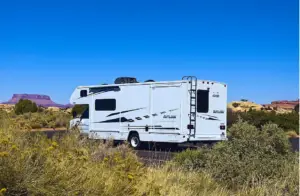
Where Can I Wash My RV?

Kimbo Camper Review

Why Do RV Tires Blow Out? (And How To Prevent It)

10 Best Luxury RV Resorts In Texas, US
Map Options

Average Height by State 2024
The average height in the United States is 5 feet 4 inches (162.56 centimeters) for women and 5 feet 9 inches (175.26 centimeters) for men. This makes the United States the 40th tallest nation in the world.
Multiple factors contribute to one’s overall height. Genetics account for 60-80% of one’s height, and nutrition and exercise account for the remaining percentage. Childhood nutrition is believed to be a large factor in adult height. Race plays a large role in average heights in populations. White men (average height of 5 feet 10 inches) and black men (5 feet 9 inches) tend to be taller than Asian (5 feet 7 inches) and Hispanic (5 feet 7 inches) men. Alabama is one of the tallest states in the US and has a population that is 96% black or white.
To determine the average height in each of the 50 states, information as pulled from the Center for Disease Control’s (CDC) Behavioral Risk Factor Surveillance System (BRFSS). This is an annual survey of more than 450,000 people conducted by the CDC to gather data about health and wellness in the United States, including health-related risk behaviors, chronic health conditions, and the use of preventative services. The BRFSS tracks weight and obesity , healthy eating, physical activity, and height.
The tallest states based on average height for men and based on average height for women are different. The tallest women tend to be clustered in the northern plains states, with the tallest living in South Dakota . The tallest men live in Iowa and Alabama. The tallest states in the United States based on the average height for men (179 centimeters or above) are:
- North Dakota
- South Dakota
- West Virginia
The tallest states in the United States based on the average height for women (164 centimeters or above) are:
- District of Columbia
Hawaii has the shortest average height among both men and women. This can be attributed to the race factor previously mentioned. Hawaii’s population is less than one-third Black or white. Below is a table of each state’s average height for men and women. The data is self-reported; therefore, heights tend to be over-reported, about 2.7 centimeters for men (1 inch) and about 1.5 centimeters for women.
- Data is self-reported, so it is not 100% correct. In 2016, men self-reported their heights an average of 2.3 centimeters, or nearly a full inch, above what their actual measurements showed. Women over-reported their height too, by about 1.5 centimeters.
Download Table Data
Enter your email below, and you'll receive this table's data in your inbox momentarily.
- America’s tallest and shortest states
- https://www.cdc.gov/brfss/annual_data/annual_2018.html
site categories
Selena gomez unsure she’ll ever tour again, indy 500 viewership revs past 2023 viewership as josef newgarden wins on final lap.
By Erik Pedersen
Erik Pedersen
Managing Editor
More Stories By Erik
- 2024 Premiere Dates For New & Returning Series On Broadcast, Cable & Streaming
- Al Ruddy Dies: Oscar-Winning ‘The Godfather’ & ‘Million Dollar Baby’ Producer Was 94
- 2024-25 Awards Season Calendar – Dates For Oscars, Tonys, Guilds, BAFTAs, Spirits & More

The Greatest Spectacle in Racing drew more TV spectators this year, despite a nearly four-hour weather delay .
NBC Sports said today that its coverage of Sunday’s thrilling Indianapolis 500 averaged 5.34 million viewers across NBC, streamer Peacock and NBC Sports digital platforms in preliminary numbers. That’s up by 8% over the 2023 race and by 10% over 2022.
Watch NBC’s coverage of the heart-pounding final lap below.
Related Stories

Bill Walton Dies: Basketball Hall Of Famer & Emmy-Winning Sportscaster Was 71

Grayson Murray Dies: Two-Time PGA Tour Winner Was 30 – Update
The race is also the most-streamed IndyCar race ever, with an average minute audience of 286,000 viewers across Peacock and NBC Sports digital platforms.
Final ratings results will be released Wednesday.
Must Read Stories
Bleecker street ceo andrew karpen rebounds from brain cancer diagnosis.

Mike Flanagan Set To Direct “Radical New Take” On ‘The Exorcist’
Ron howard on telling jim henson’s story, john candy, roger corman & more, ‘anatomy of a fall’s sandra hüller joins ryan gosling in ‘project hail mary’.
Subscribe to Deadline Breaking News Alerts and keep your inbox happy.
Read More About:
No comments.
Deadline is a part of Penske Media Corporation. © 2024 Deadline Hollywood, LLC. All Rights Reserved.

These 5 Luxury Campervans Will Blow You Away
Y ou may have seen campervans while driving on the highway, but if you haven't ridden in them yourself, you have no idea how luxurious these homes away from home can be. Along with the ability to travel just about anywhere, luxury campervans can offer amenities you might find in a top-tier hotel room.
Most campervans start with a base of either the Ford Transit or the Mercedez-Benz Sprinter , both of which are reliable and fairly easy to drive. From there, it's all about choosing a company that specializes in van conversions — and there are many available.
One thing is for sure, however, these decked-out vans don't come cheap. Once you add in a working bathroom, shower, custom swivel seats, solar paneling, and countless other possibilities, it could run you anywhere from $100,000 up to over half a million dollars.
However, what you get for that hefty price tag is the freedom to explore the country in comfort and style, while being self-reliant – at least for a while. After all, at some point, you're going to need hookups for water, sewage, and a place to replenish supplies like food and other common items, but that's all part of owning a campervan.
With that said, some of these campervans are so loaded with luxuries and extras that it will blow your mind that they are even available.
Read more: Every Major Luxury Car Brand Ranked Worst To Best
Airstream: Atlas
Airstream has been known for decades because of its retro , yet impressive silver trailers, but its Atlas campervan is truly a sight to behold. It's built on the Mercedez-Benz Sprinter chassis, and has a power slide-out section that you can use to give you more room in the cabin while parked. It has an expansive three-person couch, swivel chairs up front that can turn towards the cabin for more seating area, and it has a sink and two burners for cooking.
When it's time to turn in, you can press a button to engage the power slide-out section to make room for a Murphy bed that drops down in place of the couch. It also offers a shower, toilet, and sink at the rear of the cabin.
Whether you're lying in bed or sitting on the couch, the Atlas also has a hideaway 40-inch Samsung flat-screen television that rises up out of the counter at the press of a button. When you wake up the following morning, you can slide out the included awning so you're out of direct sunlight when you drink your morning coffee.
It has all the bells and whistles you need when you're out on the road or parked at the campsite, but it will cost you. The 2024 Airstream Atlas goes for just over $310,000.
Advanced RV: B Box
Advanced RV, like several other campervan conversion companies, strips the van down to the chassis and then builds a "box" that is then securely bolted to the chassis. Picture a van that's been cut away completely from behind the cockpit, leaving only the bottom frame and wheels. Advanced RV builds the living space, and then places it on the Mercedes-Benz Sprinter chassis.
Everything about this thing is custom. You go in to pick out all the amenities you want including fabrics, colors, and materials and once your build is agreed upon, Advanced RV gets to work on building your "box" to your specifications.
The interior height of the cabin is 6 feet, 8 inches, so most will be able to comfortably walk around at full height. It has a seating area at the back along with a television, and the seating area turns into a bed when it's time to get some sleep. It also has a kitchenette on one side and a bathroom on the other.
Again, these are fully custom-made to your requirements so prices vary, but the average cost starts at about $380,000 and can go up to over half a million dollars.
Storyteller Overland: Beast Mode
If you're looking for something that's a little more rugged in a campervan, Storyteller Overland's Beast Mode will definitely fit the bill. Its all-wheel drive Mercedes-Benz Sprinter chassis — with off-road wheels and tires — begs to be driven in the dirt so you can get to the best camping areas. It's got a modular roof rack, a side ladder, and a rear-door setup that features a lockbox for storage. It even has a side-mounted surfboard holder if you like to carve it up in the surf.
For all of its ruggedness on the outside, its comfort and amenities on the inside will make for a great overnight in the woods. It has a kitchen with an electric burner, a bathroom, and a portable shower you can store when you're not using it. It has dimmable LED ceiling lights and in the cargo areas. When it's time to go to bed, Beast Mode offers a fold-down bed in the rear, and a 2-seater convertible sofa bed so you can sleep up to four people.
This campervan is perfect for the outdoor adventurer, but it will cost you: The 2024 Beast Mode costs a little over $230,000.
Thor Motor Coach: Tranquillity
The Thor Motor Coach Tranquility campervan sits on a Ford Transit chassis so it's a little smaller than other vans in this category, but manages to pack in the features.
It's got two captain chairs in the front that can swivel to face the cabin when parked. It features a dual-burner gas stove, a sink, and a clever table and seating setup so you can share a meal with friends. It's got a microwave built-in and a single-door refrigerator. It even has an HD TV that's mounted on a swingarm for flexibility. That's a lot of features for the comparatively smaller cabin size next to other campervans.
When it's time to go to sleep, it has a convenient fold-out bed. This is a great design for the limited space, meaning you have more room to move around during the day when you're not using it. Impressively, the bathroom is enclosed, so you can use it or the shower with some measure of privacy.
The Tranquility is a little more of a bargain than other deluxe campervans , costing just under $175,000.
Outside Van: Approach
Outside Van's Approach campervan uses the Mercedes-Benz Sprinter chassis as its framework, and offers all the amenities you need while out in the wild. For off-road driving, it has all-wheel drive and thicker-than-average tires for better control. You can comfortably feed a family of four on its dinette table, and it has both a bathroom and a shower. The Approach also sleeps up to four people with a cleverly designed two-level bed system.
One interesting feature that is not found in other campervans is a roll-down divider that makes it so you can create separate "rooms" for added privacy when you need it. It also has full temperature control, with both a heater and air conditioning to keep you comfortable.
When you want to cook dinner, you can use the removable induction cooktop or an overhead microwave. For entertainment, it offers a wall-mounted television with a DVD player. It also has a roof-mounted rack for flexible storage capabilities, and a side ladder to make it convenient.
The Approach looks sleek on the outside, and has everything you need on the inside for when you're in for the night. The Approach build costs around $275,000.
Read the original article on SlashGear .

Screen Rant
The iron claw: how many von erich brothers there were in real life.

Your changes have been saved
Email Is sent
Please verify your email address.
You’ve reached your account maximum for followed topics.
How Tall Zac Efron Is & How His Height Compares To The Iron Claw's Kevin Von Erich
All 7 real-life wrestlers in the iron claw, the iron claw: kerry von erich’s real feud with ric flair explained.
Warning: This article contains spoilers from The Iron Claw and mentions suicide and depression.
- The Iron Claw focuses on the more famous Von Erich sons, omitting two of Fritz Von Erich's six sons: Jack Jr. and Chris.
- Chris, the youngest member of the Von Erich family, is completely missing from the film, as the director felt he couldn't address his story adequately in the narrative.
- Despite the struggles depicted in the film, Kevin and Pam went on to start their own large family, and their sons, Ross and Marshall, became successful wrestlers.
A24's The Iron Claw is loosely based on the real-life events of one of wrestling's most prolific yet tragic families, the Von Erich, and here are how many Von Erich brothers there were in real life. While the film depicts the trials and tribulations of parents Fritz and Doris Von Erich — as well as their sons Kevin, Kerry, David, and Michael — there are other members of the Von Erich family who received little to no screen time . Set between the late 1970s and the early 1990s, The Iron Claw follows the second-oldest Von Erich, Kevin, as he struggles to keep his family and himself afloat through the Von Erichs' struggles to become the greatest wrestling family of all time.
While liberties are taken with the Von Erich story , the filmmakers strike a balance when it comes to the facts and inaccuracies in The Iron Claw by highlighting the most important elements of the true story while downplaying or omitting superfluous information for the sake of a consistent narrative and average runtime. However, among one of The Iron Claw 's more questionable decisions is its handling of the Von Erich brothers, as the film only depicts Kevin, Kerry, David, and Michael to any significant extent. Despite The Iron Claw 's depiction, the real Fritz Von Erich had more than four sons.
Zac Efron plays legendary pro-wrestler Kevin Von Erich in The Iron Claw, but the actor and wrestler aren't quite the same height in real life.
Fritz Von Erich Had Six Sons In Real Life
The iron claw only focuses on four of them.
The Iron Claw focuses on Fritz Von Erich's more famous sons: Kevin, Kerry, David, and Michael. However, Fritz Von Erich actually had a total of six sons in real life , the additional two being Jack Jr., the eldest, and Chris, the youngest. During a scene where Kevin tells his future wife, Pam, about his family, he mentions that Jack Jr. passed away when he was a boy in a tragic family accident. He further explains that he believes the death was the result of the Von Erich family curse, a curse they supposedly inherited after Fritz changed the family's last name from Adkisson to Von Erich.
The Iron Claw does depict Jack Jr. , but it is only briefly during the climax, when he, Kerry, David, and Michael reunite in the afterlife. However, the sixth and youngest member of the Von Erich family, Chris, is missing from the film entirely. Based on the real-life account of Chris' life, he grew to be 5'5," and weighed no more than 175 pounds. His small stature and inability to establish himself as a major wrestler, combined with Mike's suicide, contributed to Chris' severe depression. He committed suicide in 1991. Writer-director Sean Durkin felt The Iron Claw needed to omit Chris' story to better serve the already-long narrative.
How Many Kids The Von Erich Brothers Had
Who is part of the third generation of von erichs.
The many Von Erich brothers ended up giving birth to a third generation of Von Erichs, with some of them having children. Kevin Von Erich ended up having four children, two of which went on to be professional wrestlers . David Von Erich had one child, and Kerry Von Erich had two children, one of which is a professional wrestler.
The Iron Claw depicts several famous real-life pro wrestlers but also features a number of cameos who have decades of collective wrestling experience.
Are Any Von Erich Family Members Still Wrestling?
Here's which von erichs are still active.
Although The Iron Claw depicts the struggles that the Von Erich family endured, the film ends on a hopeful and optimistic note. The Iron Claw 's ending sees Kevin and Pam starting their own large family, highlighting Kevin's resilience and ability to overcome insurmountable odds. Thus, it is good to know that some of these Von Erich descendants are still wrestling to this day.
After the events of The Iron Claw , Ross and Marshall Von Erich, Kevin and Pam's sons, followed in their father's footsteps and became successful wrestlers in their own right. Kerry's daughter, Lacey Dawn Adkisson, who is now retired, wrestled between 2007 and 2010 as Lacey Von Erich, thus briefly continuing her father's legacy outlined in The Iron Claw as well.
The Iron Claw (2023)
The Iron Claw portrays the rise and fall of the Von Erich family, a dynasty in professional wrestling. Directed by Sean Durkin, the film explores the family members' personal struggles and tragic fates and the lasting impact they left on the sport.

IMAGES
VIDEO
COMMENTS
Teardrop and tent trailers often have a significantly lower travel height, and may even be shorter than your towing vehicle if it's a larger SUV. However, standard travel trailers and Airstream trailers typically follow the general average of between 10 and 12 feet in height. 1. Airstream Classic - 9' 9.5".
If you look around at all of the travel trailers on sale today, the exterior height of the trailer varies from model to model. However, most land somewhere between 10 and 11 feet high. Some travel trailers come with almost 12-foot high roofs, but that's rare. Other travel trailers are far shorter than 10 or 11 feet.
The average height of a travel trailer varies from 9 to 11 feet, and per the law, you will never find a travel trailer with a height above 12 feet. As you can see, that is a wide average, and chances are you can find travel trailers far outside of the average when it comes to height. Read on to learn more about the average height of travel ...
While the average length of a travel trailer is around 25 feet (see "What Exactly Is A Travel Trailer," below), a larger model can top out at 30 plus feet. A longer camper might be taller than the modest-sized ones, but it's rare for the height to exceed 11 feet .
The average height of RVs is between 10 feet and 13.5 feet. RV height varies by the type of RV. Class B RVs have the shortest average height of around 9 feet. Fifth wheels and Class A RVs are generally the tallest, maxing out at the legal limit of 13 feet, 6 inches tall. ... The average travel trailer measures between 10 and 12 and a half feet ...
The breadth of a travel trailer, like its length and height, varies. The majority are roughly 8 feet broad. Extra broad variants are 8.5 feet wide, while compact models are 6 to 7 feet wide. Slideouts often add 2 to 3 feet to the travel trailer's open width.
The average height of an RV is around 10 to 12 feet, but keep in mind that this will vary between the different RV types. Class A RVs are usually 13′ to 14′ tall, smaller Class B motorhomes are typically 8′ tall, and Class C RVs are around 10 feet tall. RV heights can vary considerably, and knowing the specifications of your vehicle ...
The average size of a travel trailer offers maneuverability and makes it easier to travel since a trailer that size will be accepted at National Parks, ... In the United States, there is a specified maximum height limit for any travel trailer. That height is 13 feet and 6 inches or 162 inches.
Travel Trailers are typically from 12 feet to 35 feet in length and towed by means of a bumper or frame hitch attached to the towing vehicle (car, van or pick-up truck). This towable camper provides all the comforts of home and is perfectly adaptable for weekend getaways, family vacations or full timing. With high-end luxury models as well as ...
The average exterior height range of travel trailers is between 9′ - 13′ tall with the average interior height ranging between 7′ - 8′ in height. But you still need to know the exact measurement for your own rig. Typically, the RV manufacturer's exterior height - as listed on your RV's specifications - does include the ...
The average height of a travel trailer is between 10 feet and 12 feet tall. However, this can change from model to model, and a large park model with a loft and high ceilings can be taller than this. Also, as manufacturers try to squeeze out every inch of space in an RV, new models with unique designs can have higher ceilings and an overall ...
What Is the Average Length of a Travel Trailer? There are a ton of travel trailers on the market, offered in a variety of lengths. Most travel trailers measure anywhere between 12 feet and 35 feet. The most common travel trailers tend to come in 20 ft. or 30 ft. lengths. What Is the Average Height of a Travel Trailer?
Travel Trailer: Length: 33 Feet: 20 Feet: 28 Feet: 32 Feet: 20 Feet: Width: 9 Feet: 8.5 Feet: 9 Feet: 9 Feet: 8 Feet: Height: 10 Feet: 9 Feet ... they prefer something on the smaller side. Finding the average RV length, width, and height is a great way to begin the search. However, you shouldn't hesitate to go outside if an RV has your ...
Just like travel trailer width, the average height of travel trailers differs greatly depending on the model. However, most are usually 11 feet tall. ... Since manufacturers may or may not include the A/C unit in their travel trailer height measurements, the best way to measure travel trailer height is to do it yourself with a surveyor's tape ...
Standard Heights of Travel Trailers. Standard heights for travel trailers range from 8 feet to 13 feet tall (or 2.4 meters to 3 meters). Most standard-sized trailers tend to range between 9 feet and 11 feet (or 2.7 meters to 3.3 meters) in height, though this can vary depending on the model and design chosen by the manufacturer.
A Class C motorhome will have an average height of about 11 feet but vary between 10 and 12′ Class B Camper. A Class B camper averages 8 feet but B+ units can be as tall as 12′ Fifth Wheel. Fifth wheels are typically 13 feet tall but vary between 11 and 13′ 5″ Travel Trailer. Travel trailers are usually around 10-11 feet.
When it comes to the height, one can expect that, on average, a travel trailer is 11 ft high. That shouldn't come as a surprise since they are usually towed by powerful SUVs. There is one thing that you should mind when it comes to the height. Namely, the maximum allowed height for vehicles on the interstates and highways is 13.6 ft.
14.6 and 15 feet is the maximum height of a travel trailer in the following US states: Unlike RVs and fifth-wheels with a cabin area and living space, travel trailers are specifically designed for towing behind a vehicle. Although the classification is expandable, the average height of a travel trailer is 11 feet.
The average length, weight, and height of travel trailers can vary. Although they typically fall somewhere around twenty feet in length and eight feet of width. It is important to know the specifications of your exact travel trailer. ... The average standard travel trailer weighs 7,000 to 11,000 pounds, is 8 feet high, 24 feet long and 7-8 feet ...
The average height of an RV is: 13 to 14 feet for Class A motorhomes. 7 to 9 feet for Class B motorhomes. 10 to 11 feet for Class C motorhomes. 10 to 12 feet for travel trailers. 11 to 13 feet for fifth-wheels. Now, those are just averages, meaning you could see height variations from one RV to another.
Various states have varying state laws concerning travel trailers' heights though 13.5 is generally considered the average maximum size. Travel trailers have a maximum average height of 11 feet. The interior height of a travel trailer is equal to the measurement from the floor to the ceiling. It's an important consideration, especially if ...
Take the height of the coupler and subtract the height of the receiver. This equation will give you the measurement that tells you how far the distance between the hitch and receiver is. If the coupler is lower than the receiver, you'll get a negative number from this. This tells you how many inches you need to drop the receiver's hitch.
From the examples we could see that a 26 feet long travel trailer on an average weighs around 3800 lbs to 4150 lbs. A 28 feet long travel trailer weighs in the range of 4300 lbs - 4900 lbs. A travel trailer between the length of 32 feet to 38 feet weighs 7200 lbs - 8500 lbs. This should be enough to paint a fair idea of how a length of ...
Explore 2024 20RB Ram Pro Master 3500. Home > Nova > Nova > 20RB. Click To Enlarge. Request a Quote. Get Update Alerts. Wheelbase. 159". GVWR. 9,350 lb.
The average height in the United States is 5 feet 4 inches (162.56 centimeters) for women and 5 feet 9 inches (175.26 centimeters) for men. This makes the United States the 40th tallest nation in the world. Multiple factors contribute to one's overall height. Genetics account for 60-80% of one's height, and nutrition and exercise account ...
Viewership peaked at 6.46 million viewers from 7:30-7:45 p.m. ET as Team Penske's Josef Newgarden surged past Pato O'Ward on the final lap to become the first back-to-back winner since Helio ...
It has dimmable LED ceiling lights and in the cargo areas. When it's time to go to bed, Beast Mode offers a fold-down bed in the rear, and a 2-seater convertible sofa bed so you can sleep up to ...
TorkLift GlowStep Stow N' Go Scissor Steps w/ Landing Gear - 5 Steps - 325 lbs - Black Bracket. 8" x 20" Aluminum steps are designed for truck bed campers. Steps mount on camper and don't need to be removed for travel. Easy deployment with retention strap. Landing gear legs offer maximum stability and let you fine-tune the height.
The Iron Claw focuses on Fritz Von Erich's more famous sons: Kevin, Kerry, David, and Michael. However, Fritz Von Erich actually had a total of six sons in real life, the additional two being Jack Jr., the eldest, and Chris, the youngest.During a scene where Kevin tells his future wife, Pam, about his family, he mentions that Jack Jr. passed away when he was a boy in a tragic family accident.